Home Blog Presentation Ideas How to Write a Presentation Script

How to Write a Presentation Script
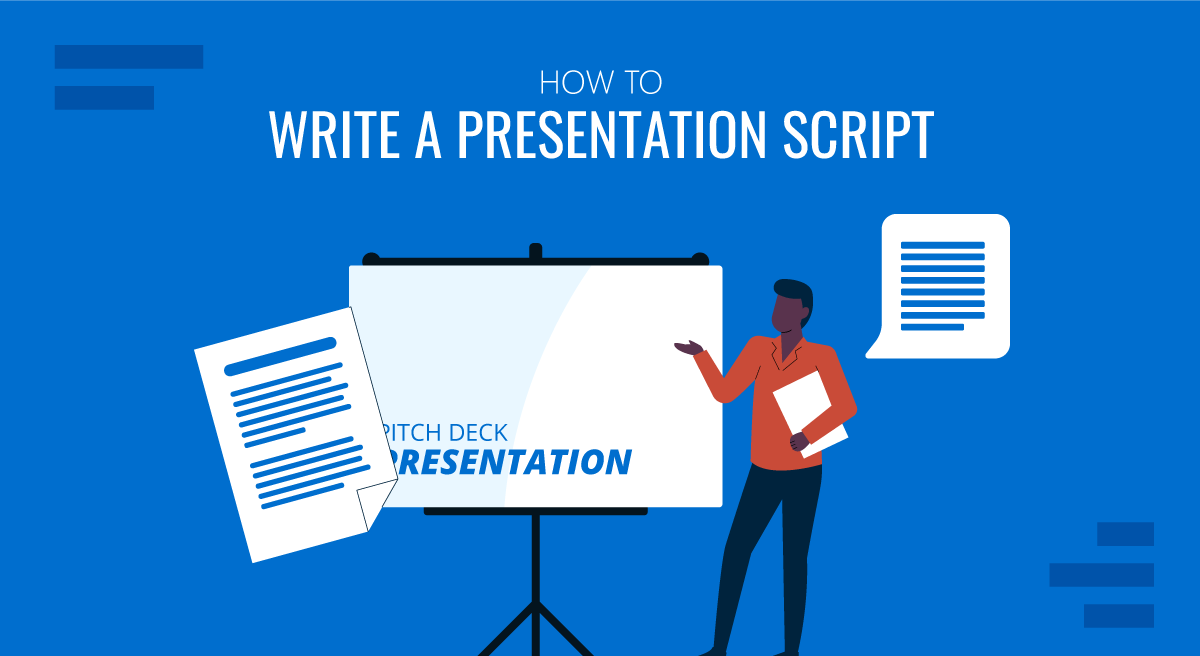
Delivering a successful presentation is a combination of a confident speech and professional-quality graphics. The first element is sometimes neglected, as presenters rely mostly on the slides and add an improvisation element to the speech. Truth is, if you aim to hone your presentation skills, you need to work on the speech. And for that to be a powerful asset, the answer is to learn how to write an effective presentation script.
This article will detail how to create a presentation script, which elements it should contain, how to relate the script to the presenter’s notes, and much more.
Table of Contents
What is a Presentation Script
How do you start a presentation script, how do you write a presentation script, how to connect a presentation script with presenter notes, recommended ppt templates to write a presentation script, final words.
A presentation script is a written guide that outlines what a speaker will say during a presentation. It includes the key points, transitions, and supporting details needed to communicate the message clearly and effectively. The script helps the speaker stay on track, ensuring the presentation is organized, concise, and delivered within the allotted time. It often integrates cues for visual aids and other presentation elements.
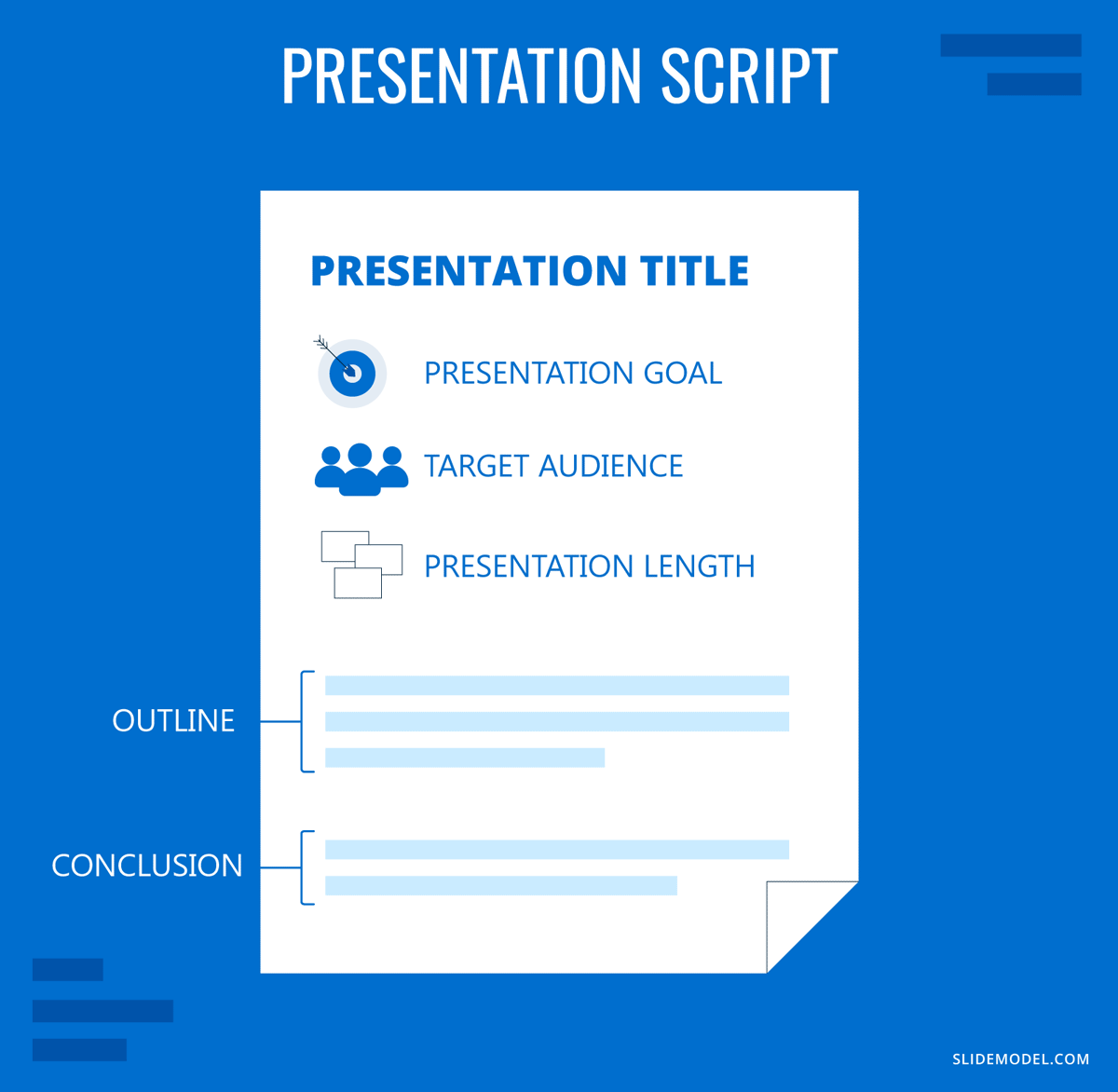
Defining the Purpose and Objective
Every effective presentation script starts with clearly understanding its purpose and objectives. Defining these elements early ensures your script remains focused, relevant, and aligned with your desired outcomes.
Your core message is the central idea you want your audience to take away from your presentation. It should be clear, concise, and memorable. To define your core message, ask yourself:
- What is the one thing I want my audience to remember?
- Why is this message important?
- How does this message benefit my audience?
Once you have a clear core message, everything in your script for a speech should support and reinforce it. This focus will help you avoid straying into irrelevant topics and ensure your presentation remains cohesive.
Next, the presenter should establish clear objectives for the talk. Objectives must be specific, measurable outcomes you want to achieve with your presentation. They give you a clear direction and help you measure the success of your presentation. Objectives can be:
- Informational: Educate the audience on a particular topic.
- Persuasive: Convince the audience to adopt a viewpoint or take a specific action.
- Motivational: Inspire the audience to feel or act in a certain way.
- Instructional: Teach the audience how to do something.
For example, suppose your core message is about the importance of cybersecurity. In that case, your objectives might include informing the audience about common threats, persuading them to adopt better security practices, and instructing them on implementing them.
Check our article on SMART goal setting for a practical approach to defining measurable goals.
Aligning the Script with Desired Outcomes
Once you’ve defined your core message and objectives, your script should be structured to achieve these outcomes. This involves:
- Prioritizing content: Focus on the information and arguments directly contributing to your objectives.
- Building logical flow: Ensure that each section of your presentation leads naturally to the next, creating a narrative that reinforces your core message.
- Incorporating calls to action: If your objective is to persuade or motivate, include clear, actionable steps your audience can take after the presentation.
By defining the purpose and objectives of your presentation script, you set the stage for a focused, effective, and impactful delivery.
In this section, we’ll explore section by section how to write a presentation script. The following image is a guideline of presentation script examples on how to create icebreakers for each section
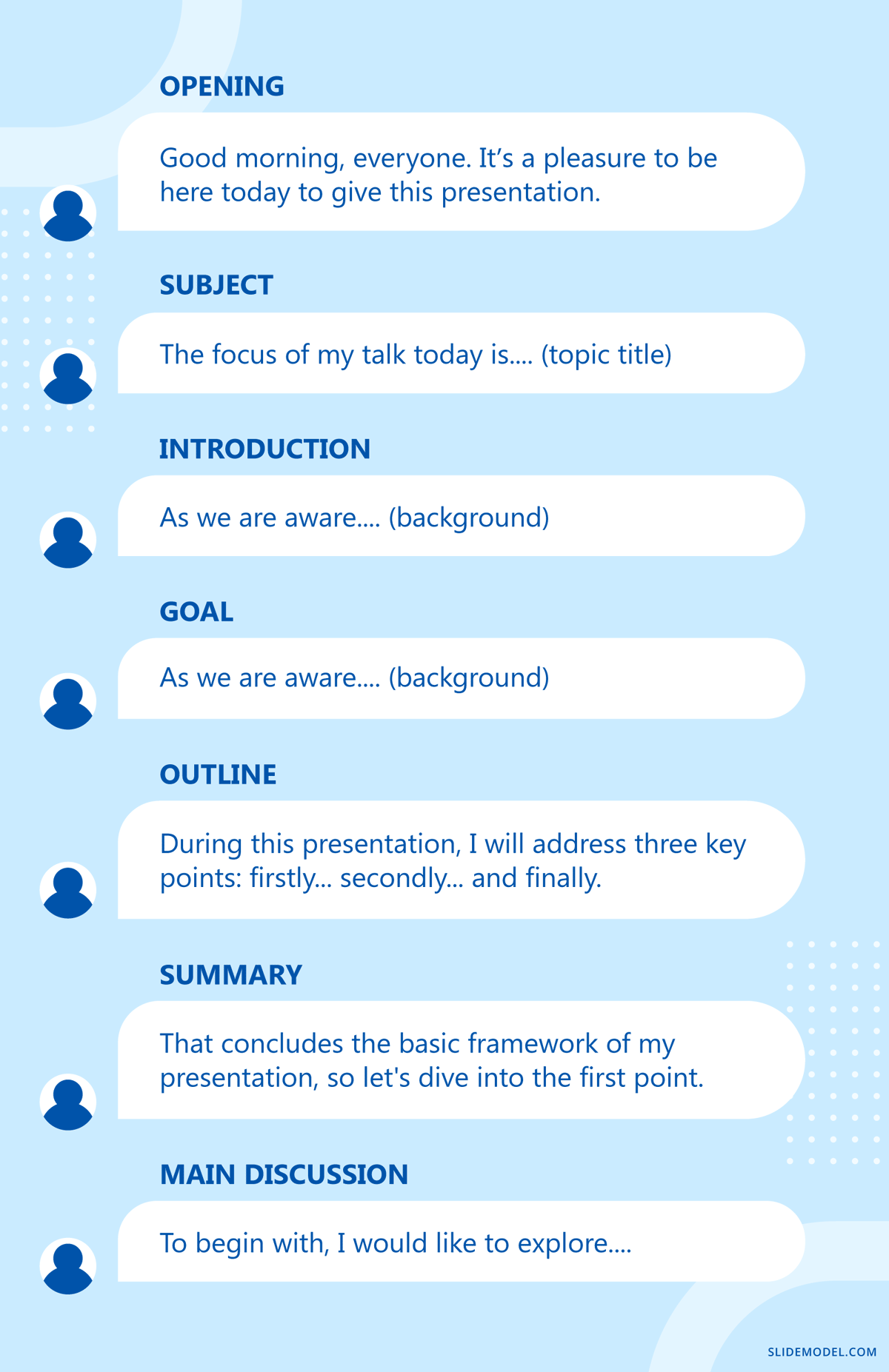
Crafting a Compelling Introduction
The introduction is your opportunity to capture the audience’s attention and set the tone for the rest of the presentation. It should be engaging and clearly overview what the audience can expect.
If you are wondering how to start a presentation , key elements of a strong introduction include:
- Opening hook: Start with a statement, question, or anecdote that grabs the audience’s attention. This could be a surprising statistic, a relevant quote, or a provocative question.
- Purpose statement: Clearly state the purpose of your presentation and what you hope to achieve. This helps the audience understand why they should care about your words.
- Agenda overview: Briefly outline the main points you will cover. This will give the audience a roadmap of what to expect and help them follow along.
Let’s say your presentation is about digital marketing trends. In that case, you might start with a surprising statistic about the growth of AI technology usage, followed by a statement about the importance of staying ahead of digital trends, and then outline the specific trends you will discuss in an upcoming slide.

Organizing the Body of the Script
The body of your script is where you present your main content. It should be organized logically, with each section building on the previous one to reinforce your core message.
Break down your content into clear, manageable sections. Each section should cover a specific point or idea. Smooth transitions between sections help maintain the flow of your presentation and keep the audience engaged . Phrases like “building on that idea,” “another important factor,” or “let’s now shift our focus to” can help guide the audience through your presentation.
Use data, examples, case studies , and visuals to support your points. This will strengthen your argument and make your presentation more engaging.
For instance, in a presentation about social media’s impact on consumer behavior, you might organize the body into sections on social media usage trends, the psychology of social media influence, and case studies of successful social media campaigns.

Engaging the Audience with Stories and Examples
One of the most effective ways to make your presentation engaging and relatable is by incorporating stories and examples. These elements help illustrate your points, making them more memorable and impactful.
Consider the following strategies:
- Use personal anecdotes: Sharing personal experiences related to your topic can help establish a connection with the audience and make your presentation more relatable.
- Include case studies: Real-world examples or case studies can help illustrate how the concepts you’re discussing apply in practice. This is especially effective when presenting to a business or professional audience.
- Tell a story: Structure part of your presentation as a narrative, with a clear beginning, middle, and end. Stories are inherently engaging and can make complex information more digestible.
You can learn more about this technique with our article on storytelling for presentations .
Developing a Memorable Conclusion
The conclusion is your final opportunity to reinforce your core message and leave a lasting impression on your audience.
A strong conclusion should:
- Summarize key points: Recap the main points of your presentation to reinforce them in the audience’s mind.
- Reiterate the core message: Restate your core message in a way that resonates with the audience and underscores its importance.
- End with impact: Conclude with a powerful statement, call to action, or thought-provoking question that leaves the audience with something to think about or do.
If your presentation was about the importance of innovation in business, you might conclude by summarizing its key benefits, restating that innovation is crucial for long-term success, and ending with a call to action for the audience to start thinking about how they can innovate in their roles.
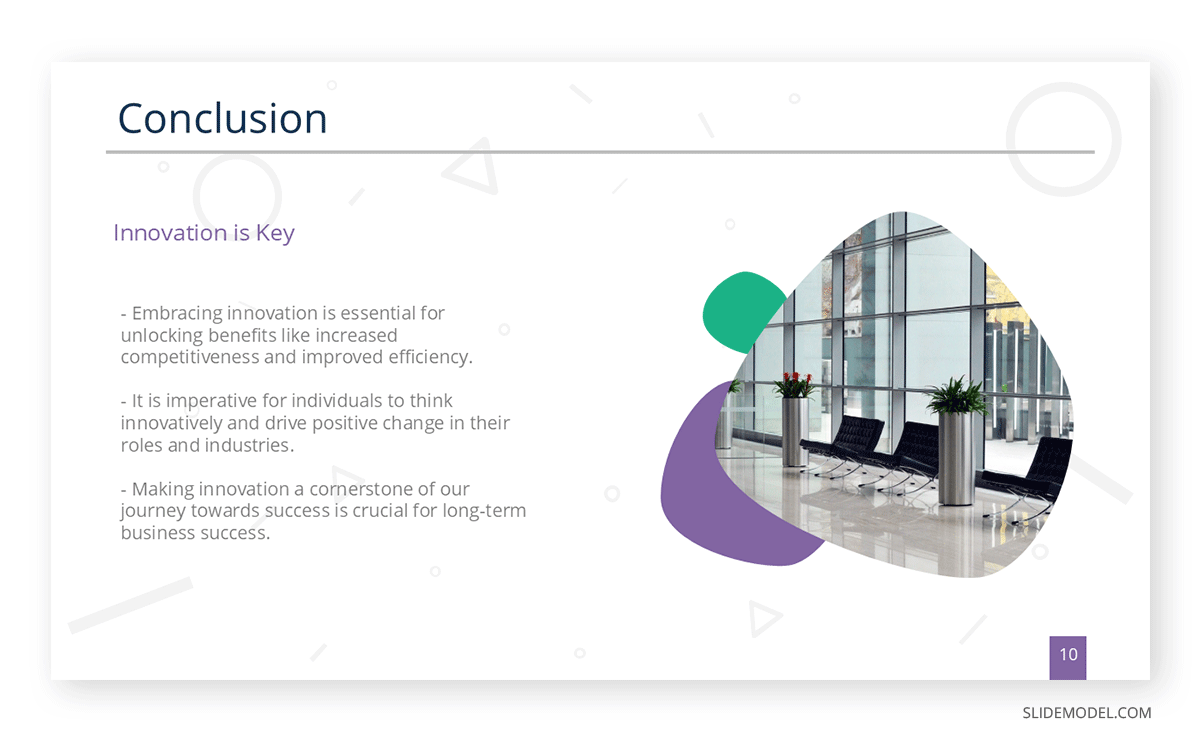
Get more insights on how to end a presentation with our article.
Although the presentation script is a fantastic resource for preparing your presentation and also for rehearsal, presenters cannot bring lengthy text pages with them and start reading if they feel lost. This is where presenter notes come in handy, and in this section, we’ll learn how to turn the presentation script into presenter notes.
The first step in this process is to go through the detailed script a couple of times, highlighting the main ideas, data, and messages to convey to the audience. You can follow the process as with meeting notes and apply the strategies explained in that article.
Now, we need to condense the information into simpler sentences, direct phrases, or keywords that trigger memory recall. These phrases will be added to the slides in the format of speaker notes linked to each slide. It’s crucial to mark the transitions from one topic to another in the presentation so we can articulate the speech or remember to emphasize a point.
Remember, if we suddenly need to include last-minute details, we can use visual cues or a printed version of our slides with extra handwritten notes.
Before we conclude this article, we want to recommend some PowerPoint templates that can help the presentation script creation process, especially for team collaboration, where the presentation goes through multiple iterations. Remember these designs also serve as Google Slides templates .
1. 6 Step Creative Timeline Diagram for Presentation Scripts
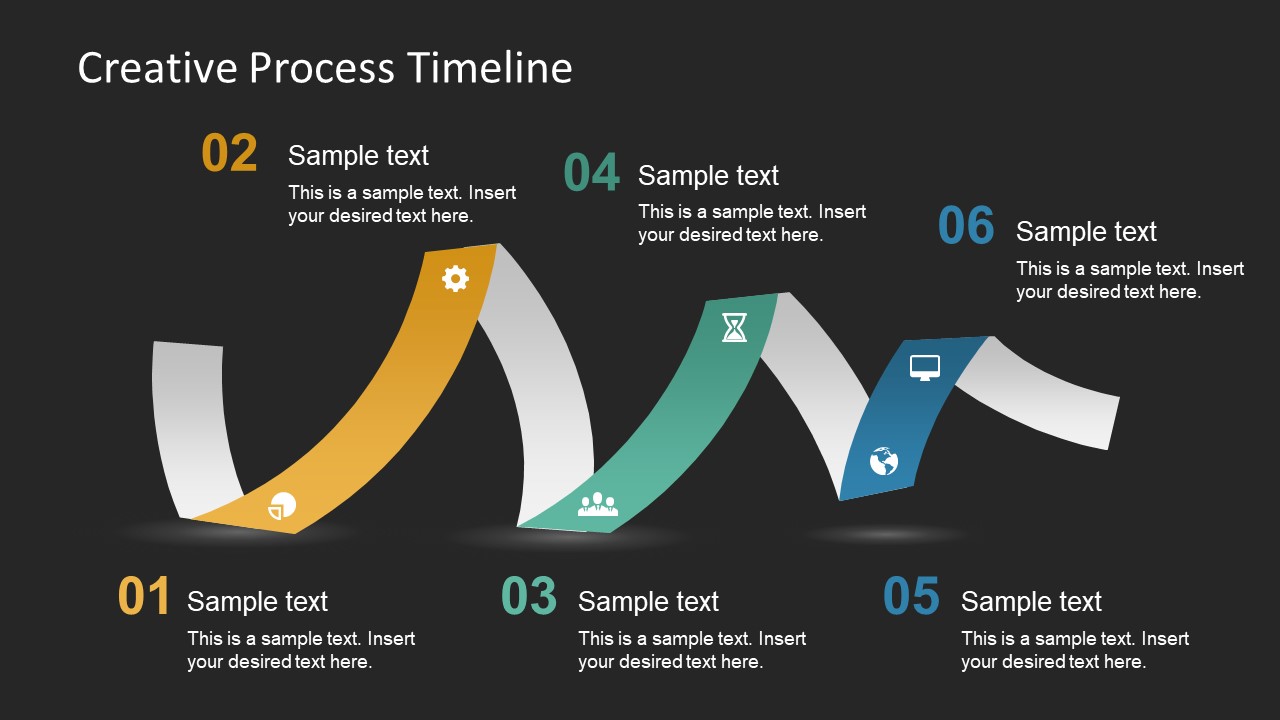
Say you need to create a sample script for a presentation or work with your team for a department presentation: this is where this best PPT template is beneficial. We can summarize processes or points that we intend the presentation to cover into six actionable steps that can be discussed within the team. The icons included help us to connect concepts with the steps we’re describing.
Use This Template
2. Product Timeline Script of Speech PPT Template

In sales and product presentations, we need to contextualize the dates on which we expect things to happen. By using this timeline PPT template as a visual aid, presenters can carry a printed version or digital version on another device to remind themselves of the milestones that a product or service is due in the near future.
3. The Presentation Experience Script PowerPoint Template
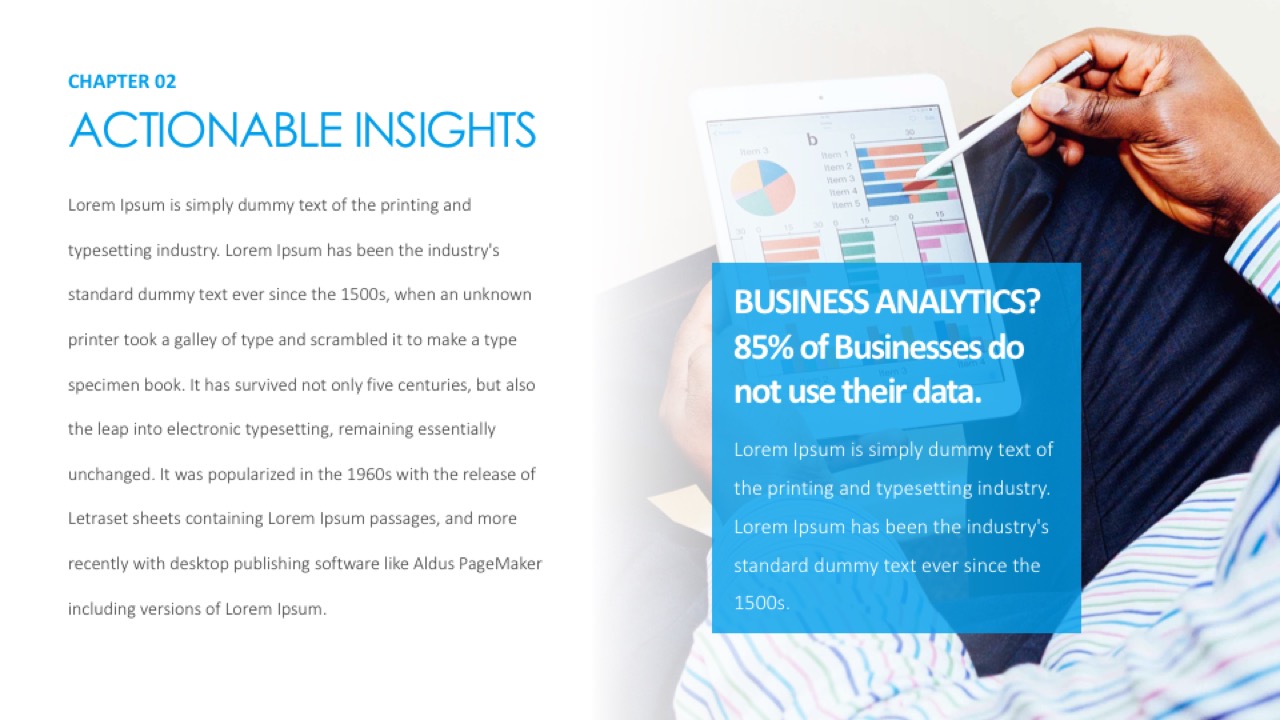
Although this template is tailored to sales presentations, this slide deck is ideal for writing a recap of the presentation script. You can add facts, questions, numeric data, and more.
4. Steps & Stairs Diagram Presentation Script Google Slides Template

This diagram template for PowerPoint and Google Slides is a highly visual 3D aid intended for defining the steps to write the script or to present processes. Use this staircase design template to summarize key information about your presentation speech.
Creating a detailed, professional presentation script doesn’t have to be a daunting process. As long as we understand the basis of how to structure what we intend to say, questions and answers about which content to include shall arise.
Follow the steps shown in this article and you will master the process to create your own presentation scripts in no time.
Like this article? Please share
Presentation Skills, Speech Filed under Presentation Ideas
Related Articles

Filed under Presentation Ideas • August 29th, 2024
How to Make a Presentation Longer: 7 Strategies to Master
Extend your talk in style. Join us to discover how to make a presentation longer while providing a high-end experience to your audience.
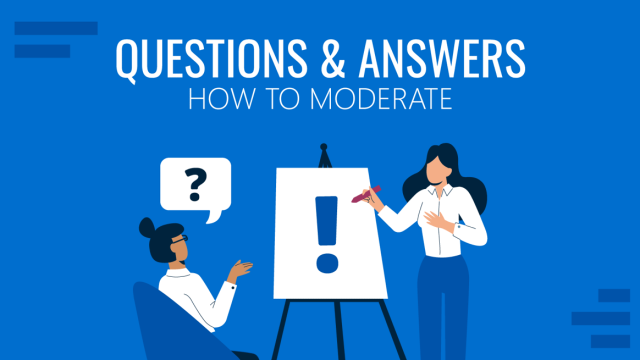
Filed under Business • August 7th, 2024
How to Moderate Question-and-Answer Sessions in Your Presentation
Reduce your anxiety over Q&A sessions by learning how to moderate this part of your presentations. A step-by-step guide.
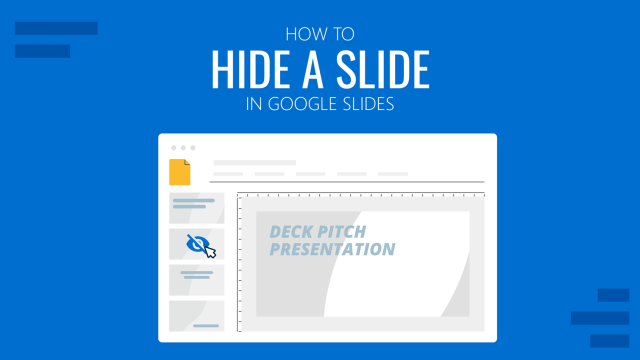
Filed under Google Slides Tutorials • July 25th, 2024
How to Hide a Slide in Google Slides
Hiding a slide in Google Slides is a task that takes less than a minute. Learn how to quickly implement this tool for your presentations in this article.
Leave a Reply

How to write a presentation script and practice your presentation the right way

Should you write a script for your presentation?
Should you practice your presentation?
The answer is yes and yes, but chances are neither of these are what you think they are.
Hear me out.
When I talk about a presentation script , most people assume I’m talking about a word for word document that must be memorized or read to the audience.
When I talk about practicing a presentation, most people assume I’m talking about:
(a) reading that script, word for word until it’s memorized, and
(b) practicing the entire presentation from start to finish, over and over again.
As a result, most people think scripting and practicing a presentation take a lot of extra time when working on a presentation.
None of that is true.
When done correctly, you script and practice your presentation in the same step AND most of it doesn’t even involve doing an extra step.
Good thing you found your way to my article, because today you’re going to learn how to write a presentation script and how to practice your presentation the right way.
Hi! 👋 I’m Dr. Echo Rivera and I train academics, scientists, and educators how to create engaging presentations. While you’re here, make sure you check out my FREE training on engaging presentations.
Before I share my unique scripting/practicing system, let’s make sure this blog post was written for you.
This blog post was made for academics, scientists, and educators.
The strategies shared in this post were tailored to presentations such as:
class lectures,
conference presentations,
teaching demos,
training workshops, and
In other words, this post is for you if your primary goal of the presentation is to educate the audience—not to sell a product or gain angel investors.
What you will learn in this article (or video):
1. why academics, scientists, and educators need to write a presentation script and practice their presentations., 2. myths about presentation scripts and practicing your presentations..
3. Why you should script and practice even if you’re good at public speaking.
4. How to write a presentation script and how to practice your presentation.
5. When does it make sense to do these script/practice types?
6. A bonus tip; something else that is important ;)
p.s. There is an abbreviated version of this blog post you can watch right here:
Take a moment to think about all the things you’ve witnessed during a presentation that made it unbearable to watch.
I don’t mean how bad their slides were or their wall of text slides, I mean things the presenter did or didn’t do.
Bonus points if you actually take a moment to write them down.
Ok, here’s my list.
A presentation becomes hard to watch when the speaker:
Goes over time
Sounds really awkward
Rambles and goes on tangents
Is confusing, disorganized & hard to follow
Doesn’t have a good flow or pace (too fast, too slow, no pauses)
Forgets what they wanted to say
Reads the slides to the audience
Speaks in a monotone, droning voice
Finishes waaaaaaaay too early
I’m guessing you agree that these are signs that the presenter needs a boost in their public speaking skills.
If you see yourself in that list, don’t worry because the strategies in this post will 100% help you address these challenges. People aren’t born with these skills—they develop them over time, with training and practice.
Also, I’ve made every single mistake on that list. I used to have an intense fear of public speaking. So, I understand your struggles , and I can help!
If you don’t see yourself on this list, keep reading because these strategies will still help you in surprising ways. I wrote a special section just for people who are great at public speaking.
Ok. By now, my key point here is probably obvious.
Scripting and practicing (the right way) tackle some of the biggest problems we see during an ineffective presentation.
You might be thinking: “ Well, yeah, that’s obvious, Echo. ”
Because I’ve found that academics, scientists, and educators avoid writing a script for their presentation and practicing like it’s an unnecessary committee meeting.
I get why they avoid it—it’s because of some insidious myths about scripting and practicing that most people believe.
Let’s tackle those next.
If writing a presentation script and practicing a presentation were such good strategies, why don’t more people do it?
That’s easy: most people believe harmful myths about presentation scripts and practicing.
I already busted a couple in the introduction: most people assume “script” and “practice” mean certain things, but that’s wrong.
As a quick refresher:
MYTH: When people say you need a script and need to practice, they want you to memorize your presentation
Well, other people might mean that, but I don’t.
In the process I explain later, the goal is not to memorize your presentation speech.
Stay tuned :)
MYTH: Practicing a presentation means you need to say the entire presentation from start to finish
That’s one way to practice a presentation. I call it the dress rehearsal.
I almost never do it, and I recommend you avoid this type of practicing at all costs.
You’re going to learn three other ways to practice that are easier, more sustainable, and more effective.
MYTH: There’s an easier way to solve bad speaker habits
The #1 worst piece of presentation advice that exists is that you should use 1 slide per minute, or as few slides as possible.
Without question, it’s the worst.
You cannot make an engaging presentation if you follow that rule. And if that surprises you then please take my free training ASAP.
I’m constantly talking about this piece of bad advice on social media with academics, scientists, and educators.
The main reason people give me for following this rule boils down to this:
“You see, Echo, the 1 slide per minute rule is helpful to make sure speakers don’t go over time.”
And my reaction boils down to this:

Because…people have been following the 1 slide per minute rule for a really long time and we still have to endure presenters who go over their time.
The number of slides has nothing to do with a presenter who goes overtime.
There is only ONE reason speakers go overtime.
They don’t script and practice their presentation at all, or in the right way.
Surface level formulas like “1 slide per minute” don’t fix the problem and they only make presentations worse.
MYTH: If you practice too much, you’ll sound like a robot
Have you ever believed that you could practice “too much” and that practicing “too much” will make you sound like a robot?
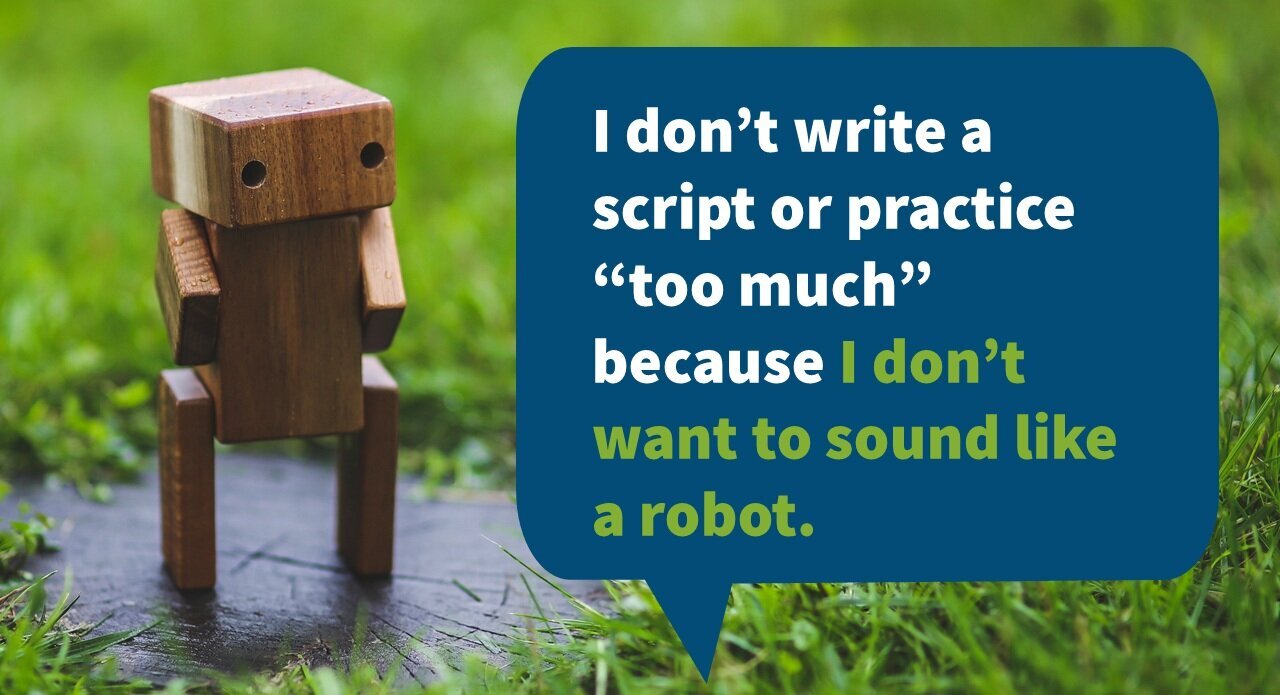
Absolute nonsense.
This makes no sense if you think about it.
Have you ever seen a musical or play?
Does that feel like a bunch of robots singing and dancing on the stage?
No, of course not. It feels moving, natural, and engaging.
Well, they obviously practice A LOT.
So, that instantly debunks the myth that if you practice, you'll sound awkward or like a robot.

In reality, it's the exact opposite.
Having a script and practicing it in the right way is precisely what helps you sound natural, professional, and deliver a smooth presentation that makes an impact.
I know what you’re thinking.
You’re thinking… ”But I can always tell when someone reads from a script. They sound so awkward!”
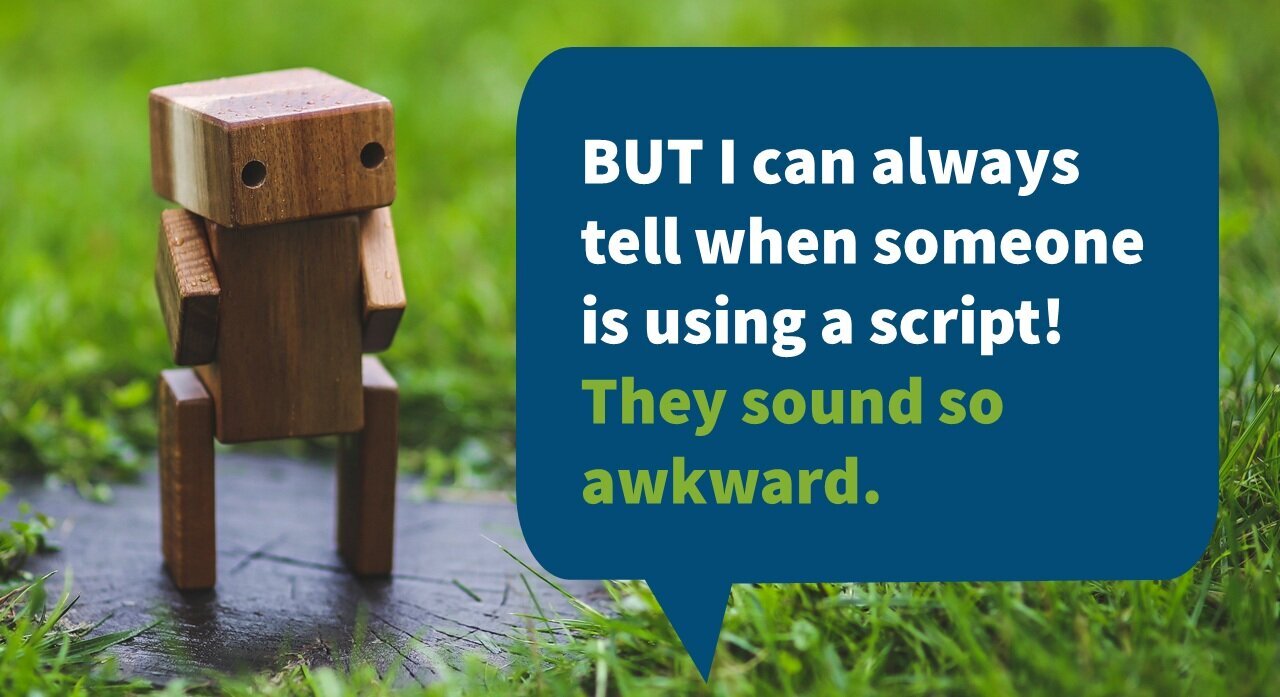
Hmmm…I have questions.
First: How do you know they’re reading a script?
If you don’t actually see them reading from a script, you cannot assume that’s what they’re doing.
If the speaker is really awkward and sounds like they’re reading, that’s not enough evidence to conclude they are using a script.
Second: OK. Let’s assume they ARE using a script.
The problem is not that they have a script.
The problem is:
(a) how they wrote the script initially, and/or
(b) how they practiced their script.
Chances are they (a) wrote a presentation speech using a Word document, and then (b) tried to memorize it.
This is a bad approach because when we write in a Word document, we’re writing for written communication.
By default, everything we type will be more appropriate for someone to read it, rather than to listen to it.
That’s why in my system, we don’t use Word at all, and you do NOT start by writing a speech.
Or, they (a) wrote their presentation script in the notes section of PowerPoint, and then (b) just read it silently in their mind as a way to practice it.
We’ve all done this. Admit it.
That’s NOT how you should write a script or practice your presentation.
That’s how you end up sounding like a robot, because in reality you haven’t practiced your presentation at all.
This is a really important point to internalize: reading your notes does NOT count as practicing your presentation.
I can guarantee 100% that you’ve been enamored by a presenter using a script who sounded natural, engaging, and amazing.
When done properly, you actually can’t tell there was a script.
If somebody has an awkward delivery where it sounds like they're a robot and they're relying on their script too much, the problem is NOT that they had a script.
The problem is NOT that they practice too much: it's the opposite. The problem is that they didn't practice enough and didn't practice in the right ways.
It is entirely untrue that the more you practice, the less natural you will sound. That is a lie.
And I am not the only one who is saying this.
Fun fact time!
Have you ever seen The Big Lebowski?
Hopefully, that's not too old of a reference, and I know there are some problems with the movie.
But even if you hate the movie or haven’t seen it, it has a reputation as having an extraordinarily smooth delivery by the actors.
It feels so real, so natural, that many people assume it was improv.
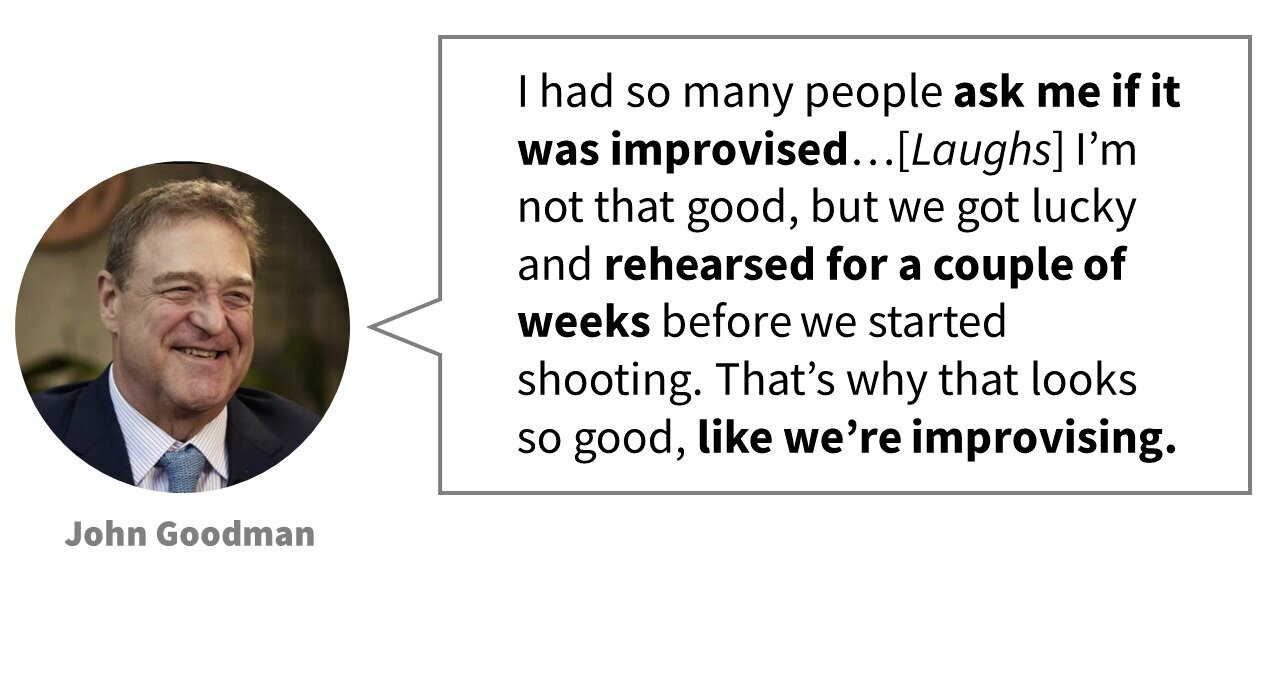
The reason it felt so natural and so smooth, was because the script was good (in the sense that it felt like real conversations), AND because they practiced it for weeks.
In a 2012 Rolling Stone interview, John Goodman said, “I had so many people ask me if it was improvised.” Then he laughed his John Goodman laugh and said, “I'm not that good. But we got lucky and we rehearsed for a couple weeks before we started shooting. That's why that looks so good. Like we're improvising.”
This is exactly the point that I'm trying to make.
LIKE we’re improvising, he said.
They rehearsed it so much that it looked good and seemed like they were doing improv, which is basically a way of saying it felt natural. It felt real.
A great presentation script is worthless if you don’t practice it correctly, and practicing your presentation doesn’t help if you don’t have a good script. 🤯
That’s why I merge the two activities into one activity when working on my presentation.
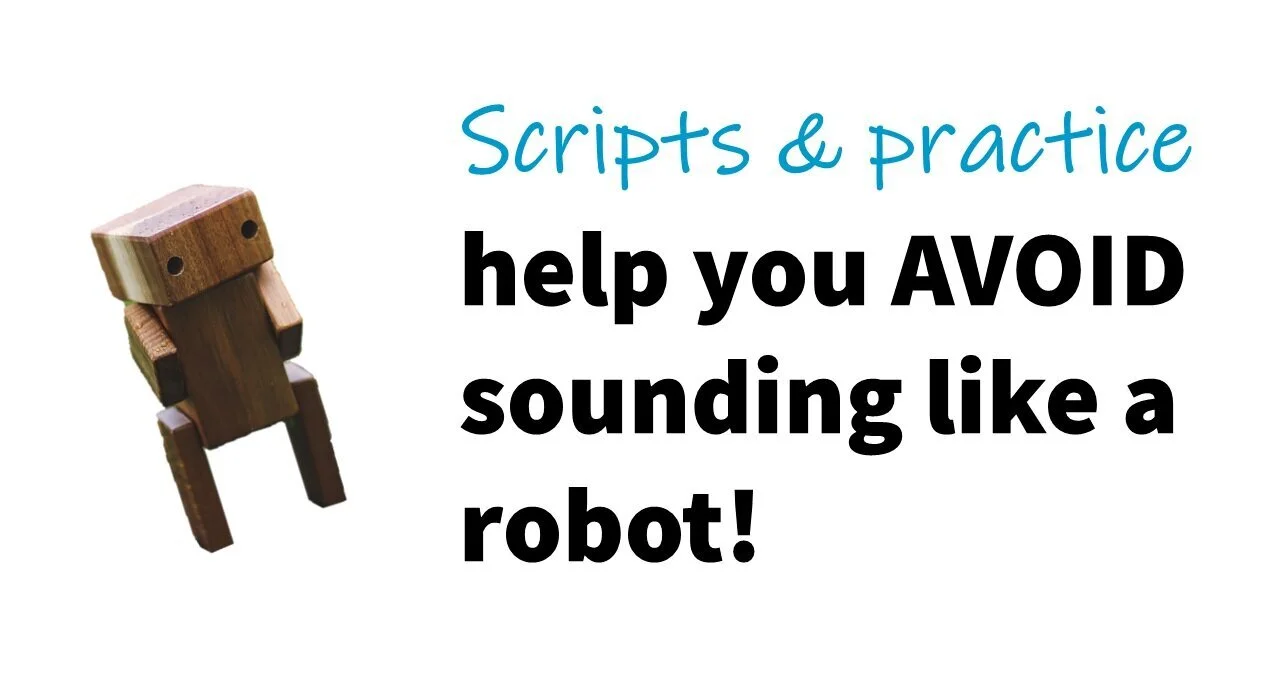
That’s the power of a good script , and practicing it the right way.
Luckily, academics, scientists, and educators don't need a perfect script and don't need to practice nearly as much as people performing in a musical or in a movie. 😅
Hopefully, you’re ready to give scripting and practicing your presentation a chance.
Except, wait.
You might not be convinced if you’re good at public speaking.
I promised a section just for you, so here it is.
3. Why you should a presentation script and practice even if you’re good at public speaking.
Remember earlier when I said this post would still be helpful, even if you didn’t see yourself in that list of bad presentation examples?
Let’s talk about that.
I’m guessing you think you don’t need to script and practice because you’re good at public speaking.
Maybe you’re the lucky type who can get on stage and just talk. And talk. And talk.
Maybe you love public speaking, and with just a few bullet points, you can talk for a full hour (or longer) without taking a break.
I can see why you think having a script and practicing it will totally slow your roll.
But here’s the bad news: the type of presentations where the speaker just gets on the stage and “wings it” are some of the hardest presentations to follow along with. 😬
Your energy, passion, and fast-talking ability probably keeps people paying attention, sure.
But they’re also probably really confused and overwhelmed.
Or, worse, they don’t think they’re confused during your presentation, but then later on when they try to remember what you said, they can’t—and they don’t even know why.
I have personally experienced this countless times as an audience member. And it’s something I pay attention to as a presentation specialist.
Several academics I work with recently realized their off-the-cuff, fast-paced class lectures were actually really confusing because they had to record them for an online course.
Once they actually had to watch their own presentation videos, they realized that they:
Did not build in enough repetition to enhance learning
Went on too many unhelpful tangents
Forget key transition statements or sections that link topics
Missed important key steps or connector topics
Did not have distinct sections in their presentations
Now you’re ready for the real secret:
The #1 reason you should have a script and practice it isn’t so you have a smooth delivery—it’s so your presentation is organized, comprehensive, and easy to follow. 💡
Time to finally reveal my unique approach to scripting and practicing your presentation!
I’m going to share my system for scripting and practicing that has:
Saved me TONS of time
Significantly improved the quality of my presentation content
Significantly improved my public speaking skills
I'm going to share the exact process I use to script and practice my professional presentations, even ones with data.
After all this build-up, I think you'll be pleasantly surprised at how easy it’s going to be.
One reason I think you’ll like this is because it’s efficient.
Like I mentioned above, a script needs to be practiced and you need to practice with a good script.
That’s why scripting and practicing are merged into one, seamless step.
Scripting is practicing. And practicing is scripting.
The 4 types of presentation scripting & practicing:
Talk to your computer
Mini bursts of practice
Timed practice
Dress rehearsal
Before I go into detail, make sure you download the FREE worksheets that go along with this blog post and video!
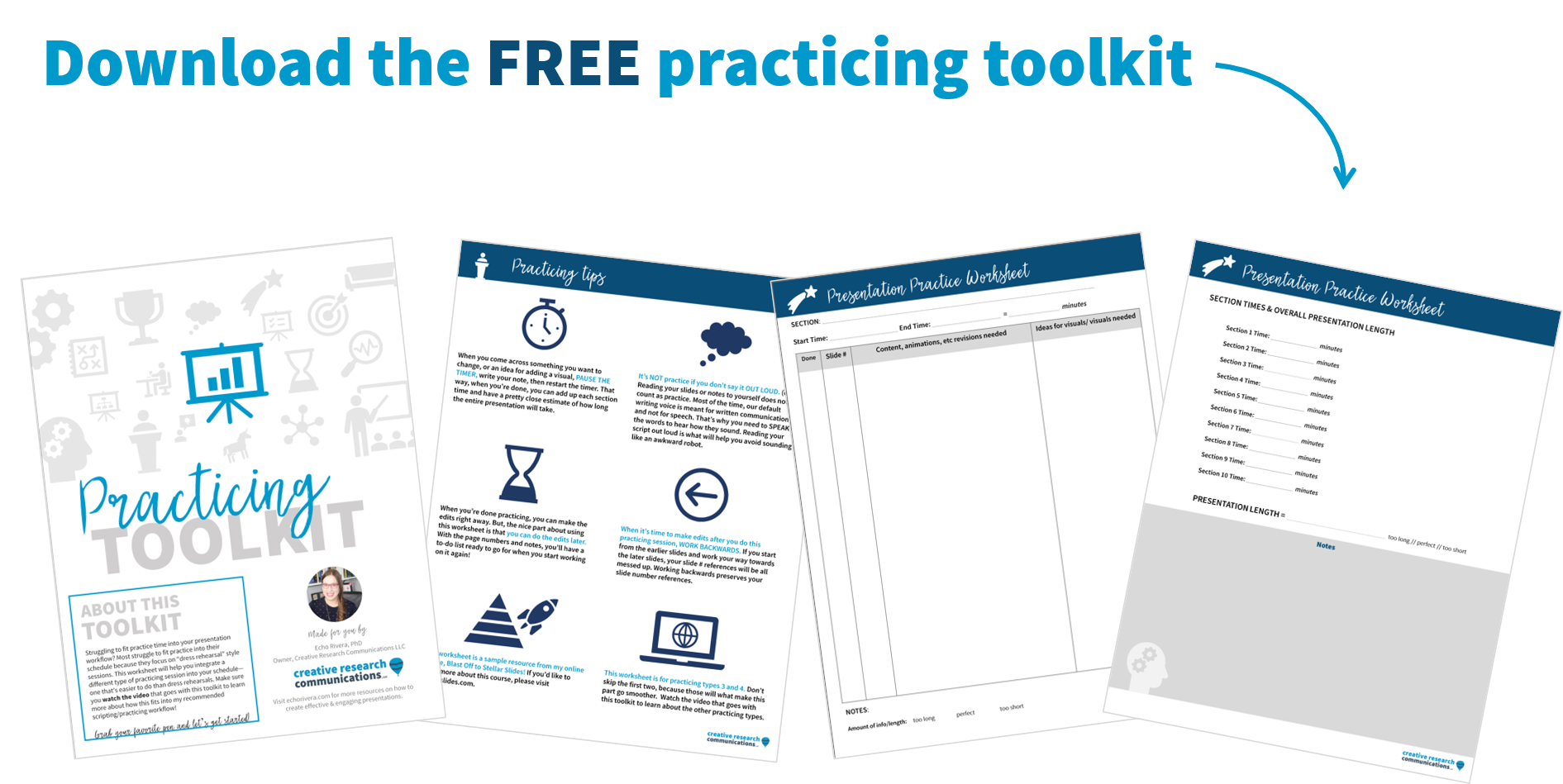
Script/Practice Type #1: Talk (or Whisper) to Your Computer
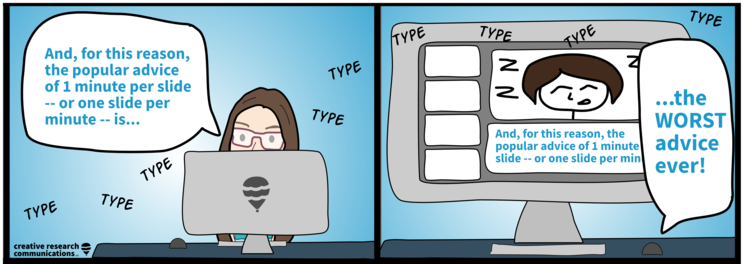
The first thing I need to eliminate from your mind is the idea that you can practice by sitting and staring at your slides or reading them silently in your head.
That does not count as practice. You have to actually say your notes out loud for it to count as practice.
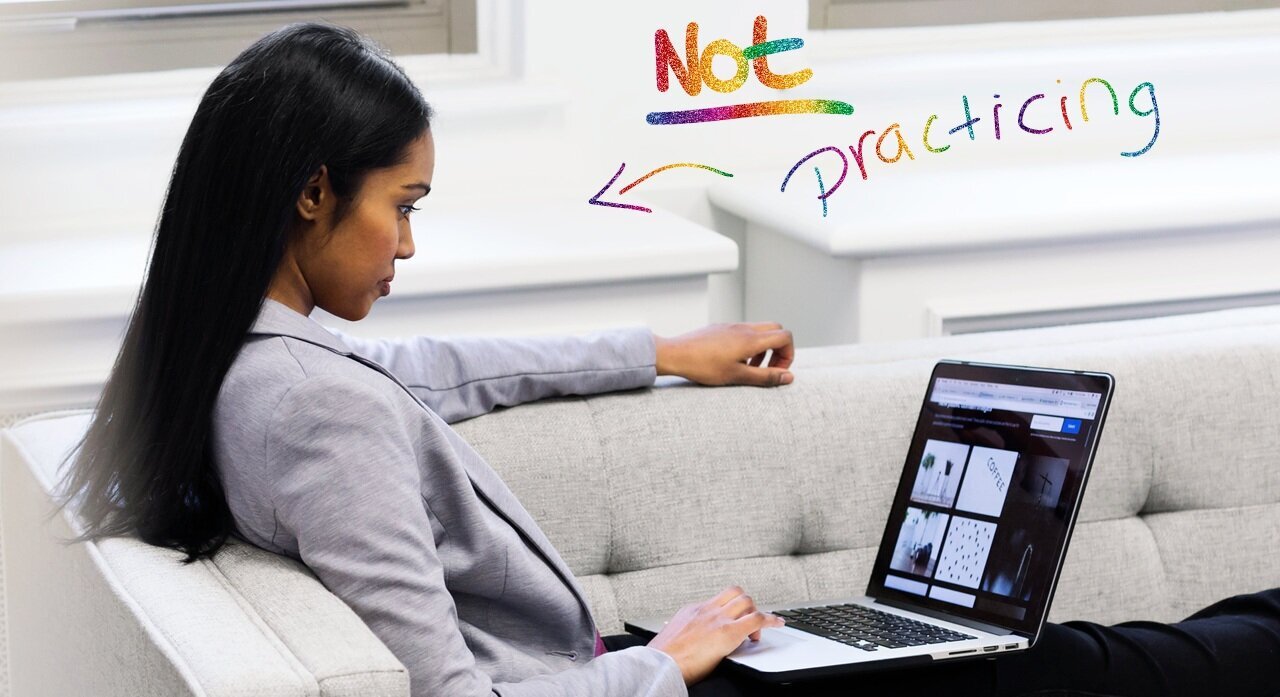
Like I mentioned earlier, we aren’t going to use Word or any type of word processor for this. Do this directly in the notes section of PowerPoint (or Google Slides, Keynote, etc).
What you do, is from the very first time you start writing out your script, you also practice it as the same time.
Specifically, you’re going to talk (or whisper) to your computer—you’re going to say the words you type for your script as you’re typing it.
Or, if you’re revising your script for a presentation you’ve already given, you speak (or whisper) out loud while revising.

Does this sound weird?
Absolutely.
This is the most mind-blowingly impactful change you will ever make when creating a script for your presentation.
This is such a great strategy because you'll be speaking your script the very first time that you write it.
That means the first draft of your script will be better than if you just wrote it silently.
🚨 Re-read that sentence.
You will know immediately when you write something that sounds awkward, because you’re speaking it from step 1.
Do you see how much time that’s going to save you?
If you write your script silently in your head first, you’re going to write a script for reading—not speaking.
That means, the first time you do say it out loud, you will have to make more revisions than if you had just said it out loud in the first place.
If you’ve ever felt like it takes too long to create an engaging presentation, I just shared one of the BEST secrets to speeding up this process.
Besides, this is the best way to make sure you don’t sound like a robot.
So this practice type is something I want you to turn into your new habit.
Literally every single time you write something new for your presentation script (or make a revision), I want you to say (or whisper) it out loud.
Script/Practice Type #2: Mini bursts of real-time practice
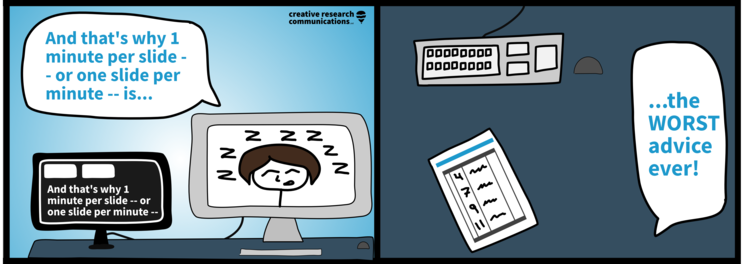
The second type of practice is what I call “mini bursts” of practice.
While you’re drafting and revising your slides (using script/practice type #1), at some point you’re going to finish a few slides or a section that you want to test out.
So, you’re going to do just that: a mini-burst of practice.
While still at you’re desk, you’ll go into presenter mode.
Once you're in presenter mode, run through a couple of slides or maybe even a whole section, and basically just fix problems as you see them.
You're basically piloting your slides in small chunks.
You can do this as often as you want, and the more you do it, the better.
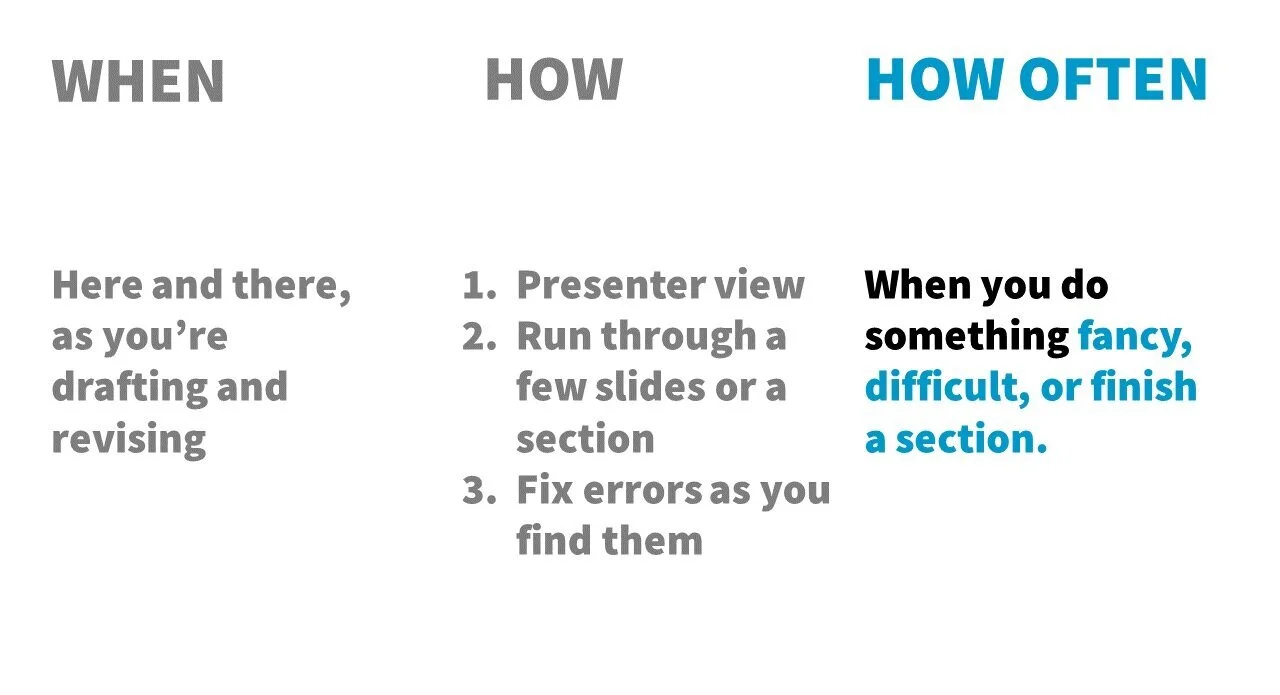
My guess is you were already doing some version of this, so I doubt this will take you extra time.
But, in the past, you probably just clicked and looked at your slides, and imagined what you would say in your head.
What I want you to do, moving forward, is actually say your script out loud.
What you should pay attention to is how your speech matches up with what is happening on your slides (the images, animations, etc).
In other words, also gives you another chance to speak your notes out loud while also testing the things happening on your slides.
Like practice type #1, you don't really need to dedicate a separate or unique block of time for this, because the idea is you just weave it into your practice of editing and revising your slides.
Script/Practice Type #3: Timed Practice
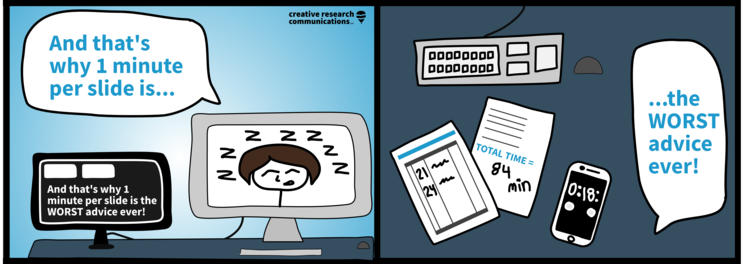
Like you, I found dress rehearsals to be exhausting and difficult to fit into my schedule.
Plus, when I had a lot of things to fix throughout the presentation, it was hard to keep track of those and remember them for later.
But, if I stopped my presentation to take notes, it ruined my flow or messed up my time tracking.
There had to be a better way, I thought to myself.
And after some experimenting, I found one!
I call this the “timed practice” and like script/practice type #1 it was a gamechanger.
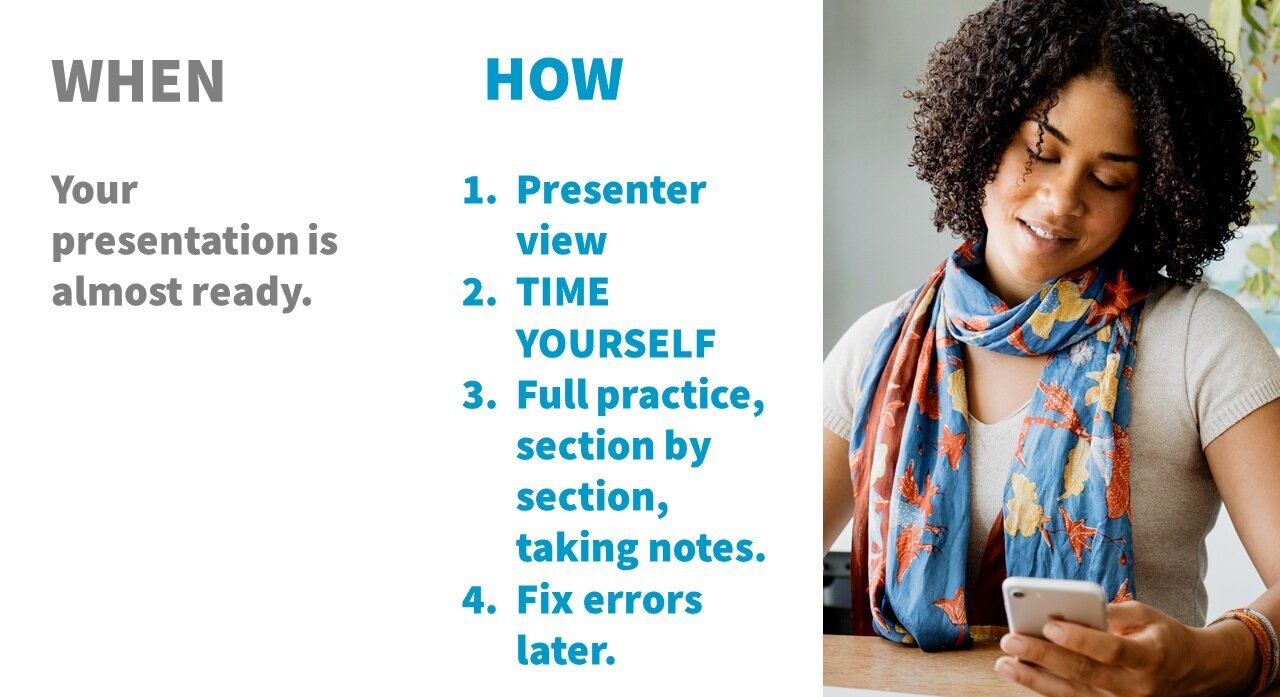
You will do this when your presentation is almost ready and you feel good about your draft.
What you do is grab a stopwatch (I use the clock app on my phone) and some specially designed worksheets for you to complete.
The worksheets should have a place for you to write:
Section Name
Description
Images needed
And other information you need to revise your presentation.
You can get the exact worksheets I use for this in the free download that goes with this post:

Make sure you have several of these practicing worksheets printed and ready to go (at least one sheet per section).
If your presentation doesn’t have sections, then that means it’s probably confusing for your audience. Make sure you check out my FREE training if you’re interested in improving all aspects of your presentations.
Here’s the step-by-step process:
Grab a worksheet.
Go into presenter view
Choose ONE section of your presentation
Start your timer
Do a full dress rehearsal style practice session for that ONE SESSION
When you come across something that needs to change, PAUSE THE TIMER and write your notes (the slide # and what needs to change).
When you’re done writing your notes, restart the timer and continue your practice.
When you’re done practicing that section, write down how long it took for you to complete that section and other notes to help you revise your slides.
Repeat for all sections.
Ideally, if your presentation is longer than 15-20 minutes, you’re engaging the audience throughout (not just waiting for a Q&A session).
That can be really hard to time, though, so here’s what I do:
When I come to my audience engagement slide, or have a question for the audience in my notes, I pause the timer,
I take moment to guess at how long I want to spend on this activity, and
I’ll add a note that looks like “+1 min for poll” and “+2 min for question”
Is it perfect, no? But it helps me remember to leave a time buffer for audience engagement.
When I'm done I add up all the sections and it will tell you how long the total presentation would probably take based on that run-through.
Then you go back and do this entire process one more time after you've fixed those major errors. Then hopefully it's good to go.
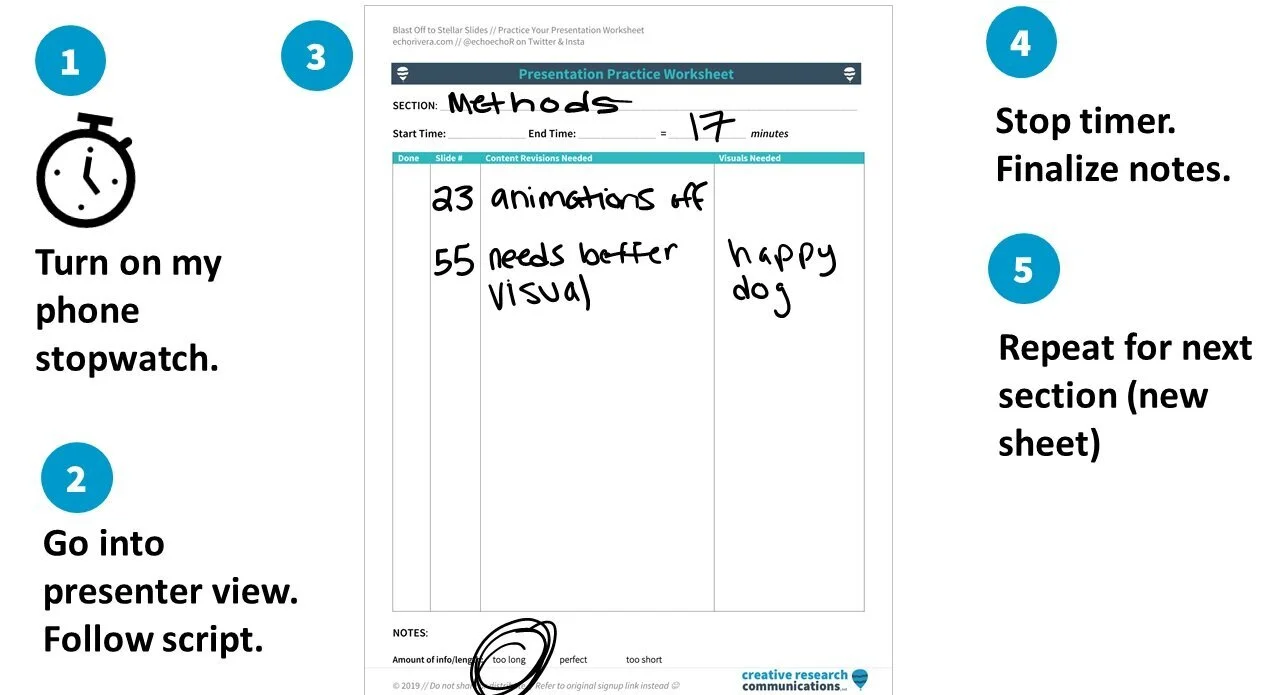
Here are some additional tips to make this as effective as possible.
1. Start going a little bit off-script now
By now, you already have a pretty decent script for your presentation.
The idea is NOT to memorize it at this point.
You have a solid foundation for an organized presentation that is easy to follow and contains no excess information, and does not leave important information out.
At this point, then, you should start going a little off-script.
Basically, you want to practice saying the same idea—the same content—but with slightly different words.
The goal is to know the general idea of what you want to say, when you want to say it, and how long you take to explain it.
2. Don’t do it all in one day
I don’t revise my slides on the same day I do a timed practice.
What I do is try to complete this entire process for all sections in 1-2 days, and then revise my slides on a later day.
While practicing, between each section I'll take a break, and I recommend you do that too. Stand up, stretch, get a glass of water.
When I’m done practicing all sections of my presentation, I set my notes aside and intentionally make myself wait at least a day before making any changes.
Having that mental break is really important, and gives your brain some downtime to come up with new ideas and insights.
It’s also a way for this to feel like a sustainable practice. It would be mentally exhausting to do this all in one day. Ugh.
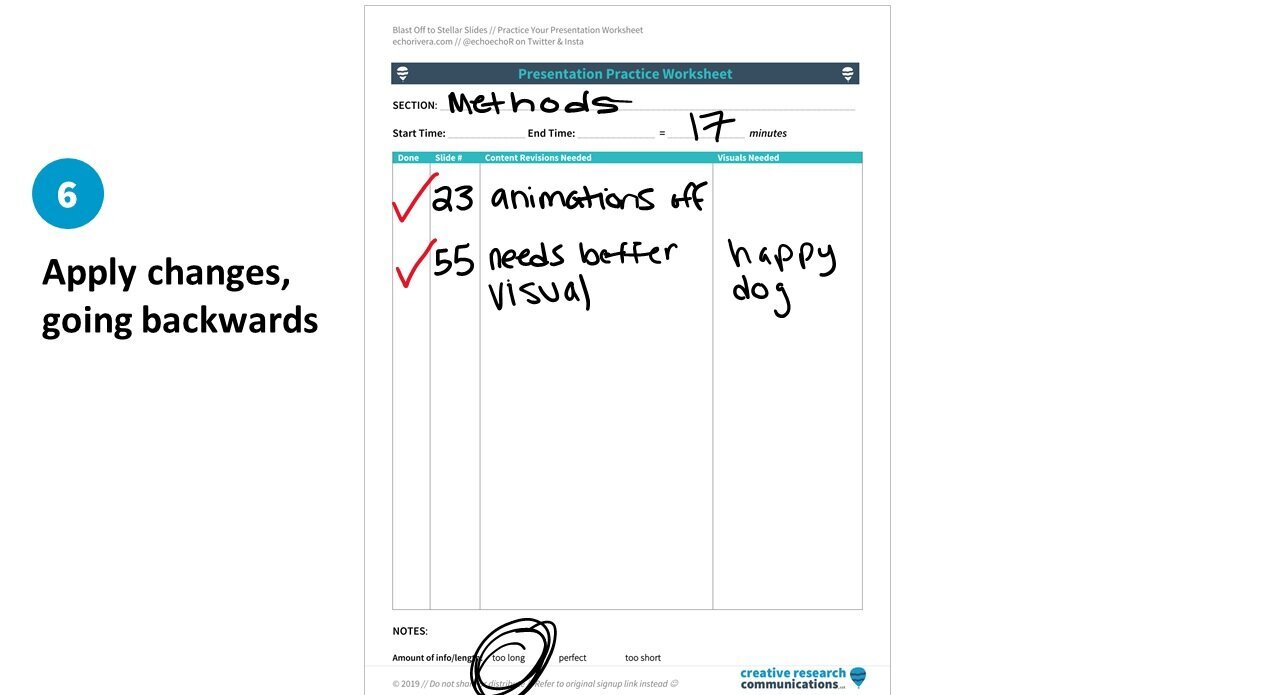
When you’re ready to apply the changes make sure you work backwards.
Start with the last one and work your way up, because if you start from the first slide and work your way down you're going to mess up all your slide number references.
3. You should only have to do this process 1-2 times
If you find yourself stuck here and you’re doing this a lot more than 1-2 times, then it’s probably because you didn’t do enough of practice types 1 and 2. Next time, do more of that and then you’ll need to do this type less.
This practice type is so helpful because:
It’s more efficient than a full dress rehearsal.
You don’t need a giant block off time to do it, only enough time to practice ONE section.
You don’t have to worry about remembering what to change. You can come back to your revisions another day .
You get an accurate sense of how long each section will take, which means you get an accurate sense of how long your entire presentation will take, too!
Most people skip this and go straight to the full dress rehearsal, but I think that's kind of a waste of time.
This is more efficient, easier to fit into your schedule, and still can give you a sense of how long your presentation will take.
Script/Practice Type #4: Dress rehearsal

Okay it’s time to talk about the dress rehearsal.
This is what most people think of when I say “practice your presentation.”
A full dress rehearsal involves acting as though you’re giving the presentation for real. That means you do things like:
Do the entire presentation from start to finish, without stopping
Add in all your dramatic pauses
Avoid looking at your notes while giving your talk
Use all your normal gestures
First, I want to emphasize that if you follow the first three practice types, you will rarely have to do a dress rehearsal.
Practice types 1-3 are usually enough for things like course lectures, webinars, and regular conference presentations.
I mean, you can do a dress rehearsal if you want. It’s not a bad idea. But in my opinion, it’s optional for most presentations.
When should you do a full dress rehearsal? When your presentation is a:
Teaching demo
Other very high stakes presentations (e.g., presentation to obtain funding)
So if you need to do one, then let me share some strategies for this.

You do the dress rehearsal when your presentation is pretty much ready and you just need to work on the delivery and want to make sure you can do this presentation without your notes.
You’ve already practiced this in short bursts 1-2 times with the last strategy, so you’ll be in a good place to do this.
If it’s an in-person presentation, then I recommend you don’t do this at your desk.
Get in a new environment, plug your laptop into your TV, present this to your pets or friendly faces, or find an empty room in your department and practice there.
Make it as close to the real thing as you possibly can.
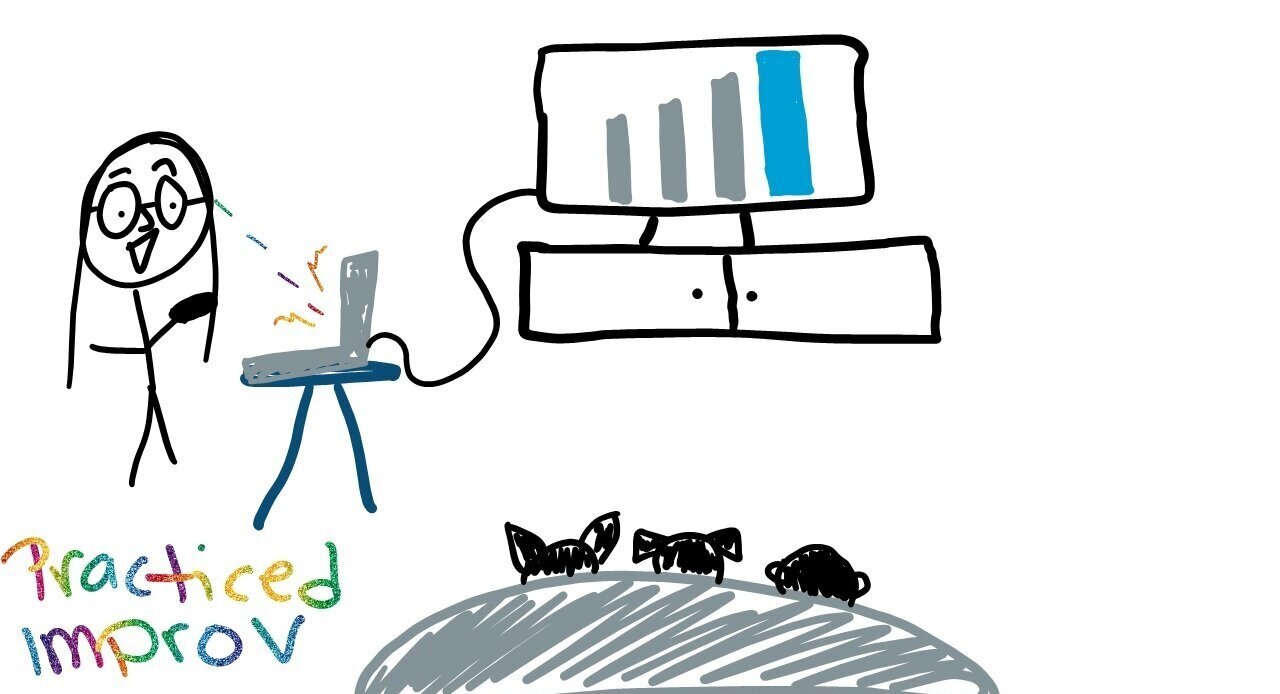
When I do this type of practice I get set up in my living room so I can project my slides via the TV.
I put my laptop on a tray table, I hook it up to the TV with an HDMI cable, and I get my friendly audience sitting on the couch (for me that involves two dogs and a human).
I've got my slide clicker ready because I'm going to use it for the real thing (and if you do not have one of these, Oh my god, get one now. They are awesome!).
I position everything so I can see my presenter view and the notes if I need to. But I'm facing the audience just like in real life and I'm trying to not read my script at this point.
That is my process, and you might need to tweak it based on your own setup, but the important thing is to get out of your office.
Try to go somewhere else and don't do it in your office.
Bonus Tip: Consider doing things like practice rushing into a room (or Zoom) in your department and setting up in less than a minute, then rush into your presentation because that can happen in real life.
Remember: Memorization is not the primary goal.
You can memorize your presentation if you want to, but you do not have to.
And please, keep in mind that memorization can backfire.
In some cases, it’s better to practice in a way that goes a little off-script.
By now, especially since you've done those three practice types, you should be really comfortable with your presentation and have an idea of what you want to say, when you want to say it, and about how long you want to take with each slide.
You can (and should) change words here and there.
You can add a sentence or maybe not say a sentence.
You can do that type of “practiced improv” and then your script is really only there as a backup in case you do sort of blank and forget what you wanted to say.
You can still use the worksheets from practice type #3.
You’ll be in presenter view again, and you’ll time it.
I recommend that you use those practice sheets again, using them the same way as in practice type three so you can pause and take notes on what you might need to fix.
Hopefully, by now it's not a lot of stuff, just minor tweaks.
5. When does it make sense to do these script/practice presentation types?
New presentation content or delivery format.
If this presentation is:
Brand new content
Getting a significant revision or overhaul
Relatively new content (you’ve only given this talk 1-2 times before), and/or
Going to be presented in a new delivery format (e.g., used to be in-person, now it’s a webinar)
…then you should definitely do:
Script/Practice Type #1: Talk to your computer
Script/Practice Type #2: Mini bursts
Script/Practice Type #3: Timed practice
…and if it’s a “high stakes” presentation (job talk, teaching demo, keynote), then also do:
Presentation you’re revising or updating
One you’ve given in the past
Getting a minor revision
Going to be presented in the same delivery format as before
Script/Practice Type #1: Talk to your computer while revising
Script/Practice Type #2: Mini bursts of the sections you revised
…and if you want to be sure your changes didn’t change the overall time, then also do:
Special circumstances and nuances for teaching (synchronous & asynchronous)
There are some special circumstances and nuances to this when it comes to teaching.
For example, if you’re giving a synchronous (live) lecture and you can use the next session to cover material you didn’t have time for, then you only need to do practice types #1-2.
It doesn’t matter if it’s new or being updated, because ultimately the time you take to explain it doesn’t matter. That’s why you don’t need to worry about types #3 or #4.
As another example, if you’re creating a course video ( asynchronous ) then it depends on whether you’re going to edit the video or not.
If you will be editing the video, then you only need to do practice types #1-2.
If you won’t be editing the video, then you should do practice type #3, too.
That way you can make sure your course video isn’t unnecessarily long and that you won’t have a lot of mistakes.
Side note: that’s why I strongly recommend you learn how to edit your course videos —because it saves you time and hassle in the grand scheme of things.
6. Bonus Tip: Yes, this means you need to stop procrastinating on your presentation.
If you’re adding things up, then that means it takes at least 2 separate days to go script/practice type #3.
Plus, there’s the time to do #1 and #2.
So, yes, this also means you won’t be able to procrastinate on your presentation if you want to do this.
😱 Before you panic, though, keep in mind that the idea is you aren’t spending all day on this.
You’re spending 1-2 hours per day, so you can fit it into your schedule.
Make sure you read my article about a good presentation workflow, because it's going to help you plan out your presentation process so that you actually finish early and have plenty of time for practicing .
I even specify when you should be doing each practice type.
So check that out if you haven't already. And that has a free download, too :)
Don’t go without grabbing these FREE practicing worksheets!
To make it easy, I’m sharing the same worksheets I use with you, for FREE. Download them now and use them the next time you work on your presentation!

with joy, Echo Rivera, PhD
Links shared in this post >>
My unique presentation training framework
How to end your presentation procrastination
The best way to record your presentations and lectures (incl. video editing)
9 myths about effective presentations (incl. the whole “1 slide per minute” rule)
Rolling Stones article on John Goodman
I want to help you turn your PhD into Profit with presentations.
You want to persuade the world to believe in your ideas?
Let’s work together to make you a highly-paid, fully-booked keynote speaker and get you that that TED talk.
You want to train people to be better at something?
Let’s work together to make your workshops or online courses sell out fast, get fully-booked, and sell themselves.
You want to be an author?
Let’s work together to showcase you’re a trusted expert so you get that book deal, and then — of course — sell that book by going on a book tour.
You want to shine in your career as an academic, researcher, or evaluator?
Let’s work together so you can build up your skillset and reputation as an accessible, inclusive visual communicator.
——————————————————————-
There are 3 ways we can work together:
Profitable PhD: The Masterclass (Professional Development)
Profitable PhD: 1-and-1 training and coaching
Profitable PhD: Done for you (slide design)
How to Create Visual Presentations SUPER FAST (and for free!)
Stop procrastinating and finish your presentation early with this free checklist.
4 Tips to Write an Effective Presentation Script
- By Judhajit Sen
- May 31, 2024
Writing a presentation script might seem difficult, but it’s not impossible. Start by making a plan. Learn how to write the main points you want to make and decide the order in which you will discuss them. Then, do some research on your topic so you know what you’re talking about.
Use simple language and avoid jargon. Use facts and numbers to back up your points. Practice your presentation many times so you feel confident when you speak. With some prep and practice, you can nail your script.
Writing a script of a speech is not easy. It takes time to learn and prowess that needs to be honed. Just like making templates, there are rules to follow. You must ensure your words meet your needs and don’t sound automated.
Crafting a great presentation isn’t just about the content. You also need a script. Learning to write one takes time. Like making templates, there are rules to stick to. This means you need to write a good story and breaks in your presentation speech. Make sure your words match your slides and sound natural.
Key Takeaways
- Plan Ahead: Crafting a compelling script requires careful planning and organization. Start by outlining your main points and backing them up with research to ensure clarity and coherence.
- Sync with Slides: Align your script closely with your presentation slides as an audience engagement strategy to facilitate understanding. Avoid discrepancies between your spoken words and visual content that leaves the audience puzzled.
- Include Pauses: Incorporate breaks strategically in your script to allow your audience time to process information and absorb visual content. Breaks also help control the pace of your speech and maintain the audience’s attention throughout.
- Practice Diligently: Rehearse your script multiple times, integrating your final templates to refine your delivery and boost confidence. Adjust your delivery to sound natural and engaging, ensuring a good presentation .
- Storyboarding Matters: Start by creating a storyboard to map out the flow and structure of your presentation. This essential step helps ensure a well-structured and engaging delivery, guiding your audience smoothly from start to finish.
- Focus on Delivery: Remember, presentations are not just about the content on your templates; they’re about how you deliver your message. Your script is your roadmap to guide your presentation and make a lasting impression.
Defining a Presentation
A presentation is when someone talks to a group to share information. They do this to explain ideas, teach, or convince others to do something. Presentations can happen face-to-face, on video calls, or online. They’re common in business meetings or school classes.
Presentations can tell, teach, or amuse, depending on what they’re for. They can be slideshows, videos, or things you can interact with. But no matter how they’re done, a smooth presentation needs planning, preparation, and public speaking skills that needs practice.
Components Of A Successful Presentation

Every presentation can be divided into three parts: the beginning, the main part, and the end. About 10-15% of your time talking is usually spent on the beginning, approximately 75% on the main part, and the remaining 10% on finishing up.
The main part of the Google slide or PowerPoint presentation should include facts and evidence supporting the key points, presented logically and easily understood. Use presentation design elements like pictures, graphs, and charts to help explain the points.
Finally, end a presentation by summarizing the main points and with an effective call to action . With these parts done well, your strong presentation will surely grab the audience’s attention and leave them feeling positive throughout the presentation.
Presentation Script
A presentation script is like a roadmap for a presentation. It’s a written plan that helps the presenter know what to say when to show visual aids like templates, and how to keep things organized.
In a script, you’ll find the main things the speaker needs to talk about, details about the stuff they’re presenting, and tips on how to talk about it. This helps the company get its message across and connect with the audience from start to finish.
Presenters write their scripts using tools like Google Slides or PowerPoint. These different types of presentation tools let them jot down notes only they can see and even add voice recordings. For instance, in a financial presentation for shareholders, the script might include extra info to explain tricky money stuff and when to switch templates or use visuals.
Following are four tips on how to write a killer script.
Freeze the Storyboard
Planning is crucial when writing a script. To make the content flow naturally, a presenter needs enough time to prepare and practice before the event. The key to an excellent presentation content is clear and concise storyboarding.
Start with storyboarding before writing the business communication script. This is especially important if you’re also designing the presentation. It’s tempting to write the content first and then fit the design elements to match. However, this approach often leads to frustration and stress.
Using a storyboard helps you effectively plan the presentation’s length and content word for word. It serves as a guide, allowing you to lead your audience smoothly from start to finish. By prioritizing storyboarding, you’ll ensure a well-structured and impactful presentation.
Follow the Slide Content
When crafting an engaging presentation script, make sure it matches the content of your slides. This will keep your audience engaged and help them follow along without getting lost.
Start by using your templates as the foundation for your script. If your presentation doesn’t match the content of your script, it can confuse your audience. If the script doesn’t match much of the information in the presentation, people will have trouble keeping up and lose interest.
Always keep your presentation materials nearby when writing your script to prevent this. Break your script into sections or bullet points that match the order of your slides. This way, your script and templates will complement each other perfectly, making your presentation conversational and easy to follow.
Add Pauses to Your Script
When crafting a presentation script, remember that your audience has two main tasks: listening to your words and understanding the visual content. To help them do this effectively, you need to add pauses to your script’s content.
Putting yourself in the audience’s shoes can make a big difference. Breaks give them time to process what you’ve said and absorb the information from your templates or visuals, helping them absorb more of the content you are presenting and not forget something.
Including breaks in your speech with script also helps you as a speaker. Breaks allow you to improvise the rhythm of your speech and maintain the attention of the audience from start to finish. Planning these breaks can create a more engaging and effective presentation.
Rehearse the Script

Once your script is ready, set aside plenty of time to say the words, practice and memorize. Remember, the script is just one part of your presentation, so always practice with your final slides. This helps you see how everything fits together.
Practicing with your templates allows you to make last-minute changes to the script and practice your delivery. Persuasive speech is a skill so pay attention to how you stand, make eye contact , and use body language .
Scripts for presentations are often written more formally than how we naturally speak. If you don’t adjust this, your delivery might sound awkward and unnatural, and the audience will notice.
Practice your script several times to become comfortable with the material. This will help your smooth delivery, boost your confidence, and reduce fear of public speaking on the day of the presentation. Doing this helps make a persuasive presentation , ensuring you effectively convey your message and captivate your audience throughout your presentation.
Mastering Presentation Scripts: Your Path to Successful Presentations
Creating a good script isn’t rocket science but requires some savvy moves. Start by crafting a plan, laying out your main points, and backing them up with solid research. Explain complex jargon in simple language and practice until you feel like a pro.
Presentations aren’t just about what’s on your templates but about how you want to present. Whether you’re pitching an idea or teaching a concept, your script is your roadmap.
Remember the basics: a solid beginning to grab attention, a meaty central part supported by evidence, and a memorable ending to leave a lasting impression.
But how to write a presentation script that hits all the marks? Here are four game-changing tips:
First off, freeze that storyboard. Planning is critical, and storyboarding ensures your content flows seamlessly.
Next, sync your script with your slides. Ensure your words match what’s on the screen to keep your audience in the loop.
Remember to add breaks. Let your audience digest what you’re saying and absorb those visuals.
Lastly, rehearse like your presentation depends on it (because it does). Practice with your templates, tweak your delivery and own that stage.
With these tips in your arsenal, you’ll be armed and ready to write killer scripts that mesmerize your audience and drive your message home.
Frequently Asked Questions (FAQs)
1. What is a presentation script, and why is it important? A script is a written plan that guides the speaker on what to say during a presentation. It helps maintain organization and clarity and effectively communicates the message to the audience. Without a script, presenters might struggle to deliver coherent presentations, risking confusion among the audience.
2. How can I start writing a script for a presentation? Begin by crafting a storyboard to outline the flow of your presentation. This step is essential in ensuring your content is well-structured and engaging. Storyboarding allows you to plan the length and content effectively, providing a roadmap for your presentation.
3. Why is it essential for a script for a presentation to match the slide content? Matching the script with slide content is vital to keep the audience engaged and facilitate understanding. When the script aligns with the visuals, it helps the audience follow along smoothly without getting lost or confused.
4. Why should I add pauses to my presentation script? Adding pauses allows the audience time to digest the information presented and absorb visual content. It helps maintain audience engagement and ensures they can process the message effectively. Breaks also benefit the speaker by allowing them to control the rhythm of their speech and sustain the audience’s attention.
5. How important is rehearsal when preparing a presentation script? Rehearsal is crucial in delivering a polished and confident presentation. It allows the speaker to familiarize themselves with the script, practice delivery, and make necessary adjustments. Practicing with final templates helps ensure everything flows smoothly and enhances the overall impact of the presentation.
6. What are the critical elements of a killer presentation script? A killer script incorporates clear storytelling, matches slide content, includes strategic breaks, and undergoes thorough rehearsal. These elements ensure the script is engaging, easy to follow, and effectively delivers the intended message to the audience.
Master the Art of Persuasion: How Prezentium Can Elevate Your Presentation Scripts
Crafting a stellar presentation script is essential to delivering your message with impact. But fear not, because Prezentium is here to revolutionize your approach to presentations.
With our AI-powered services, including Overnight Presentations, Presentation Specialist expertise, and Zenith Learning workshops, Prezentium is your ultimate partner in creating stunning scripts that leave a lasting impression.
Forget the struggle of planning, scripting, and designing your presentations alone. Our specialist team will tirelessly transform your ideas into polished scripts that resonate with your audience. Whether you need a last-minute presentation or a comprehensive overhaul of your content, Prezentium has you covered.
Harness the power of structured problem-solving and visual storytelling with our Zenith Learning workshops, designed to elevate your presentation skills to new heights. From crafting compelling narratives to mastering the art of delivery, Prezentium provides the tools and expertise you need to succeed.
So why wait? Elevate your presentations with Prezentium today and unlock the potential of persuasive communication. Let’s work together to create scripts that captivate, educate, and inspire. Your audience awaits – are you ready to dazzle them?
Why wait? Avail a complimentary 1-on-1 session with our presentation expert. See how other enterprise leaders are creating impactful presentations with us.
16 Virtual Presentation Tips and Best Practices for the Workplace
Conference presentation: 10 tips for presenting at a conference, remote team tips: 5 ways to improve remote communication.
- Google Slides Presentation Design
- Pitch Deck Design
- Powerpoint Redesign
- Other Design Services

- Guide & How to's
Crafting an engaging presentation script
Crafting a presentation goes beyond simply putting together content. It also involves mastering the art of scripting by the speaker. Learning how to write a script for a presentation can take some time and effort to master, and similar to designing Google slides or PowerPoint presentations, there are several important rules to follow.
From developing a compelling storyboard and adding strategic pauses to making sure the words match the slides and maintaining a natural flow, delivering an effective presentation speech is a skill that needs to be honed.
In this article, we aim to provide comprehensive guidance on all these aspects and more, making it easier for you to create a presentation script that effortlessly resonates with your audience.
Top 10 tips on how to write a script for PowerPoint presentation
1. finalize the storyboard.
When it comes to crafting presentation scripts, planning is vital. A speaker must be well-prepared and have ample time before the event to practice and make sure the content flows naturally. Therefore, clear storyboarding must come first if you want to produce excellent presentation content. This is particularly true when the script and design are being done by the same person.
2. Follow the KISS rule
‘KISS,’ or Keep It Short and Simple, is the number one rule for crafting a fantastic script for presentation. Short and concise sentences can help you get the message across much faster, especially if your presentation’s emphasis is placed more on the visuals than the aural aspect.
3. Make sure your script for presentation introduction is engaging
A strong introduction is critical to captivate the audience’s attention and make them interested in what you have to say. This can be done through a compelling narrative, a thought-provoking question, or a startling fact. Remember, your introduction for presentation script should be designed to hook the audience and make them want to keep listening.
4. Aim for well-structured content
The presentation script’s content needs to be well-organized and structured. It has to have natural transitions from one idea to another, as well as distinct breaks between sections. And to make each argument more convincing and relatable to the audience, you should back it up with examples or evidence.
5. Stick to the slide content
It’s important to keep in mind that the information on your slides must serve as the basis for your script. It should be closely related to the presentation material you have already storyboarded and be simple to follow.
In case your script for PowerPoint presentation doesn’t match the content on the slides, the audience will likely feel confused and lose their place. That’s why it is recommended that you always have the presentation’s material nearby. Divide the text into chunks corresponding to the slides’ arrangement so that the two complement one another perfectly.
6. Add pause breaks
When attending a presentation, an audience member has two tasks: first, taking in the speaker’s words, and second, understanding the information offered by the presentation content. Therefore, when writing a script for a presentation, it’s essential that you always put yourself in the audience’s shoes and include pauses in the script.
Remember, when the speaker pauses, the audience has a chance to digest what has just been said and absorb as much information as possible from the visual aids. Additionally, it gives you, as a speaker, more control over the audience’s attention during the entire speech.
7. Use engaging language
Whether it’s an introduction for presentation script or a closing part, your entire content should be written in clear and engaging language. Refrain from using technical or jargon terminology that the audience might not understand. Instead, speak in plain English and incorporate jokes, rhetorical questions, or storytelling to keep the audience interested throughout your presentation.
8. Don’t forget about calls to action
Strong presentation scripts always end with a clear call to action. This could be requesting that the audience takes a specific action, such as subscribing to a newsletter, making a purchase, or putting the concepts discussed into practice in their own lives or places of employment. Your call to action must be captivating and inspire the audience to do the desired action.
9. Practice and rehearse
Practice and rehearsal are essential components of a good script. That’s why it is crucial to rehearse your script several times, ensuring a smooth delivery. Additionally, practice helps boost self-assurance and ease presentation-day nervousness. By including these components in your PowerPoint presentation script, you can create a persuasive and memorable presentation that effectively conveys your message and interests your audience.
10. Enlisting key points is also an option
Writing down every word you intend to say might sometimes result in overly scripted content, which can lack empathy and prevent you from connecting with the audience. Therefore, sometimes it is enough to simply focus on the key points or even use slide content as a starting point, keeping in mind the presentation’s structure and your time limit. Now that you know how to write a presentation script, let’s look at some examples to see the above tips in practice.
Presentation script example
Detailed presentation script:
https://www.slideshare.net/aland/script-for-perfect-presentation
Presentation script containing only key points:
All in all, having a presentation script is essential for delivering a great audience experience. It gives you flow, structure, and two times more confidence than when you are simply improvising or reading off your slides.
Use the above guidelines to ensure you are starting with a strong script, and remember that our presentation design company is here to help 24/7! SlidePeak’s dedicated team can not only help you improve your old presentation but can also design a professional pitch deck with unique infographics to wow potential investors, clients, and employers.
#ezw_tco-2 .ez-toc-widget-container ul.ez-toc-list li.active::before { background-color: #ededed; } Table of contents
- Presenting techniques
- 50 tips on how to improve PowerPoint presentations in 2022-2023 [Updated]
- Present financial information visually in PowerPoint to drive results
- Keynote VS PowerPoint
- How to present a research paper in PPT: best practices

- Design Tips
Informal vs formal presentation (plus tips on creating and delivering both)

- Business Slides
Give a project plan presentation (expert senior-level tips)

Writing an outline: creating a presentation blueprint
How to write an engaging and effective presentation script?
Explore expert tips and techniques to elevate your script, ensuring it resonates with your audience and enhances your message.
Bharti Jain
Delivering presentations

In today's world, presentations are a crucial part of professional communication, whether for pitching a new idea, educating an audience, or persuading potential clients. However, the backbone of any successful presentation is its script. A well-crafted presentation script can captivate your audience and deliver your message effectively. In this blog, we’ll explore the intricacies of crafting such a presentation that not only delivers information but also engages your audience, drawing insights from the tools and strategies provided by Prezent.
What is a presentation script?
It is much more than a mere set of words to be read or spoken; it is a strategic narrative designed to communicate ideas effectively. It’s the roadmap of your presentation content, detailing every turn of your story, every fact you want to highlight, and every emotion you wish to evoke. A well-written script aligns with your visuals and delivery, creating a harmonious and impactful presentation.
Here’s an example of presentation script containing key points only:

What are the key elements of a compelling presentation script?
When we talk about crafting a presentation script that captivates and engages, it's essential to focus on the following elements.
1. Write a script with a clear objective
It's a common misconception that the sole purpose is just to relay whatever is on your mind. Every presentation has a specific goal, and it's crucial to identify this goal right from the start. Are you looking to inform, persuade, inspire, or motivate your audience?
For example, if your goal is to persuade your audience, you need an approach as if you're a lawyer making a closing argument. This means your script should be filled with strong, convincing evidence and delivered in a tone that's persuasive and compelling. On the other hand, if your aim is to inform, it should resemble a teacher's lesson plan: well-organized, clear, and educational. Here, the focus is on clarity and thoroughness.
2. Audience-centric approach
Tailoring your content to resonate with your audience's interests and level of understanding is crucial. It’s similar to a chef knowing his diners' preferences before crafting a menu.
For example, If your audience comprises young entrepreneurs, using startup success stories and Silicon Valley anecdotes can make your content more relatable and engaging.
Ignoring the audience’s background and interests is like serving a steak to a vegetarian – it just won’t connect. So you need to ensure that you get your audience to listen.
3. Need to write a strong narrative
A strong narrative structure in your script is essential – consider it the spine of your presentation. It should have a compelling introduction (like the opening scene of a gripping movie), an informative body (similar to the plot development of a novel), and a memorable conclusion (the final scene that leaves the audience thinking).
For instance, Steve Jobs’ iconic iPhone launch presentation in 2007 masterfully followed this structure in his presentation speech, captivating the audience from start to finish.
4. Emotional engagement
Creating an emotional connection with the audience can be achieved through storytelling , anecdotes, or humor.
Take, for instance, the iconic "I Have a Dream" speech by Martin Luther King Jr. His powerful storytelling and emotional appeal transformed statistical data about racial injustice into a palpable narrative that moved an entire nation.
Similarly, humor can play a significant role in keeping the audience engaged. Ellen DeGeneres' commencement speech at Tulane University in 2009 is a prime example. She skillfully blended humor with her personal life story, especially her struggles and achievements.

5. Simplicity and clarity
Conveying your ideas in a straightforward and understandable manner is vital. Think of it as the principle of KISS (Keep It Simple, Stupid). Your presentation should be like clear, concise instructions, not a complex, hard-to-decipher manual. Avoid jargon and technical terms unless absolutely necessary.
Remember, Albert Einstein once said,
If you can't explain it simply, you don't understand it well enough.
Your script should reflect clarity of thought and simplicity of expression.
How to write a presentation script that is effective?
Crafting an engaging presentation script is a multifaceted process that requires attention to detail, a deep understanding of your subject, and a keen sense of audience engagement. Here are some crucial strategies that you should know:
1. In-depth research
To lay a solid foundation for your presentation, start with comprehensive research. Dive deep into your topic to ensure every aspect of your script is well-informed and accurate. This doesn't mean just skimming through the top Google search results. Explore various sources, from scholarly articles to industry reports, to gather a rich array of information.
This depth of understanding not only boosts the credibility of your presentation but also prepares you to confidently handle any questions that might arise during or after your presentation.
2. Conversational tone
A key aspect of a good script is its tone. Aim for a conversational style – as if you're talking to a friend over coffee rather than memorising & lecturing in a formal setting. This approach makes your presentation more relatable and engaging. Avoid complex jargon and technical terms unless necessary, and instead, opt for simple language that flows smoothly. Think of it like storytelling with data.
Check this example to understand better:
Without conversational tone
“In today's discourse, we shall examine the multifaceted and intricate ramifications of digital transformation on global business paradigms."
With conversational tone
"Let's talk about how digital transformation is changing the way we do business around the world. It's pretty fascinating stuff!"
In the first sentence, the formal tone and complex language create a barrier, making the content feel distant and academic. The second sentence, conversational in nature, uses simple language and a friendly approach, inviting the audience into an engaging discussion.
3. Proper visual integration
Visuals are not just decorations; they are integral to reinforcing your message. While scripting, think about how each segment of your speech can be accompanied by relevant visual aids, whether it's a slide, an infographic, or a short video clip. For instance, when discussing a complex process, a diagram can make it easier for your audience to grasp. The key is to ensure that your visuals complement your words, adding clarity and keeping the audience visually engaged.
4. Interactive elements
Engaging your audience is crucial, and interactive elements can significantly boost this engagement. Incorporate rhetorical questions to provoke thought or invite audience participation at certain junctures. You might include a quick poll, a show of hands, or even a brief Q&A session. These elements transform your presentation from a monologue into a dialogue, making it a two-way interaction that keeps your audience actively involved.
5. Rehearse and practice your presentation
The final and perhaps most critical step for the presenter is to refine and rehearse the script several times . This is where you fine-tune your pacing, adjust your tone, and smooth out any rough edges. Rehearsing out loud, ideally in front of a mirror or a test audience, helps identify parts of the script that may need reworking. Pay attention to timing, pauses, and emphasis on key points. Remember, practice doesn’t just make perfect; it builds confidence, ensuring that when it's showtime, you deliver with poise and impact.
How to enhance the effectiveness of a powerpoint presentation through engaging designs?
The integration of engaging presentation designs in your presentation can significantly boost it's effectiveness. Thoughtfully chosen visuals and layout strategies not only grab attention but also make your message more impactful. Let’s delve into how to achieve this synergy:
1. Slide with complementary visuals
Utilize design elements like relevant images, charts, and infographics that reinforce your script’s message. For example, if you're discussing market growth, a well-designed graph can visually represent the data you're talking about, making complex information more accessible and engaging. The key is to choose visuals that directly support and enhance what you're saying.

2. Consistent theme
Maintaining a consistent design theme throughout your presentation helps in creating a visually cohesive experience and makes your brand image stronger. This includes consistent use of color schemes, fonts, and graphic styles that align with the tone and content of your presentation. A uniform theme not only looks professional but also helps in keeping the audience’s attention focused on your message.
3. Focus on readability
Ensure that any text on your visuals is clear and easy to comprehend. Overloading slides with text can overwhelm your audience. Instead, opt for key phrases or bullet points that complement your spoken words. The text should be large enough to be easily readable from a distance, and the color contrast should make it stand out against the background.

4. Balanced layout
Achieving a balance between visual elements and white space is crucial for a clean and effective slide design. A cluttered slide can distract and confuse your audience, while too much white space may lead to a lack of visual interest. Aim for a layout that emphasizes key elements, using white space to highlight important information without making the slide feel overcrowded.

Expert tips for great presentation speech
Delivering a strong presentation is more than just writing; it involves a nuanced blend of delivery techniques, audience interaction, and adaptability. Here are some expert tips presentation style:
1. Dynamic pacing
Varying the pace of your delivery keeps your audience engaged. For example, slow down during complex topics for better understanding, and speed up during familiar or lighter segments to maintain energy. This dynamic pacing ensures that important points are emphasized and the audience remains attentive throughout.
2. Feedback loop
Gathering feedback on your script and presentation style can offer invaluable insights. It’s like holding a mirror to your performance. Present it to a small group or a trusted colleague and solicit a honest feedback from your audience. Pay attention to their responses and suggestions - they can help you identify areas for improvement that you might not have noticed on your own.
3. Body language and voice modulation
Being conscious of your non-verbal cues and voice modulation can dramatically enhance the effectiveness of your delivery. Your body language should complement the tone of your message.
For instance, use open gestures for welcoming or inclusive points, and firmer gestures for strong, decisive statements. Similarly, modulate your voice to match the content - a softer tone for sensitive topics, or a stronger, more assertive tone for key arguments. This congruence between your words and your delivery makes your presentation more convincing and engaging.
4. Stay adaptable
Adaptability is crucial in presentations. Sometimes, despite all the planning, the audience's reaction may not be what you expected, or technical issues may arise. Be prepared to improvise your approach on the fly.
For instance, if a particular part of your presentation isn't resonating as expected, be ready to shift gears, perhaps by moving to an interactive Q&A earlier than planned.
Staying adaptable ensures that you maintain control of the presentation, no matter the circumstances.
What are the benefits of a good presentation script?
It enhances your ability to connect with the audience. It serves as a guide, ensuring that you deliver your message in a clear, engaging, and relatable way. When you have a well-crafted script, it's easier to explain complex topics in a way that's easy for everyone to understand. This not only keeps your audience attentive but also makes your presentation more memorable.
Additionally, as the presenter, you get confidence boost. Knowing that you have a solid foundation for your presentation helps reduce anxiety and allows you to focus on delivery. As a result, your message doesn't just get heard; it resonates with the audience, leaving them informed, inspired, and often impressed by the clarity and effectiveness of your communication.
How can Prezent help with great presentation scripts?
Prezent, the communication productivity platform for enterprise teams, can significantly enhance the process of writing and delivering presentation scripts in various ways:
1. Efficiency in slide creation: Prezent's AI capabilities streamline slide creation. With a library of over 35,000 slides , presenters can quickly find and customize them, allowing more time to focus on writing a script with great content and delivery.
2. Consistency and brand alignment: Prezent ensures that all slides adhere to brand guidelines , maintaining a professional and cohesive look throughout the presentation. This consistency is crucial for the visual elements.
3. Enhanced storytelling through visuals: The AI-driven slide creation tools in Prezent suggest visual storytelling elements relevant to the script. This enhances audience engagement and understanding, particularly when complex points need to be conveyed.
4. Best practice examples and learning: Prezent offers a feature of best practice examples – a curated collection of exemplary presentations. These examples showcase industry norms and creative approaches, providing valuable insights into effective presentation styles and structures.
5. Personalized insights with fingerprints: The ' Fingerprints ' feature in helps understand your and your audience's strengths, preferences, and areas for growth. This leads to personalized insights, enhancing communication skills and ensuring that the presentation resonates with the audience. Create your Fingerprint today !.
6. Adaptability to content: Prezent adapts slide design based on the script's content, suggesting appropriate charts for analytical sections or illustrative visuals for narrative parts, ensuring the slides are in perfect harmony.
7. Feedback and improvement suggestions: With its advanced AI capabilities, Prezent can offer feedback and improvement suggestions on both the content and design of the presentation, based on communication and design best practices.
Overall, Prezent acts as a comprehensive tool for enhancing presentation scripts, ensuring that the visual components effectively support and elevate the spoken content, while also offering insights and suggestions for continuous improvement. To see Prezent in action you can sign up for our free trial or book a demo today!
More zenpedia articles

The role of effective team communication for enhanced organizational effectiveness

How to create a compelling brand positioning presentation

Competitor analysis presentation: A comprehensive guide
Get the latest from Prezent community
Join thousands of subscribers who receive our best practices on communication, storytelling, presentation design, and more. New tips weekly. (No spam, we promise!)

- High-impact business writing
- Effective email writing
- Bid, tender and sales-proposal writing
- Technical writing
- Writing for customer service

- Customer-service writing
- Effective report writing

Business writing essentials
How to write a presentation (and deliver it, even via Zoom)
Jack elliott.
31 minute read

You’ve been asked to give a presentation. Chances are, your response will be roughly one of the following:
1. It’s a subject you’re passionate about and you’re a confident speaker. You’re pleased to have the opportunity.
2. You secretly worry that your style is flat and unengaging. You’re not looking forward to it.
3. At best, the prospect makes you nervous; at worst, terrified. You’d rather have root canal surgery.
If you belong in one of the last two categories, you probably know you’re not alone. You may have heard the statistic that public speaking is more widely feared even than death .

However you feel about the prospect of presenting, this comprehensive guide will take you step by step through the process of planning, writing and delivering a presentation you can be proud of (even via Zoom).
Use the contents links below to jump to the section you need most, make your way through methodically from start to finish, or bookmark this page for next time you need it.
What is a presentation?
Essentially, it’s a story. And its origins go back thousands of years – to when our ancestors gathered around the campfire to listen to the wise elders of the tribe. Without PowerPoint!
These days, presentations encompass the glitz and scale of the Oscars or the new iPhone launch through to business briefings to smaller audiences, in person or – increasingly – online. We’re focusing on the business side.
Whatever the occasion, there’s always an element of drama involved. A presentation is not a report you can read at your leisure, it’s an event – speakers are putting themselves on the spot to explain, persuade or inspire you. Good presentations use this dynamic to support their story.
Always remember: everyone wants you to do well
If you are nervous, always remember: no one sets out to write a poor presentation and no one wants to go to one either. There may be private agendas in the room, but for the most part audiences approach presentations positively. They want to be engaged and to learn. They want you to do well.
First things first: the date’s in the diary and you need to prepare. Let’s break it down.

1. Preparing your presentation
Imagine you’re a designer in the automotive industry and your boss has asked you to give a presentation. The subject: the future of the car and how it will fit with all the other modes of transport.
Where to start? How to approach it? First you need an angle, a key idea.
We talk about ‘giving’ a presentation – and of course it’s the audience who will be receiving it. So, instead of beginning with cars (in this case), let’s think about people. That way we can root the talk in the everyday experience we all share.
Maybe you remember a time you were stuck in traffic on a motorway. Morning rush hour. No one moving. Up ahead children were crossing a footbridge on their way to school, laughing at the cars going nowhere. And you thought, ‘Enjoy it while you can! This will be you one day.’ But maybe not. Surely we can do better for future generations!
There’s your opening – the whole issue captured in a single image, and you’ve immediately engaged your audience with a simple story.
The who, the why and the what
Always begin with the people you’ll be addressing in mind. Before you start writing, answer three fundamental questions: who is your audience, why are you talking to them and what do you want to say?
The answers will provide the strong foundations you need and start the ideas flowing. Ignore them and you risk being vague and unfocused. Clear writing is the result of clear thinking and thinking takes time, but it’s time well spent.
Got a presentation to write? Before you do anything else, answer three fundamental questions: who is your audience, why are you talking to them and what do you want to say? @EmphasisWriting Share on X
Start with the audience
Are you a senior car designer talking to your team? If the answer’s yes, you can assume high-level, shared knowledge.
But if you’re talking to the sales or marketing departments, you can’t make the same assumptions – there are issues you might have to explain and justify. And if it’s a press briefing, it’s about getting the message out to the general public – a different story again.
Knowing your audience will also dictate your tone. Your presentation to the board is likely to be quite formal, whereas a talk for your team can be more relaxed.
And what’s the audience’s mood? On another occasion you might have bad news to deliver – perhaps the national economy and the company’s finances are threatening people’s jobs. Then you must empathise – put yourself in their position and adapt your tone accordingly.
I want to …
You also need a clear objective (the why ). For our car designer, the overriding objective should be to plant a key idea in the audience’s mind. Starting with that image of the schoolchildren, it’s to convince the audience that the company has a radical and distinctive design future.
That’s the takeaway. How should they do that? Should they explain, persuade or inspire – the three key strategies for any presentation? You may need to use several of them to achieve your goal.
Objectives should always complete the statement ‘I want to …’. What do you want to do ?
It’s about …
The what is the substance of your presentation – the building blocks, all the facts and figures that tell the audience ‘It’s about …’.
Back to our designer. The move away from petrol and diesel will allow a complete rethink of car design. The electric power unit and battery can lie under the car’s floor, freeing up all the space taken up by the conventional engine. And then there are all the issues around emission-free, autonomous vehicles in the ‘smart’ cities of the future.
When you’re planning, it can be helpful to get all the information out of your head and onto the page, using a mind map , like the example below (for a talk on UK transport policy).
This is an effective way of unlocking everything you know (or still need to do more research on). Start with your main topic, then keep asking yourself questions (like who, what, when, where, how and why) to dig into all the aspects.

Mind map with the topic of ‘UK transport policy at the centre. Arrows point out to six bubbles with the labels ‘Who’, ‘When’, ‘Why’, ‘How’, ‘What’ and ‘Where’. More arrows point out from each of these bubbles to explore related points in each area, and still more arrows from some of those points to expand further. The information reads:
- Special interests / NGOs
- Need for clear government direction
- What industry will do
- R&D spend
- What industry is doing
- Congestion [this leads to the sub-point ‘Wasted time and money’]
- More pollution
- More congestion
- More wasted time and money
- Climate change
- Road pricing
- Legislation
- Working together
- New technology
- Exports/revenue
- Social policy
- Rest of world
- Emerging economies
Once you’ve got it all out on the page, you can identify which parts actually belong in your presentation. Don’t try to include every last detail: audiences don’t want to process piles of information. They are more interested in your ideas and conclusions.
Now let’s put all this research and planning into a structure.
2. How to structure your presentation
On 28 August 1963, Dr Martin Luther King Jr stood on the steps of the Lincoln Memorial in Washington DC and delivered one of the most powerful speeches in history: ‘I have a dream’.
He was the leader of the civil rights movement in the US and his audience that day numbered in the hundreds of thousands. His goal was to inspire them to continue the struggle.
Presentations usually aim to either explain, persuade or inspire – sometimes with elements of all three. Your aim will determine your structure. This will be the backbone of your presentation, giving it strength and direction.
Explain in a logical sequence
When you explain, you add to people’s knowledge to build the key idea. But ask yourself, what does this audience already know?
If you’re an astrophysicist talking to an audience of your peers, you can use terms and concepts you know they’ll be familiar with. If you’re explaining black holes to Joe Public, you can’t do that. Typically, you’ll have to use simple analogies to keep the audience with you (‘Imagine you’re in a huge dark room …’).
Whether it’s black holes or new software, good explanations start with what we know and then build on that understanding, step by step, layer by layer. The audience will stay with you if they can follow your logic and you can help this with linking comments – ‘Building on that … ‘, ‘This means …’, ‘To illustrate that, I’ve always found …’.
Presentations usually aim to either explain, persuade or inspire – sometimes with elements of all three. Your aim will determine your presentation's structure. @EmphasisWriting Share on X
We need to change
If you’re writing a persuasive presentation, you also need to follow a particular sequence.
Whether you’re writing a pitch for a prospective customer or making research-based recommendations to a client, you follow the same structure. That structure is the Four Ps . It’s a powerful way of leading your audience’s thinking.
Start with the current situation – where you are now ( position ). Explain why you can’t stay there, so the audience agrees things have to change ( problem ). Suggest up to three credible ways you can address the issue ( possibilities ). Then decide which one is the optimum solution ( proposal ).
Three is a magic number for writers – not too many, not too few. But there may be one standout possibility, in which case you go straight to it ( position, problem, proposal ).
Think about how the pandemic has profoundly changed our working lives. Towns and cities are full of offices that people used to commute to. But to maintain social distancing, we’ve been encouraged to work from home where possible and to stay away from public transport.
At some point, decision-makers within organisations will have to make a call – or share a recommendation – about what to do long term. Should we go back to the office, stay at home or combine the two?
If we had to present on this choice using the Four Ps structure, we could outline the pros and cons of each possibility and then make a push for the one we recommend above the others. Or we could join the likes of Google and Twitter and simply propose purely remote working well into the future.
I have a dream
A presentation that inspires is about the future – about what could be. Scientists inspire children to follow careers in astronomy or physics with their passion and stunning visuals. Designers re-energise companies with their radical, exciting visions. Business leaders convince their staff that they really can turn things around.

An audience watching an inspirational presentation is not going to take away lots of facts and figures. What’s important is their emotional and intellectual engagement with the speaker, their shared sense of purpose. One way to build that engagement is with your structure.
From dark to light
The most inspiring presentations are so often born of shared struggle. On 13 May 1940, Winston Churchill addressed the British parliament – and the British people listening on their radios – in the darkest days of the Second World War.
He was brutally realistic in his assessment of the current position: ‘We have before us many, many long months of struggle and of suffering.’ He then set out his policy: ‘To wage war by sea, land and air, with all our might … against a monstrous tyranny’, and the prize: ‘Victory, however long and hard the road may be.’
In difficult situations, audiences immediately see through false hope and empty rhetoric. They want honest acknowledgement, and the determination and clear strategy to lead them to the future.
We can imagine how the same structure could show up in a more business-related context:
‘I’m not going to sugar-coat the figures. We have to change to save jobs and secure our future. There will be dark days and sacrifices along the way, but what’s the hardest part of any turnaround? It’s getting started. To do that, we all need to keep asking two fundamental questions: where can we improve, how can we improve? And if we push hard enough and if we’re utterly relentless, change will come and our momentum will build.’

Are you going to appeal to your audience’s
- habits of thought (current beliefs)?
If your recommendations run counter to their current beliefs, try appealing to their emotions.
3. Writing your presentation script
You don’t have to write a script. Some people put a few PowerPoint slides together and wing it; others make do with bullets on a smartphone, laptop or cue cards. It depends on the event and the presenter.
Writing a full script takes time, but if it’s a very important presentation and you might use it again – perhaps to appeal for investment – it will be worth it.
Some people will write a full script because the company or organisation that’s commissioned a presentation will want to see a copy well ahead of the event (often for legal reasons). Others will write the script, edit it down to the required time and then edit it down again to bullets or notes.
If the presentation is to a small audience, your notes or bullets will suit a more conversational approach. There are no rules here – see what works best for you. But what you must do is know your subject inside out.
To write clearly, you must think clearly and a full script will expose the areas that aren’t clear – where an explanation needs strengthening, for example, or where you should work on a transition.
Timing is everything
A full script also helps with working out timing, and timing is crucial. TED talks, for example, have a strict 18-minute limit, whether in front of an audience or online. That’s short enough to hold attention, but long enough to communicate a key idea. (The ‘I have a dream’ speech lasted 17 minutes 40 seconds and it changed the world.)
It takes a very skilled presenter to go much over 30 minutes. If you are taking questions during or after your presentation , however, it’s fine to build in extra time.
Imagine you’re writing your presentation in full and your slot is 20 minutes. On an A4 page with a 14-point Calibri font and 1.5 line spacing, that will equate to about 10 pages.
You can also divide the page in two, with slides on the left and text on the right (or vice versa). Then you can plan your words and visuals in parallel – and that will be roughly 20 pages.

Script page with a slide on the left-hand side and text on the right. The slide has the heading ‘What is your purpose?’ and has a photo of a smiling person at a whiteboard mid-presentation. The text on the slide reads:
Do you want to:
- do a combination of all three?
The notes next to the slide read:
How should they do that? Should they explain, persuade or inspire – the three key strategies for any presentation? You may need to use several of them to achieve your goal.
The most powerful key on your keyboard – Delete
Use these numbers as your goal, but your first draft will probably be longer. That’s when you start deleting.
Be ruthless. Anything not adding to the story must go, including those anecdotes you’ve been telling for years ( especially those anecdotes). It’s not about what you want to tell the audience, it’s about what they need to hear.
Don’t feel you have to include every single issue either. Dealing with two or three examples in some detail is far better than saying a little bit about many more.
And interpret visual material you’re displaying rather than describing it, just as you wouldn’t repeat the text that’s on the screen. The audience can see it already.
It’s a conversation
Be yourself – don’t write a script that’s not in your style. We want the real you, not a supercharged version.
Some people are naturals when it comes to presenting – which can mean they’ve learned how to draw on their authentic strengths.
Sir David Attenborough is a great example. He has a wide-ranging knowledge of the natural world. He has an infectious passion and enthusiasm for his subject. And most importantly, he doesn’t lecture the camera: he talks naturally to his audience (and he’s now using Instagram to inspire new generations).
You can take a cue from Sir David and make your presentation style your own. Knowing your own strengths and really understanding your why will help you speak with purpose and passion.
And aim to speak naturally. Use conversational, inclusive language. That means lots of personal pronouns ( I believe, we can) and contractions ( Don’t you wonder …, you’re probably thinking …).
Sir David Attenborough introduces his new series, Our Planet at its premiere. He builds up our awareness by layering information alongside arresting statistics. These are framed simply, in relatable terms (‘96% of mass on the planet is us …’), so we easily grasp their shocking significance. He also uses ‘we’ and ‘us’ a lot to underline how this environmental emergency affects us all on ‘the planet we all call home’.
Finding the right words
Imagine you’re talking to someone as you write. And try saying the words out loud – it’s a good way to catch those complex, overlong sentences or particular words that will be difficult to say.
Presentations are not reports that can be reread – the audience has to understand what you are saying in the moment . Don’t leave them wondering what on earth you’re talking about, as they will only fall behind.
So avoid using long or complex words, or words you wouldn’t hear in everyday conversation (if your everyday conversation includes ‘quarks’ and ‘vectors’, that’s fine). And beware of jargon – it can exclude the audience and it quickly becomes clichéd and outdated.
Here are some more hints and tips on how to write effectively for speaking:
Syntax (word order): Disentangle your thoughts and arrange the words in your sentences to be simple and logical. Often, complex syntax shows up when the main point is getting lost inside excess information (or that the speaker is unsure what their main point is).
Pace, rhythm and tone: Varying the pace, rhythm and tone of sentences makes both the speaking and listening experience far more enjoyable.
Make sure the stress falls on the most important words. For example, ‘To be or not to be ‘ (where the stress rises and falls on alternate words) or ‘I have a dream ‘ (where the stress falls on the final word).
Vary the length of sentences and experiment with using very short sentences to emphasise a point.
Play with rhythm by arranging words in pairs and trios. Saying things in threes gives a sense of movement, progression and resolution: Going, going … gone . Saying words in pairs gives a more balanced tone (‘courage and commitment’, ‘energy and effort’) or a sense of tension between the words (‘war and peace’, ‘imports and exports’).
Analogies: Good analogies can work well in presentations because they paint vivid pictures for the audience. The best way to do it is to use either a simile (‘It wasn’t so much a dinner party, more like feeding time at the zoo’) or a metaphor (‘He was the fox and the company was the henhouse’).
Alliteration: This means using two or more words that start with the same sound, like ‘big and bold’, ‘sleek and shiny’ or ‘key components’. On the page alliteration may look contrived, but it can effectively highlight important phrases in a presentation.
Words to avoid: Be careful about using clichés like ‘pushing the envelope’, ‘playing hardball’ and ‘thinking outside the box’. And think carefully about using any word that ends with -ism, -ise, -based, -gate, -focused and -driven.
Be careful with humour too: don’t write jokes unless you can naturally tell them well. Keep the tone light if it fits the occasion, but a badly told joke can be excruciating.
4. How to start your presentation
People tend to remember beginnings and endings the most, so make sure your opening and conclusion are both strong.
You have about a minute to engage an audience. You want them to be intrigued, to want to know more, to come slightly forward in their seats. If you only learn one part of your presentation by heart, make it that minute.
A quick ‘thank you’ is fine if someone has introduced you. A quick ‘good morning’ to the audience is fine too. But don’t start thanking them for coming and hoping they’ll enjoy what you have to say – you’re not accepting an Oscar, and they can tell you what they thought when it’s over. Get straight down to business.
There are four basic types of introduction which will draw your audience in:
- News – ‘Positive Covid-19 tests worldwide have now reached …’
- Anecdotal – ‘About ten years ago, I was walking to work and I saw …’
- Surprise – ‘Every five minutes, an American will die because of the food they eat.’
- Historical – ‘In 1800, the world’s population was one billion. It’s now 7.8 billion.’
You can interpret these beginnings in any number of ways. If you were to say, ‘I have an admission to make …’, we will expect a personal anecdote relating to your main theme. And because you’re alone in front of us, it’s playing on your vulnerability. We’re intrigued straight away, and you’ve established a good platform for the rest of the presentation.
You can also combine these techniques. The historical beginning creates a sense of movement – that was then and this is now – as well as a surprising fact. It may prompt a thought like, ‘Wow, where’s this going?’ And you can trade on this with your own rhetorical question: ‘What does this mean for everyone in this room? It’s not what you think …’.
As well as setting up your story, you need to quickly reassure the audience they’re in safe hands. One way to do that is to give them a map – to tell them where you’re going to take them and what they’re going to see along the way.
Then you’re starting the journey together.
5. How to end your presentation
Your ending is what you want the audience to take away: your call to action, your vision of the future and how they can contribute.
If your presentation is online or to a small group in a small room, your ending is not going to be a battle cry, a call to man the barricades – that would be totally inappropriate. But equally don’t waste it with something flat and uninspiring.
Here are four effective ways to end your talk (like the intros, you can combine them or come up with your own):
- Predict the future – ‘So what can we expect in the next ten years? …’
- Quotation – ‘As our chief exec said at the meeting yesterday, …’
- Repeat a major issue – ‘We can’t carry on with the same old same old.’
- Summarise – ‘Continuous improvement isn’t our goal. It’s our culture.’
Predicting the future fits well with a historical beginning – it completes the arc of your presentation.
If you end with a quotation, make sure it’s relevant and credible – it has to be an authoritative stamp.
Repeating a major issue means pulling out and highlighting a major strand of your presentation, while summarising is about encapsulating your argument in a couple of sentences.
Your ending can also be a change of tone, perhaps signalled by the single word ‘Finally …’. It’s the audience’s cue to come slightly forward again and pay close attention.
As with your opening, it will have more impact if you’ve learned your ending – put down your notes, take a couple of steps towards the audience and address them directly, before a simple ‘Thank you.’
6. Creating your PowerPoint slides
We’ve all been there – watching a seemingly endless, poorly designed slide deck that’s simply restating what the presenter is saying. So common is this tortuous experience that there’s a name for it: Death by PowerPoint. But it doesn’t have to be like this.
Do you need slides at all?
As with your script, the first thing you should ask is ‘Do I actually need this?’ In 2019, Sir Tim Berners-Lee gave the Richard Dimbleby lecture for the BBC. He spoke for about 40 minutes with no autocue (he’d memorised his script) – and no speaker support.
This is a uniquely powerful form of presentation because the audience’s attention is totally focused on that one person. The call to action at the end of a presentation and delivering bad news are also best done without visuals.
Visual support
But if they’re well-judged and relevant, slides or other visuals can add enormously to a presentation – whether it’s photography, video or the ubiquitous PowerPoint. There are, however, two things everyone should know about PowerPoint in particular:
- It’s incredibly versatile and convenient.
- In the wrong hands, it can be unbearably tedious.
Your PowerPoint slides should not essentially be your cue cards projected onto a screen. They shouldn’t be packed margin to margin with text or full of complex diagrams.
If the presentation is live, the audience has come to watch you, not your slide deck. Online, the deck may have to work harder to sustain visual interest.
As with the script, keep your finger poised over that Delete key when you’re putting the deck together.
How many slides?
There’s no hard-and-fast rule about how many slides you should use, but think in terms of no more than one or two a minute on average. And don’t use more than a couple of short video inserts in a 20-minute presentation.
You might have a section where you show a few slides in a sequence or hold a single slide for a couple of minutes, which is fine. Varying the pacing helps to keep a presentation moving.
Optimise for psychology
As self-professed presentation aficionado David JP Phillips notes in his TEDx talk , people – and that includes your audience – have terrible working memories. If you don’t account for this fact in your slides, your talk will not have a lasting impact. In fact, most of it will be forgotten within around 30 seconds.
To counter this effect, David identifies five key strategies to use when designing your PowerPoint:
- Only have one message per slide: more than that and you’re splitting your audience’s attention.
- Don’t use full sentences on slides, and certainly don’t imagine you can talk over them if you do. People trying to read and listen at the same time will fail at both and absorb nothing. Move your running text into the documentation section instead, and keep the slide content short and sweet.
- People’s focus will be drawn to the biggest thing on the slide. If your headline is less important than the content below it, make the headline text the smaller of the two.
- You can also direct people’s attention using contrast. This can be as simple as guiding their point of focus by using white text (on a dark background) for the words you want to highlight, while the surrounding text is greyed out.
- Including too many objects per slide will sap your audience’s cognitive resources. (Your headline, every bullet, any references, even a page number each count as an object.) Include a maximum of six objects per slide and viewers will give a mental sigh of relief. This will probably mean creating more slides overall – and that’s fine.
More Powerpoint and visual aid tips
Here are a few more guidelines for creating your visual aids:
- Never dive into PowerPoint as job one in creating your presentation. Work out your talk’s structure (at least) before designing your slide deck. Making a genuinely effective PowerPoint requires that you know your subject inside out.
- List any visuals you’ll need as you prepare your script. That terrific photo you saw recently could be difficult to track down, and you might need permission and to pay to use it.
- It bears repeating: keep each slide to one key idea.
- Use the build effect of adding one bullet at a time (or use the contrast trick above) and try not to use more than three bullets per frame (or six objects overall).
- Strip each bullet to the bare minimum – no articles (‘a’, ‘an’ and ‘the’), no prepositions (‘in’, ‘at’, ‘to’ etc) and cut right back on punctuation.
- Every word that’s not there for a reason has to go. Delete, delete, delete.
‘Extra’ slides
- Use a ‘walk-in’ slide. Rather than have the audience arrive to a blank screen, this tells them who you are and your presentation’s title.
- Use occasional holding slides in between those with more content – perhaps an image but no text. They give the audience a visual rest and put the focus back on you.
- A plain white background might look fine on a computer monitor, but it will be glaring on a big screen. Invert the norm with a dark background, or use shading or ‘ghosted’ images to break up backgrounds and add visual interest.
- Some colours work better than others on-screen. Blues and greys are soft and easy on the eye. Red is a no-no, whether for backgrounds or text. And if you stick with a light background, favour a more subtle dark grey over black for the text.
- Use sans serif fonts (like Arial, Helvetica or Calibri) and think about point size – make sure it’s easily legible.
- Only use upper case where absolutely necessary.
Images and data
- Photos work well full screen, but they also really stand out well on a black background.
- Make sure your charts and graphics aren’t too complex. The dense information that’s fine on the page will not work on-screen – it’s too much to take in. Graphs behind a TV newsreader are often reduced to a single line going dramatically up or down.
- Don’t present data or graphs and expect them to speak for themselves. You need to find the story and significance in the data and present that .
And finally
- Proofread, proofread, proofread – or risk standing in front of an embarrassing spelling mistake.
Technical check
- Check what laptop they’re using at your venue. If you’ve written your deck on a PC, run it on a PC (and, of course, the same rule applies if you’ve used a Mac).
- If you’ve emailed your presentation to the venue, take a USB copy along as back-up.
- If you’re presenting online, check which platform you’ll be using and get comfortable with it. If someone else will be hosting the event, make sure you arrange a time for a rehearsal, especially if there will be a producer.
7. Delivering your presentation
You’ve put a lot of time and effort into preparing your presentation and now you’ve come to the sharp end – it’s time to stand and deliver.
Run it through
You don’t have to rehearse, but most presenters do and for good reason – it catches weak points and awkward transitions. And, crucially, it bolsters confidence.
Read your script or go through your bullets aloud – it will help to settle your nerves. If you use colleagues as a dummy audience, you can do a sense check too: ‘Does that bit work?’ ‘Have I explained it clearly?’ ‘Do you get the big picture?’ And rehearsing out loud will catch those words and sentences you thought you could say but can’t.
The more you rehearse, the more familiar and natural the presentation will become. Rehearse the technical side too – where the video is going to come in, how you’re going to vary your pace and tone to maintain interest.
Try speaking slightly more slowly than you would normally so the audience catches every word, and don’t be afraid to pause now and again. It gives a breathing space for you and the audience.

Connect with your audience
When you deliver your presentation for real, establish eye contact with the audience, just as you would in a conversation. In a small room with a small audience, talk to individuals. In a larger space, don’t talk to the first couple of rows and ignore the rest – include everyone.
And if you stumble over your words here or there, carry on and don’t dwell on it – you’ll lose your concentration. Audiences are generally forgiving and they might not even notice.
Each audience is unique: they react differently in different places. And although tomorrow might be the tenth time you’ve done the same presentation, it will be the first time this audience sees it. Your duty is to keep it fresh for them.
A final point
This is your presentation – you’re in control and the audience needs to feel they’re in safe hands.
It’s perfectly natural to feel nervous , but it’s the thought of doing it that’s the worst bit. Once you get going – and especially when you sense the audience is with you – the nerves will start to disappear. Try to enjoy it. If you enjoy it, it’s far more likely the audience will too.
And remember: everyone wants you to do well.

8. How to present online
Taking to Zoom or another online platform to present was once the exception. These days, online presenting is as essential a skill as presenting in person.
The switch to online can be nerve-wracking and cause even usually skilled presenters to falter. But there’s no need for that to happen.
Indeed, all of the advice we’ve talked about on preparing, structuring and writing for in-person presenting is equally relevant for your online delivery. You just need to be ready for the unique challenges that remote presentations pose.
An obvious one is that while you still have an audience, it will probably be muted and possibly even unseen (if webcams are switched off). This makes it far more difficult to gauge audience reaction, and if the event is pre-recorded, there might not be any at all – at least not immediately. Clapping and laughing emojis are not quite like the real thing.
Keep eye contact
But although your audience may be many miles away, there are still ways you can – and should – create a sense of connection with them. Your presentation will have much more impact if you do.
Whether the event is live or recorded, at least start with your webcam on (unless you really can only use slides). If it’s an option and feels appropriate, consider keeping your camera on throughout – remember, you are the presentation as much as any visuals.
If you will be on display, make sure you know where your webcam’s lens is and at key moments of your talk look directly into it – and out at your audience – to punctuate those points.
And don’t look at a second screen to cue up your PowerPoint – viewers will think your attention is wandering.
Engage your online audience
Being an engaging speaker is always important, but remember that the online world is already a place we associate with distraction. It’s also easier for a viewer behind their laptop to disguise their wandering attention than it would be for one in an auditorium or boardroom.
This isn’t to say your audience don’t want to give you their attention. But it is more important than ever to keep your presentation sharp and concise. Revisit your structure, your script or cue cards and your slides. Take a really critical eye to it and (as always) delete, delete, delete anything that’s not directly relevant.
If it works for your format, you can look at making your presentation interactive. You can then break the content into short segments, interspersed with comment, polls, questions and discussion. The variety will be a welcome change for your viewers.
Your visuals are part of what will keep people with you – along with the interplay you create between you and them. This means following the best-practice guidance we covered earlier is even more important.
Using Zoom for your presentation? Master the art of online delivery through this simple mix of set-up, delivery and technical tricks @EmphasisWriting Share on X
Modulate your voice
Your tone of voice is extremely important here because presenting online is like radio with pictures. When people say ‘You have a great voice for radio’ what they mean is that it’s easy to listen to, often because you’re using quite a low-pitched, warm and relaxed register.
Listen to voices on the radio and voiceovers and identify the ones you particularly enjoy. What do you like about them? Why do you enjoy some voices and not others?
A flat, unmodulated voice, for instance, is difficult to listen to for long periods (and isn’t likely to inspire anyone).
Experiment with intentionally adding energy to your voice, as internet audio can have a dulling effect. As our trainer Gary Woodward puts it: ‘Turn up the enthusiasm dial even higher than you think, to make sure it comes through.’ And always vary your pace and tone as you would in a normal conversation.
And if it suits the tone of your talk, smile now and again. Smiling is contagious, and people will hear it in your voice even if they can’t see you.
Perfect your transitions
One of the other key challenges of remote presentations is that you have another layer of technology to wrestle with: sharing your PowerPoint online.
This means that many presentations begin with the popular catchphrase ‘Can you see my screen?’
This can also cause many presenters to stumble through their transitions, making the links between their slides clunky. And while remote audiences may be forgiving, for a slick presentation it’s best to prevent these sort of fumbles.
Naturally, practice plays a part here. But you can also give yourself the advantage with your set-up.
Dave Paradi from Think Outside the Slide explains one great way of setting up Zoom so you can smoothly cue up and run your slide deck – and be certain what’s being displayed.
You’ll even be able to see the rest of your screen (but the audience won’t). As you’ll be able to see what’s coming up, your transitions can also be seamless.
The trick is to use one of Zoom’s advanced settings after you hit ‘Share screen’, to share only a portion of your screen:

Advanced screensharing options pop-up box in Zoom, with the options ‘Portion of Screen’, ‘Music or Computer Sound Only’ and ‘Content from 2nd Camera’. The ‘Portion of Screen’ option is highlighted in blue.
This will give you a frame you can move to the part of the screen you want the audience to see.
Put your PowerPoint slides into ‘presenter view’ before launching the screenshare. Then you’ll be able to see the upcoming slides and your notes throughout, and your animations (like build slides) will work as normal.

Zoom’s ‘portion of screen’ setting in action
Presenter view in PowerPoint, with the current displayed slide on the left and the upcoming slide displaying smaller on the right, with notes below it. There is a notification saying ‘You are screen sharing’ at the top and a sharing frame positioned around the current slide.
The other part of the trick? Set it up in advance shortly before you’re due to speak. Once you’re happy with the set up, you can stop sharing until it’s time to kick off your talk. When you return to ‘Share screen’ again, it will reopen the frame in the same place.
Dave shows you the process in this video:
Five practical tips for a truly professional online presentation
You’re happy with the content of your talk, you’ve ruthlessly streamlined your slides and mastered your radio voice. Now just make sure you cover these crucial practicalities for a polished presentation:
1. Create a good space Make sure you have your environment well set up:
- Keep the background on display as tidy and minimalist as possible – a plain wall or backdrop is great, if you can.
- Manage and minimise background noise (shut the window, ensure your phone’s on silent, put the cat out, make sure someone’s watching the kids in another room – whatever it takes).
- Check your lighting: have your light source in front of you, not behind you (or you’ll be in shadow).
- Set up your computer or device at eye level so that you are well-framed and facing it straight on – avoid looming above it while providing a lovely view into your nostrils.
2. Think about your appearance Dress in the same way you would if the presentation were in person, and judge your choice of attire based on the formality of the event and your audience.
3. Practise! Run through the presentation and rehearse the technical side. Practise your transitions, including the initial cueing up of your slides (perhaps using the Zoom tip above), so that you can be confident in doing it all smoothly.
4. Be primed and ready Log in early on the day of your talk. Check all your tech is working, get your headset on and ensure everything is set up well ahead of time. This will save any last-minute issues (and stress) and means you can hit the ground running.
5. Stand and deliver Even online, consider giving your presentation standing up, if you can do so comfortably (adjusting your device or webcam accordingly). This may put you more into a presenting frame of mind and will differentiate you from most remote presenters.
Are you still there?
Live audiences have a group dynamic – as soon as a few people start laughing it becomes infectious and the others join in. It’s naturally different online. But that doesn’t have to throw you.
You might not get that immediate feedback, but don’t overcompensate and feel you have to win them back.
Yes, it’s often more difficult to gauge an audience’s reaction online – especially if their audio is muted and their webcams off. Yes, this can be daunting. But they are still out there listening. You may or may not hear (or see) laughter, but they could still be smiling and very interested in what you have to say. Have faith in your own content. Whatever form your delivery will take, keep coming back to your purpose and message for giving this talk – and keep considering the people you’ll be talking to. Whether the address will be online or in person, it is keeping this focus which is the key to every powerful presentation.
Ready to learn even more? Work one-to-one on your presentation-writing skills with one of our expert trainers or join our scheduled presentation-writing courses . If your team are looking to upskill, we also offer tailored in-house training . And if fear of presenting is holding your team back, check out our in-house course The reluctant presenter .
Image credit: lightpoet / Shutterstock

Your go-to guide to better writing
Get your own PDF copy of The Write Stuff , the definitive guide for everyone who writes at work.

These days he's one of Emphasis' top business-writing trainers, but in previous career lives Jack has written for many public and private sector organisations. He has an in-depth knowledge of the engineering and manufacturing sectors, particularly the UK automotive industry. As the lead scriptwriter for chairmen and CEOs, he has been responsible for proposals, pitches and reports as well as high-profile speeches and global product launches.
Was this article helpful?
This helps us make better content for you

You might also like

The readability techniques you need for clear business writing

Writing to the board
Writing a report for the board? Here’s what you need to know
![How to write a winning marketing proposal [with presentation template] 5 A business woman sits at a desk, presenting a proposal (on a laptop screen) to the man sitting across from her.](https://www.writing-skills.com/wp-content/uploads/2023/04/business-woman-presents-proposal-300x161.jpg)
Writing for marketing
How to write a winning marketing proposal [with presentation template]

Bids and proposals
Is your bid presentation pushing prospects into the cold?
Get expert advice, how-tos and resources for good writing (and great work).

How to write an effective presentation script
If putting together presentation content wasn’t tough enough, a script also has to be written for, or by, the speaker. Learning how to write a presentation script can take some time to master, and just like a presentation design , there are some important rules to remember.
From putting together a storyboard and ensuring the words complement the slides, to inserting pause breaks and not sounding too scripted, delivering a presentation speech is a skill that needs to be honed. In this article, we will help you with all of that and more, so you can learn how to write a presentation script your audience will easily connect with.
1. Finalise the storyboarding
Planning is everything when it comes to writing a script for a presentation . In order to make the content flow naturally, a speaker needs to be well-prepared with enough time ahead of the event for them to practise.
In order to achieve great presentation content , clear and concise storyboarding needs to be the first step. This is especially true in situations where the same person is writing the script and also putting together the design. It can be tempting to write the content first before attempting to retrofit the design elements so it matches the script.
However, following this method rarely ever works, and it only serves to increase frustration and stress levels. By using a storyboard it becomes much easier to plan the length of the presentation along with its content. It also creates a guideline that will enable the speaker to direct the audience from start to finish.
2. Stick to the slide content
A key point to remember is that the content of your slides must provide the foundation of your script. When you sit down to begin writing it can be easy to follow the flow of ideas to create a script that reads wonderfully on its own. What you can’t forget is this must tie directly into the presentation content you have already storyboarded.
Writing a script for a presentation that doesn’t match the content will leave the audience feeling confused. As the script starts wandering off into tangents that do not relate to the slides, the crowd will quickly lose their place and their concentration will soon follow.
An easy way around this is to write the script with the presentation content close to hand. Break down the words into sections that reflect the order of the slides so the two are always complementing each other perfectly.
3. Remember to add in some pause breaks
When an audience attends a presentation they have two tasks to juggle: firstly, to digest the words being delivered by the speaker, and secondly, to understand the information provided by the presentation content.
It’s important to place yourself in the shoes of the audience to remember this when writing a script for a presentation. You want as much of the information you are providing to be taken in by the audience, which means you need to factor in some time that will enable them to process your words and the visual data.
Writing pause breaks into the script plays a key role in achieving this. When the speaker pauses it gives the audience a moment to reflect on what has just been said. It also allows the speaker to create a rhythm of speech and have more control over the attention of the audience from start to finish.

4. Write, practice, iterate and repeat
Once you have your script ready to go, you will need to set aside a good amount of time to practice it. Don’t forget, the script is one half of the content you will be delivering to the audience, so you should always practice the material alongside the finalised slides, as this gives you a better feel for how it all comes together.
This also allows you to make final tweaks and changes to the script, as well as physically practicing how you will deliver it on the day. You can then rehearse the way you stand, your eye contact and the management of your overall body language in front of an audience.
It is also worth remembering that when you write a script for a presentation, it will be written more formally compared to the way you naturally speak. If the script isn’t changed to reflect this, it will sound unnatural and awkward and the audience will pick up on it very quickly.
5. Remember, You don’t always need to write a script
Please note that this final point isn’t intended to undermine everything we have talked about above! As we mentioned in the previous point, sometimes writing every word you are going to say can sound overly scripted, which can lack empathy and struggle to connect with the audience.
If you are experienced and confident enough, or if it fits the type of audience you will be speaking to, you can work around key points you have written down, or simply use the slide content as your start point.
This usually suits a more informal setting and you always have to be careful not to wander off on long tangents that will lose the audience in the process. Always remember the structure of your presentation and have a time limit so you will still deliver the information concisely and effectively.
Script writing is no easy task!
Just like creating content for your presentation, writing a script requires practice. With each one you write you will gain more confidence and improve the way they are structured and delivered. Use the guidelines above as a foundation for your scripts and you’ll soon be able to find a voice and style that will add real value to your presentations.

Your Guide To Corporate Presentations From Real Presentation Expertsn
Mastering the art of pitch deck designn, how to avoid using filler words in your presentationn, a guide to slide count in presentationsn, 6 essential presentation skills for pitching successn, a guide to crafting powerful endings in presentationsn, what can our clients tell us about social media usen.

Your Guide To Corporate Presentations From Real Presentation Experts

Mastering the Art of Pitch Deck Design
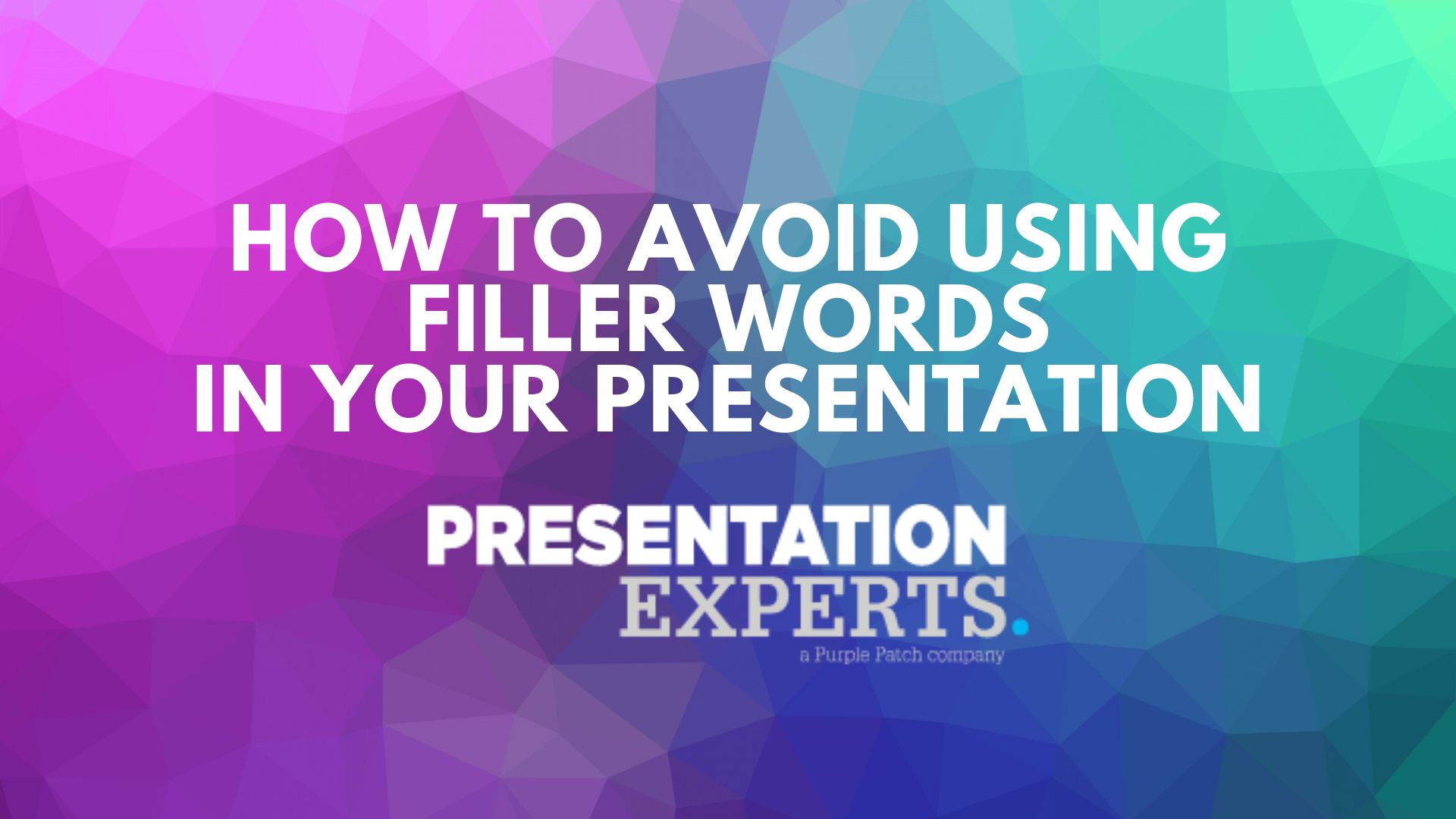
How to Avoid Using Filler Words in Your Presentation
- Alternatives 🔥
Presentation Script | Ultimate Guide To Engage Your Audience in 2024
Jane Ng • 05 April, 2024 • 8 min read
How can you organize a PowerPoint presentation so it engages the audience? this is a hot topic! Are you looking for a script presentation example? Every memorable presentation starts with a single blank page and a writer's determination to create something extraordinary. If you've ever found yourself staring at that intimidating blank canvas, unsure how to transform your ideas into a captivating script, fear not.
In this blog post, we'll guide you on how to write an impeccable presentation script that will mesmerize your audience. Moreover, we'll provide you with practical tips and real-life examples that help you kickstart your journey toward crafting a compelling presentation script.
Learn how to write a presentation script with AhaSlides, today!
Table of Contents
Why a well-written presentation script matters, how to write a presentation script, expert tips for writing an engaging presentation script.
- Presentation Script Example
- Key Takeaways
Overview - Presentation Script
- Presentation description
- Title ideas
| Why A Well-Written Presentation Script Matters? | It matters because it is the backbone of your presentation, ensuring structure, engaging your audience, and boosting your confidence. |
| How To Write A Presentation Script | Outline structure, Craft a powerful opening, Develop key points, Incorporate visual aids, Use transitions and signposts, Summarize and conclude with impact, Seek feedback, and revise. |
| Expert Tips For Writing An Engaging Presentation Script | Engage the audience with interactive features, use conversational language, emphasize key takeaways, and address potential questions. |
| Presentation Script Example | An detail example of a |

Start in seconds.
Get free templates for your next interactive presentation. Sign up for free and take what you want from the template library!
A well-written presentation script is the backbone of your delivery, ensuring structure, engaging your audience, boosting your confidence, and providing adaptability.
- An excellent presentation script brings structure and clarity to your message.
- It keeps your audience engaged and helps them understand your ideas.
- It also ensures consistency and repeatability, especially when presenting multiple times.
- A good script for presentation provides adaptability and preparedness, enabling you to adjust and handle unexpected situations.
In addition, for many presenters, nerves and Glossophobia can be significant hurdles to overcome. A well-written script provides a sense of security and confidence. Like a safety net, it ensures that you have your key points and supporting details at your fingertips. This boosts your confidence and reduces anxiety, allowing you to deliver a more polished presentation.

So, how to make a script for a presentation?
Before writing a presentation script, you need to know your audience's background, interests, and knowledge level. Then clearly define the purpose of your presentation. Having a clear objective will help you stay focused while writing your script.
1/ Outline The Structure
Start with an attention-grabbing introduction, followed by the main points you want to convey, and conclude with a strong summary or call to action.
For example:
- Introduction - The introduction script for presentations should be a welcome and personal connection to the topic.
- Main Points - Benefits of "topic"
- Transitions - Use phrases like "Now let's move on to," or "Next, we'll discuss."
- Conclusion - Recap key points and call to action.
You can consider using bullet points or headings to organize your ideas within each section.
2/ Craft A Powerful Opening
Crafting a strong opening statement is crucial to capturing your audience's attention and setting the tone for your entire presentation. Here are some key elements to consider when creating an impactful opening statement:
- Hook the Audience: Start with a captivating hook that immediately grabs the audience's attention
- Establish Relevance: Communicate the relevance and importance of your topic to the audience. Highlight how it relates to their lives, challenges, or aspirations.
- Create an Emotional Connection: Appeal to your audience's emotions and create a sense of resonance or empathy. Connect with their desires, challenges, or aspirations to make a personal connection.
3/ Develop Key Points
When developing the key points in your presentation script, it's essential to provide supporting information, examples, or evidence that reinforces your message. Here's how you can expand on each main point:
Supporting Information:
- Present facts, data, or expert opinions that support your main point.
- Use credible sources to strengthen your arguments and provide context.
- Use evidence to back up your claims and increase credibility.
Logical Order or Narrative Flow
- Organize your main points in a logical order to facilitate understanding.
- Consider using a narrative flow to create a compelling storyline that connects your main points.

4/ Incorporate Visual Aids
Incorporating visual aids strategically into your presentation can significantly enhance understanding, engagement, and retention of information.
- Example: If you're discussing the features of a new product, display images or a short video demonstrating its functionality as you describe each feature.
5/ Include Transitions and Signposts
Including transitions and signposts helps guide your audience through your ideas and ensures they can easily follow your train of thought.
You can use concise and engaging language to introduce the upcoming subject matter.
- Example: "Next, we'll explore the latest..."
Or you can use questions to transition between sections or engage the audience's attention.
- Example: "But how can we tackle this challenge? The answer lies in..."
6/ Summarize and Conclude
- Recap your main points to reinforce key messages concisely.
- End with a memorable conclusion that leaves a lasting impact or a call to action for your audience.
7/ Seek Feedback and Revise
- Share your script with a trusted colleague, friend, or mentor for constructive feedback.
- Once you have made revisions based on feedback, practice delivering your revised script.
- Refine and fine-tune your script as needed through practice sessions and additional feedback.
Involve The Audience
Boost audience participation and engagement by leveraging interactive features such as Q&A session , live polls, quizzes and small activities through AhaSlides . By utilizing these interactive elements, you can transform your presentation into a dynamic and engaging experience for your audience.
You also can ask your audience for feedback by rating scale or Likert scale !
Use Conversational Language
Write your script in a conversational tone to make it more approachable and relatable. Avoid jargon and complex terminology that might alienate your audience.
Know Your Key Takeaways
- Identify the main messages or key takeaways you want your audience to remember.
- Craft your script around these key points to ensure they are emphasized throughout the presentation.
Address Potential Questions or Concerns
By proactively addressing potential questions or concerns within your presentation script, you demonstrate thoroughness, credibility, and a genuine commitment to addressing your audience's needs.
This approach helps foster trust and ensures that your presentation provides clear and comprehensive information, leaving your audience feeling satisfied and informed.

Presentation Script Example
Here's an example of a presentation script about "The Power of Effective Communication":
| . | |
| Slide 1 | [Slide displays the title: "The Power of Effective Communication"] |
| Slide 2 | [Displays the quote: "The single biggest problem in communication is the illusion..."] |
| Transition | Let's start by understanding why effective communication is crucial... |
| Slide 3 | [Slide displays the title: "Building Strong Connections"] |
| Slide 4 | [Slide displays key points on active listening] |
| Transition | One fundamental aspect of effective communication is active listening... |
| Slide 5 | [Slide displays the title: "Non-Verbal Communication"] |
| Slide 6 | [Slide displays key points on non-verbal cues] |
| Transition | Did you know that the majority of communication is actually non-verbal... |
| Slide 11 | [Slide displays the title: "Unlocking the Power of Effective Communication"] |
| Conclusion | Thank you for your attention today. Remember, the power of effective communication... |
Key Takeaways
In conclusion, crafting a well-written presentation script is essential for delivering a successful and impactful presentation. By following the steps and tips outlined in this guide, you can create a script that engages your audience, communicates your message effectively, and leaves a lasting impression.
Remember, incorporating interactive elements can significantly enhance audience engagement and make your presentation more memorable. AhaSlides, with our wide range of templates and interactive features like questions, polls , and activities, provides a powerful platform to involve your audience actively and create an interactive and dynamic presentation experience.
How do you write a script for a presentation?
Here are steps on how to write an effective presentation script: Outline the structure, including an attention-grabbing introduction, main points, and a strong conclusion. Craft a powerful opening that hooks the audience, establishes relevance, and creates an emotional connection. Develop key points with supporting information and logical order. Incorporate visual aids strategically to enhance understanding. Use transitions and signposts to guide your audience. Summarize and conclude with impact . Seek feedback, revise, and practice for a polished presentation.

How do you start a presentation script example?
Here's an example of how you can start a presentation script: - "Good morning/afternoon/evening, ladies and gentlemen. Thank you all for being here today. My name is_____, and I am delighted to have the opportunity to speak with you about_______. Over the next _______, we will explore [briefly mention key points or objectives of the presentation]." The opening lines should aim to grab the audience's attention, establish your credibility, and introduce the topic you will be discussing.
Is it okay to read a script for a presentation?
While it's generally recommended to avoid reading directly from a script, there are situations where it can be beneficial. For formal or complex presentations like academic or technical talks, a well-crafted script ensures accuracy and keeps you on track. However, in most cases, a conversational style with notes or prompts is preferred. This allows flexibility, spontaneity, and better audience engagement.

A writer who wants to create practical and valuable content for the audience
Tips to Engage with Polls & Trivia
More from AhaSlides

- Scroll to top

How we write presentation scripts that captivate audiences.
- Author Chris Tomlin
- Published June 15, 2023
Having written thousands, this is our advice on how to write a presentation script and how to use scripts in your presentations.
What’s the most important factor in any presentation?
It’s got to be the design, right? Making your slides so beautiful, so chic, and so damn on-brand that your audience will weep at their magnificence?
That’s important, but no – we’re talking about something more fundamental than that.
Ok, then. How about the animation ? Slick, professional and seamless. That premium, professional sheen that shows your quality through and through.
Again, really love your thinking here, but before that too.
Before you even open PowerPoint, Keynote or Google Slides. Before you get stuck into Photoshop, XD, or whatever design software you prefer.
In many cases, before you even fire your trusty PC or Mac up.
Which brings up back to answering that original question. The first – and most important – part of any presentation is the story. It’s the structure on which those other visual elements can hang, and with a great narrative, your design and animation can take it to another level of excellence.
But the story needs to be delivered. And in most cases, that’s down to you, the presenter. So you need a way to make sure you talk through the story in the right order. Hitting the right highs and lows. Without missing anything out. And without rambling on and going over your time limit.
What you need, my friend, is a presentation script.
The benefits of a great presentation script
OK, before we go any further, I can already see some of you grimacing at the thought of a presentation script.
I don’t need a script , you might be thinking – and you may well be right.
Scripts make presenters sound all robotic and boring , you could be muttering – and again, good point.
I want my salespeople to be able to think on their feet and adapt to any situation , you might be screaming into your screen. OK, chill out – you’re not wrong.
But let’s not be so black and white about things, eh?
Like presenters, presentations and audiences, each script should be different.
Your presentation script will likely be based on your experience as a presenter, your knowledge of the presentation subject, the level of detail you want to go into, the type of audience you’re presenting to, your time allowance, and many other variables.
So, it’s a good idea to start with the maximum amount you need, and then chip away as necessary. Think of it like Michelangelo’s David. To create his masterpiece, the Italian sculptor took a huge block of Tuscan marble, whittling it down for over two years to reveal the final result.
Can you imagine if he just took a small torso-shaped piece, and then glued a few bits and bobs on as he went along?
It’s the same for your presentation script: write it out in full, and see how it feels when you speak it out loud. What’s that? You probably wouldn’t speak it out loud? Well, you should – some phrases sound all wrong spoken aloud, even when they look fine on the page.
Speaking aloud also gives you a much better estimate of the time it will take to present it in full; reading it in your head, or even muttering it softly to yourself just won’t give you the same timings.
Each time you speak it aloud, it will get a bit tighter, a bit stronger and a bit more personalised to the way you speak.
And, after a few drafts, you’ll have something approaching your final presentation script. Just be careful to leave it when it’s ready – it can be tempting to tweak and tweak ad infinitum, and it’s sometimes difficult to know when to leave it alone.
Now it’s decision time. What will you do with this script? There are basically three choices here:
- Read the full script.
- Cut it down to bullet points.
- Memorise it.
Let’s look at the pros and cons of each in turn.
1. Read the full script
This is the safest method.
You separate your script out throughout your slides in the speaker notes section. This means you see them on your laptop, but your audience doesn’t on the big screen (or their Zoom screen).
Most people new to presenting, nervous of public speaking, not experts in the subject matter, or just a bit cautious, might initially choose this option, but it’s not without risks.
Yes, you won’t forget anything and yes, it gives you something to focus on other than the audience, but that can become an issue.
If you stand in front of your audience with your eyes glued to PowerPoint’s speaker notes, then it’s often not the best experience for them. People like to connect with one another, and eye contact – even over video calls – is an important part of this. So, if you don’t even glance up from time to time, you and your presentation can come across as cold, at a time when you should be sharing emotion.
And another issue is it can be hard to portray that emotion when you’re reading out loud, rather than speaking from the top of your head. It can be a bit like listening to kids reading out loud in primary school: sure, they are saying all the words right, but the speed, the cadence, the emphasis and passion can all be lost.
So how can you get around this conundrum: you’re not confident enough to go without a presentation script, but you don’t want to sound like an emotionless reading drone. The answer, whether you like it or not, is to practice.
Most people don’t practice, so most presentations aren’t very good. Don’t be that guy.
The more you practice, the more comfortable you will feel delivering your presentation script. You’ll find that certain sentences and phrases slip off the tongue a bit easier, so you are able to make eye contact from time to time. Keep practicing and there may be whole slides or sections that you can talk around – maybe not word-for-word – but close enough.
And this is where you’re getting closer to that audience connection – in fact it’s arguably better to falter every now again – it proves you’re just human like the rest of us.
It also gets you closer to option 2.
2. Cut it down to bullet points
For most of our clients , who are pretty experienced presenters, this is the best option. It gives you the flexibility to talk around the main points, but with a safety net of all the key points written down as memory aids.
These bullets, tucked away in the speaker notes, can be a presenter’s secret weapon. With just a discreet glance towards their screen every now and again, they can make sure the whole story is delivered in full, in order, and with a healthy amount of audience connection thrown in too.
Don’t forget that speaker notes – whether a full presentation script or bullet points – are really easy to edit. So, if you tend to use a presentation multiple times, you can go in each time afterwards to tighten up a word or two here, or perhaps a couple more pointers there.
Or maybe edit them beforehand to personalise the script a bit to your specific audience – it’s a good way to mitigate on blanking the company or individual names you’re meeting.
It’s still important to practice with just speaker noters though, and you’ll find those glances become fewer and the eye contact increases as you do so. And the more you practice speaker notes, the better you’ll get, perhaps ultimately getting to option 3.
3. Memorise it
Let’s face it, the best presenters don’t need any kind of script. When was the last time you saw someone delivering a TED talk with a fistful of cue cards? Or referring back to their laptop every couple of minutes?
It’s all just there, in their heads, effortlessly transitioning through and out of their mouths. Or so it appears… again, don’t kill the messenger but these people practice over and over and over.
But memorising it doesn’t always mean literally reciting every exact word. That can be useful when you have a very strict time to work within, but the best presenters can flow in and out of their memorised script at will. It’s really something to behold.
This means they can slip in relevant stories or recent events seamlessly. Or can refer back to other talks that day, personalise their story to the audience and generally make it much more of a flexible experience.
But of course, there’s a flip side. Less experienced speakers might lose their place, miss a whole chunk out, or go off on a rambling tangent that has no relevance, like that time I went to do a talk and it was really early in the morning and usually I set my alarm for 6.45 except for Thursdays when I get a lie in but actually the Thursday before I had a meeting so I turned that alarm off, but left on the 8.30 alarm and this talk happened to start at 8.15 and I didn’t realise but the alarm was still on but the talk didn’t actually start on time because there was an issue with the pastry delivery because we usually use this one company but they couldn’t deliver them so we had to use another company which was actually run by the husband of a client we used to work with who used to be a designer but then realised that he preferred to actually bake and……… you get the point there I hope.
Your presentation script. Your way.
All in all, presentation scripts are essential in creating and presenting a great audience experience. They give you structure, flow, and confidence that simply reading off your slides, or ad-libbing it can’t.
Start with a strong presentation script, and remember that it’s entirely up to you to decide how to use it to make the most out of your own style.
Recent Posts
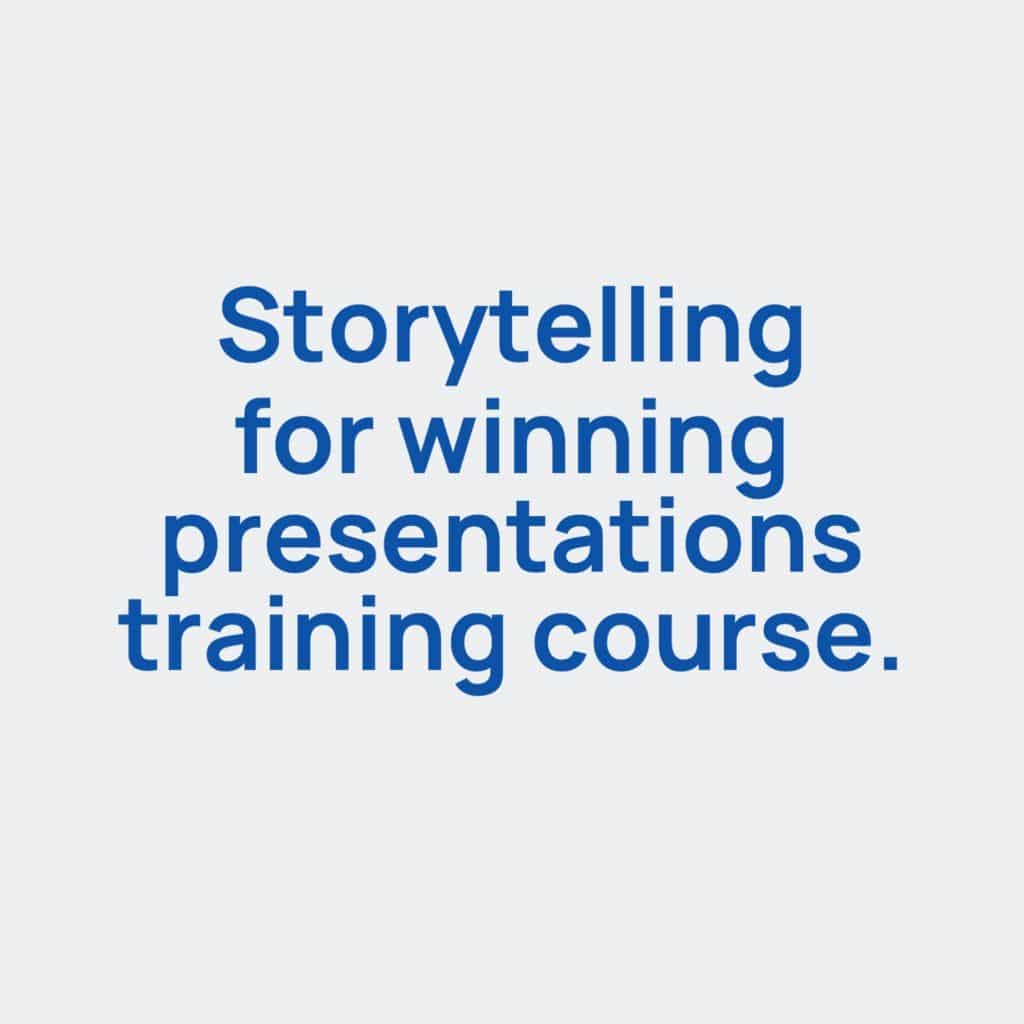
- Posted by James Robinson
Storytelling for winning presentations training course.
Discover how to transform your presentations with the “Storytelling for Winning Presentations”...
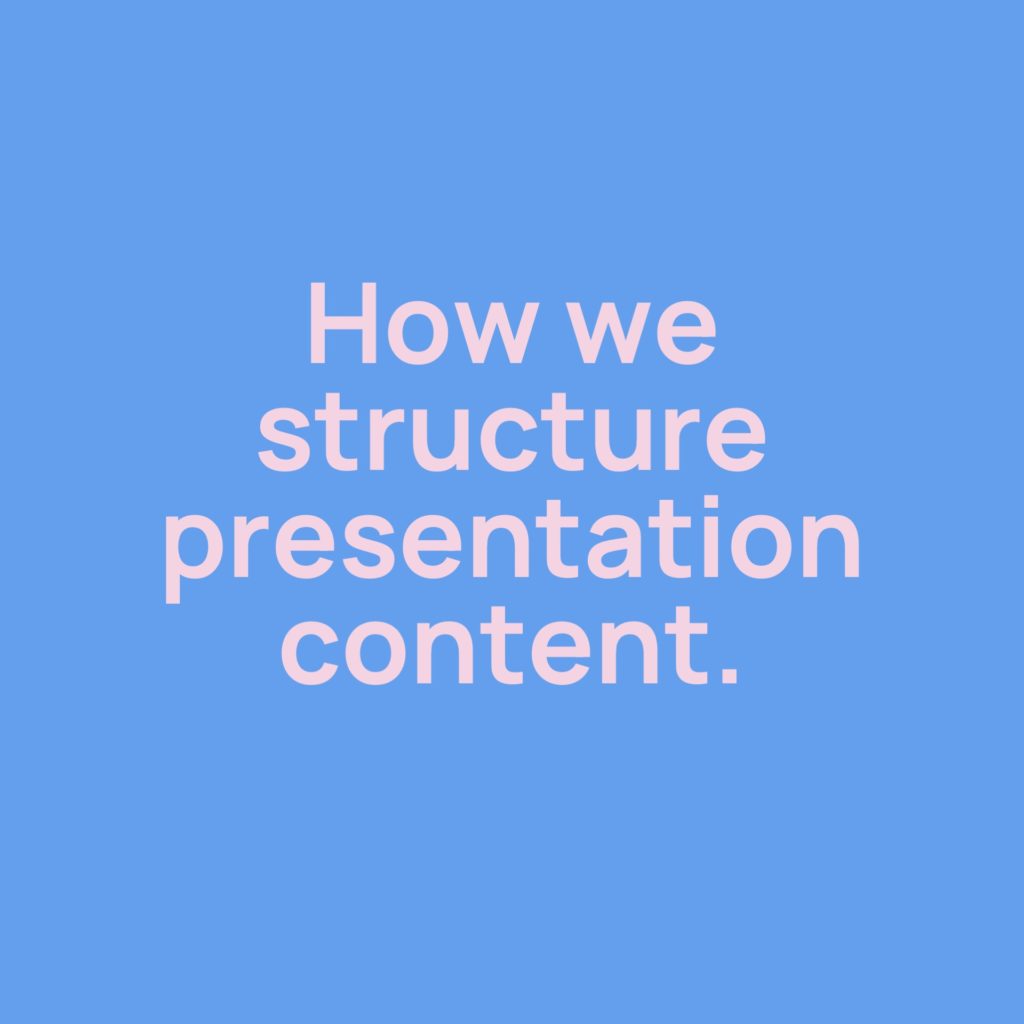
- Posted by Chris Tomlin
How we structure presentation content.
Your content is the foundation of your presentation, and how you create...
Presentation Skills

- Introduction
- Storytelling
- Presentation Outlines
Writing a Presentation Script
- Tools for Creating Presentations
- Creating Interactive Presentations
- Designing Presentation Slides
- Finding & Citing Media
- Citing Your Sources on Slides
- Preparing & Testing Technology
- Recording Your Presentation
- Handling Audience Questions
- Presentation Anxiety
- Group Presentations
- Online Presentations
- Feedback Form
- AI Survey for Students
- Co-Curricular Recognition Form
- Faculty Resources
Once you've decided on your presentation structure or outline, your next step is to write a script.
A presentation script include details about your key talking points , cues for visual aids such as slides or props, and a structured outline to guide your session.
In this section, we'll explore how you can script and practice your presentation to help you organize your ideas, create a logical flow in your argument, and avoid unnecessary details.
Learn how your favourite professors structure their course content and use these tips to create an engaging presentation!
How to Write an Engaging Script for a Presentation-based Online Course
After creating your outline, write out how you would explain your information to a person sitting right in front of you. Resist the urge to rewrite at this step! You can edit later.
Make sure your pacing is consistent so you're not lingering on a single slide for too long. Be concise! Consider how your bullet points might be broken up into slides, and try to keep the same number of sentences or paragraphs per slide.
One of the most challenging parts of writing a script is sounding natural—we can sometimes become too formal with our language, which can make us sound flat and inauthentic. Make sure to add some of your personality to your script, and use language that sounds more like you.
Add some cues to your script to help you remember how you want to deliver certain parts of your presentation. For example, you might write out certain words in italics to remind yourself to emphasize certain words.
Presentation Script Basics
Click on the boxes below to learn some quick tips you can consider when writing your next presentation script:
1. Outline the structure
Start with an attention-grabbing introduction, followed by the main points you want to share, and conclude with a strong summary or a call to action.
For example:
Your introduction should be a welcome, personal connection to your topic.
Your main points are the key parts of your message or argument. You'll use facts, figures, stories, examples, etc. to illustrate your main points and build a compelling presentation.
Transitions are the phrases and sentences you'll use to help your audience know when you're moving between your different main points. You might use phrases like, "Now, let's move on to…" or "Next, we'll discuss…".
In your conclusion, you'll recap your key points and share a call to action for your audience (i.e., what do you want your audience to do with the information you've shared with them).
2. Craft a powerful opening
Crafting a strong opening is crucial to capturing your audience's attention and setting the tone for your presentation.
Here are some key elements to consider when you're crafting your opening statement:
A good hook introduces your subject matter and engages your audience while also setting the tone of your session. Hooks are sharp and quick to grab attention —they could be a surprising statistic, a thought-provoking question, and even a short personal story. This is your chance to get creative!
Communicate the relevance and importance of your topic to your audience. Highlight how it relates to their lives, challenges, or goals.
Appeal to your audience's emotions and allow them to resonate or empathize with your ideas. For example, you could share a personal story about you or someone you know who's personally affected by your topic before sharing facts and statistics about the topic.
3. Develop key points
When you're developing the key points in your presentation script, it's essential to provide supporting information, examples, or evidence that reinforces your message.
A few ways you could expand on each main point include:
Supporting information
- Present facts, data, or expert opinions that support your main point.
- Use credible sources (e.g., journal articles) to strengthen your arguments and provide context.
- Use evidence from studies to back up your claims and increase credibility.
Logical order or Narrative flow
- Organize your main points in a logical order to make it easier for your audience to follow your argument.
- Consider using a narrative flow to create a compelling storyline that connects your main points. For example, if you were talking about healthcare access issues, you might create a character experiencing several of these issues and show your audience how it can impact someone's life (especially if your audience has never experienced the issue you're describing).
4. Incorporate visual aids
Incorporating visual aids strategically in your presentation can significantly enhance your audience's understanding, engagement, and retention of information.
- For example, if you're presenting to the class about a new product idea, you could display images or a short video demonstrating the product's functionality as you describe each feature.
5. Include transitions and signposts
Including clear transitions and signposts helps your audience with following your ideas and message.
You could use concise and engaging language to introduce the upcoming content.
- For example, "Next, we'll explore the latest…".
You could also use questions to transition between sections or engage the audience's attention.
- For example, "But how can we tackle this challenge? The answer lies in…".
6. Summarize and conclude
Take the time to recap your main points to reinforce your message concisely. Try to summarize each of your key points in a single bullet point in a list.
You could also end your presentation with a memorable story or quote that leaves a lasting impression with your audience, or a clear call to action for your audience (e.g., asking your audience to visit your portfolio website, your new product's website, to learn more about an organization you worked with to plan your presentation, etc.)
7. Seek feedback and revise
Practice your presentation with a trusted colleague, friend, or family member to get constructive feedback. It's helpful to present your content to someone who has no knowledge of the topic so they can point out any areas where you might need to give more context.
You could also book a free tutoring session at Sheridan's Tutoring Centre to get feedback on your script and slides. You can book an appointment through the TutorOcean portal.
Once you've made your edits and revisions based on this feedback, practice your presentation again. You could do this on your own to make sure you feel comfortable and confident with the material.
Bonus points—you could try recording yourself while you're presenting and watch it back to help identify any other changes you want to make!
Presentation Script Examples
We've covered what you want to include in your presentation script—but how should you write out that script?
Watch the video below as an example of a short presentation you might see in your class.
Below the video, you'll find three examples of scripts the creator might use to organize their ideas:
- A script layout in a Microsoft Word document;
- A formatted table in Microsoft Excel and
- In the Notes section of a Microsoft PowerPoint slide deck
- Script Layout [Microsoft Word doc] Includes slide content, cues for rehearsed gestures or body language, video editing notes, and more.
- Formatted Table [Microsoft Excel] Table divided into three key areas: Presentation section or slide, planned material for spoken and visual content, and timing estimates.
- Notes Section [Microsoft PowerPoint] Add speaking notes and transitions to the Notes section in PowerPoint so you can refer to them during your presentation.
- Last Updated: Sep 5, 2024 10:25 AM
- URL: https://sheridancollege.libguides.com/presentationskills
Connect with us
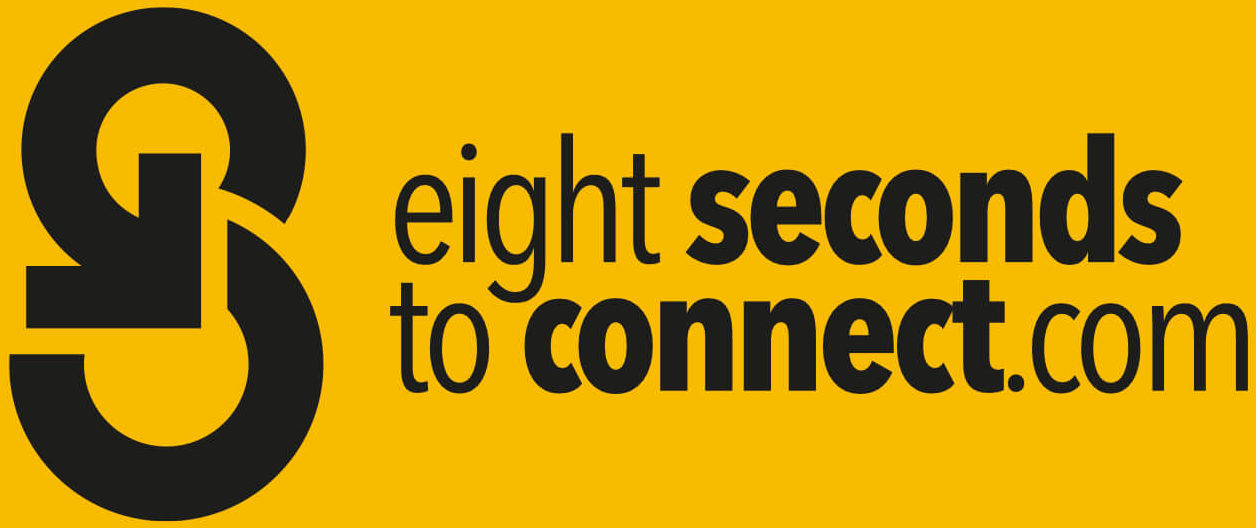
- November 28, 2022 October 16, 2023
How to write a presentation script and fully control your pitch [with steps]

“There it is. At the back. The exit. You can make it. In only 10 seconds, you’ll be safe.” the little voice in my head whispered.
I was so nervous I was pacing in circles like a spinning top.
I was speaking with a croaky voice.
Word by word, I was losing control.
This was during my TEDx Beijing talk in 2010.
Before taking the stage, I had dreamed about giving a TEDx talk that would make it to TED.com, yet now I was falling apart live in front of 100 people.
I had not practised the performance aspect of my talk.
I stayed in my comfort zone designing the slides.
And I had only stood in my room practising to the sofa.
I waited until being in front of 100 people to do the talk from start to finish for the first time.
As I sit here writing this, reliving the moment, shaking my head – what a rookie mistake.
So when people say, “I don’t have time to practice, I’m going to wing it.”
I go like 😳.
No one good at what they do does not make time to practice.
When it looks easy, you do not see the hours of practice, study and intention.
You get back what you put in, which cannot be more accurate than when you are in the spotlight in front of people with no way to pause, rewind or undo the moment.
I call pitching, public speaking and presenting a high-value spotlight moment; it can be to an audience of 1 or 10,000.
When you have the attention of the room and your ideas can grow, this is a fantastic opportunity which requires preparation and focus.
What are the things you can control during a presentation?
There are four things you directly control when you present.
01 – what you say – your content (hint: presentation script)
02 – how you perform – your verbal and non-verbal body language
03 – slide design / visual support – what visuals amplify your message
04 – how much you practice
Think back to gym class.
Before any sport, if you skip stretching and don’t warm up, you risk playing badly and injuring yourselves.
Now in my mid 40’s, I have to stretch every morning to get the day started right.
No matter your age, you need to warm up if you want to pitch with confidence and intention.
Here is one area you can improve quickly with a consistent short sequence of exercises.
Speaking flow – a combination of content and performance, how you look, sound and move on stage.
Is your presentation like a gift, or an amazon delivery box?
Are you presenting a gift or dropping a brown box at someone’s doorstep?
A gift is unique.
A brown box delivery is ordinary.
A brown box delivery is when you spend more time, attention and effort getting your presentation from start to finish.
A major tell for a brown box delivery is when you speak flatly, pause at the wrong time and look up a lot.
Instead, present like a gift.
Make it special.
A gift has wrapping paper, a name card, is revealed on a special occasion and intended for one person.
People don’t remember the ordinary.
They remember the feelings you inspire in them.
Steps to writing a presentation script and pitching it perfectly
Take these steps
- Start by writing the presentation script out word for word.
- This is to get total clarity for yourself.
- Then reduce the script to bullet phrases – reduce as many words as possible while retaining meaning and structure.
- Move the bullet phrases to a series of index cards.
- Practice with the index cards at least ten times.
- You know you are on track when you get to the point where you are only glancing at the cards.
- Record every pitch practice session on your phone.
- Listen back to each performance.
- Note down what is working well.
- And what needs improvement.
- Focus on these areas.
- Practice 2-3 times a day.
- Give yourself as much margin to practice as possible.
- Keep the index cards close to hand for the three days before your spotlight moment.
- Review them frequently.
- Spill the cards on the floor and reorder them as quickly as possible.
- Slowly practice more with your mental map of the pitch than the cards.
- Work with a particular focus on the introduction and the conclusion.
- Then the segways which link the themes together.
Structure to build a mental map
I use a mountain to structure my pitches.
A series of peaks and valleys to hang the content means I remember the themes and relationships rather than the exact words.
This gives me way more flow and reminds me to keep building the energy, momentum and tension.
Let go of the word-for-word presentation script.
Pitch a gift, not a brown Amazon box.
Reduce the content to keywords on index cards.
Practice so you have a very familiar mental map of the pitch.
What is the cost of not doing this?
If you don’t make the time, all your effort to create your spotlight moment will probably go to waste, and the only mental map you’ll have is one of regret at the missed opportunity.
Please don’t do what I did to prepare for my TEDx talk. Focus on the things outside of your comfort zone.
Have any questions about using a presentation script??
Connect with me on LinkedIn!
Hopefully you will find more value in our other blog-posts:
How many slides for a 10-15 minute presentation
How to start a presentation? Start your pitch like an Olympic sprinter
Leave a Reply Cancel reply
Your email address will not be published. Required fields are marked *
Save my name, email, and website in this browser for the next time I comment.
- Mar 3, 2023
How to write a Presentation Script [Tips from expert agency]
Lights flicker on as the room quiets down. You take a deep breath and step up to the podium, feeling the eyes of the audience on you. This is your moment to shine, to convey your message in a way that will captivate and inspire. But where do you start? How do you create a winning narrative that will leave a lasting impact?
As Jeff Weiner said,
“The best presentations are conversations” — Jeff Weiner
In this article, we’ll learn how to create a presentation script that will capture hearts and minds alike. We’ll show you how to structure your ideas, use storytelling techniques to make your message come alive, and deliver a memorable closing that will leave your audience wanting more.
But first, let’s cover the basics…
What’s a presentation script?
A presentation script is basically a plan for what you’re going to say during your presentation. It’s like a roadmap that helps you stay on track, hit all the important points, and keep your audience engaged.
Now, you might be thinking, “But I’m good at winging it! I don’t need a script!” And hey, some people can pull that off. But for most of us mere mortals, having a script is crucial if we want to deliver a presentation that’s clear, concise, and effective.
With a presentation script, you can practice your delivery and fine-tune your message before you even step on stage. You can also make sure you’re not forgetting any important points or getting sidetracked. Plus, if you tend to get nervous during presentations (which is totally normal!), having a script can help you feel more prepared and confident.

Why do you need a presentation script?
Here are some pretty good reasons why having a script is a smart move.
Keeps you on track: With a presentation script, you know exactly what you need to cover and in what order. This can help you stay focused and ensure that you don’t forget any important points.
Helps you practice: By having a script, you can practice your delivery and fine-tune your message before you even step on stage. This can help you feel more confident and prepared when it’s showtime.
Improves your message: With a script, you can make sure your message is clear, concise, and impactful. You can also edit out any fluff or tangents that might detract from your main point.
Saves time: If you’re giving a presentation to multiple groups or on multiple occasions, having a script can save you time in the long run. You can reuse the same script and just make minor tweaks as needed.
Reduces nerves: Let’s face it, presenting in front of a group can be nerve-wracking. But having a script can help you feel more prepared and confident. When you know exactly what you’re going to say, you’re less likely to get flustered or forget your lines.
How to create a winning presentation script?
1. start with the end goal.
When you’re working on your presentation script, don’t forget to keep your end goal in mind! Are you trying to inspire your audience to take action, educate them on a topic, or show off your mad skills in a certain area? Knowing your objective will make the rest of the process way easier.
Think about it: if you don’t know why you’re giving this presentation, you’re going to be all over the place, trying to cover too much ground, and your audience will be left scratching their heads. So, take a sec to think about what you want to achieve with your presentation before you start writing your script.
Once you’ve got your objective locked in, it’s time to brainstorm the key points you want to cover. Don’t hold back, let your creativity fly! Then, flesh out each point with examples, data, and other juicy details. Lastly, craft a killer opening and closing that will leave your audience feeling wowed.
2. Create a structure for your narrative
Alrighty, now it’s time to give your presentation some structure! First up, think about how you want to break down your narrative into three main parts: the beginning, the middle, and the end. This will help you keep your audience engaged and make sure you cover all the important stuff.
Next, you’ll want to think about where you want to focus the most attention. Do you want to grab your audience’s attention right off the bat with a killer opening, or leave them with a lasting impression by closing strong? This will vary depending on the type of presentation you’re giving.
For example, in a pitch deck, building a solid case for the problem statement might be the most crucial part, while in others, the call-to-action (CTA) at the end might be the most important.
So, take a minute to think about the key points you want to cover and where you want to place the most emphasis. This will help you structure your presentation in a way that keeps your audience engaged from start to finish. You got this!
3. Write what you want to say
It’s time to get those ideas out of your head and onto paper! You’re gonna want to use a text file to document your script. Start by writing down your narrative from beginning to end, just like you want to present it.
Remember that structure we talked about earlier? Now’s the time to use it to guide your writing and keep yourself on track. And hey, don’t stress if it’s not perfect on the first go-around. You can always go back and make tweaks later.
4. Use stories & anecdotes for engagement.
While you write your presentation script, don’t forget to spice up your script with a few anecdotes, attention-grabbing facts, and good old-fashioned business storytelling! These elements can help engage your audience and keep them hooked throughout your presentation.
Now, remember! Just because you’re incorporating storytelling into your presentation doesn’t mean you should lose sight of the business context. You might have heard of the term “storytelling” being thrown around by branding agencies, but there’s a difference between “storytelling” and “business storytelling.”
The latter focuses on conveying key business messages and ideas in a compelling and memorable way. So, make sure your anecdotes and storytelling tie back to your overall message and objectives. This way, you’ll not only entertain your audience but also leave them with a clear understanding of your business goals.
5. Co-ordinate with your slide design
Don’t forget to coordinate your speech with your slide design! Remember, less is more when it comes to visuals. The graphics in your presentation should complement your words, not the other way around. After all, you’re the star of the show here!
That being said, visuals can still play an important role in guiding your presentation script. You can use them as cues to remind you of key points or to help you transition between topics. Just make sure they’re not distracting or overwhelming, and that they serve a clear purpose in enhancing your message.
So, when designing your presentation, keep your script in mind and aim for a cohesive and effective combination of visuals and speech. That way, you’ll be sure to capture your audience’s attention and leave them with a clear and memorable message.
6. Create & design your cue cards
When you start putting together your presentation script, you might be surprised at just how much content you come up with for a 10-minute talk. It can be a lot to keep track of! That’s where cue cards come in handy.
Once you’ve written your full script, you can start working on your cue cards. They should be around 3x5 inches and have brief notes or bullet points to prompt you during your presentation. You’ll want to create your cue cards after you’ve rehearsed from the full script a few times, so you know which parts of your presentation you need reminders for.
And hey, while you’re at it, why not make your cue cards look sharp and in line with your brand? Even though it might not seem like a big deal, branding is all about the details. So, put some effort into designing your cue cards and make them an extension of your presentation. Trust us, it’ll be worth it!
Work with us.
Feeling overwhelmed and stressed out about an upcoming presentation? Don’t worry, we’ve got your back! Our team is here to help you create a solid narrative structure and design eye-catching slides that’ll make your presentation shine.
So why not save yourself some time and stress by reaching out to us? Let’s work together to make your presentation a success!
Are you r eady to wow your audience with a killer presentation design?
Check out our Business Presentation Design Services .
Related Posts
How To Add Fun To Finance Presentation [Tips]
Marketing Presentation/Deck [What, How, Why & When]
What is a Proposal Presentation [Explained]


- Popular voice categories
- Help Center
A presentation script is a written outline for a presentation, which details key talking points, cues for visual aids such as slides or props, and a structured outline to guide the presenter. Presentation scripts typically break down the dialogue for the speaker to read, details of the product/service being promoted, and voice over instructions, effectively communicating the company’s message and motivating audiences to action. Scripts for presentations also help to ensure that the speaker stays on track and delivers a structured, coherent, and engaging presentation.
Presenters use different presentation script platforms like Google Slides or PowerPoint to write scripts for presentation, particularly because these platforms allow you to write notes that aren’t visible to the audience and add voice overs. For a detailed explanation, you can check out our guide on how to record audio on PowerPoint and how to add audio to Google Slides . For example, a financial presentation script for shareholders might include instructions and additional notes for the presenter to explain complex financial data along with cues for when to change slides or use visuals.
Here are three presentation script examples showcasing the importance of a structured outline, direction notes for the presenter, and cues for visual aids.
Presentation Scripts #1: The importance of a structured outline
Project Type : Request for funding from investors.
Target Audience : Investors, business owners, key tech-industry players
Presentation Length : 15:00
Presentation Script Outline:
Introduction – 2.30 minute
- Greet investors and express appreciation for their time
- Identify and describe the problem that your business idea seeks to solve
Funding Request – 6 minutes
- Clearly articulate your business idea and how it solves the identified problem
- Detail the unique selling points of your solution in comparison to existing alternatives
- Explain how your business will generate revenue and achieve profitability
- Outline your approach to reaching out to and acquiring customers
- Present key financial projections over the next 5 years
- Specify the amount of funding required and what it will be used for
- Discuss how the funding will help achieve business objectives and growth
Information for Investors – 4 minutes
- Highlight potential exit strategies for investors
- Discuss potential return on investment for investors
Conclusion – 2.30 minutes
- Reiterate the business idea and its potential
- Express confidence in the team’s ability to execute the plan
- Thank the investors and express appreciation for their time
- Invite questions from the investors
Presentation Scripts #2: The importance of direction notes
Project Type : Company financial report
Target audience : Investors, shareholders, company executives, and board members.
Direction notes : Comfortable, calm speaking pace, slower when explaining facts and figures. Use a friendly, conversational manner. Something like Stanley Tucci’s soothing style.
Presentation length : 15:00
Dialogue Script:
(Friendly, welcoming tone) “Good morning, and welcome to our quarterly earnings report.”
(Slower speaking pace and a calm, moderate tone) “I’m extremely pleased to announce that we’ve seen steady growth in the last three months with a 10% revenue increase and cost reduction of 5%.”
(Normal speaking pace, confident tone) “We’ve also launched several new products and received positive feedback from customers. It’s our belief that a continued focus on innovation and customer satisfaction will drive future growth.”
(Comfortable, conversational tone) “And though we face the challenge of increasing competition in certain markets, we’re confident that our dedicated team and proactive approach will continue to deliver strong results. Thank you for your time.”
Presentation Scripts #3: The importance of cues for visual aids
Project Type : Product launch
Target Audience : Consumers from a specific target audience
Presentation Length : 20:00
Visuals:
- Images of the product from different angles
- Close-up visuals of the product’s features
- Closing call to action slide for consumers
“Hello, everyone; I’m excited to present our latest product line today.”
“Our team has worked tirelessly to develop a range of new and improved products to meet your needs. These products are high-quality, user-friendly, and offer excellent value for money.”
(Display product images)
“And since our research team determined that convenience, durability, and versatility are what you’re after, we’re convinced this new product range ticks all the boxes.”
(Display product features visuals)
“We’re also offering special discounts for those of you who want to take advantage of early promos, so now is the perfect time to place an order.”
(Display slide with a call to action info)
“Thank you for your attention, and we look forward to learning how our project has made a difference in your life.”
How to write a presentation script
You can write a presentation script by following these 10 steps:
1. Start with something catchy
Use a striking statistic, a thought-provoking question, or an interesting fact to make audiences sit up and pay attention. Example: “By the end of this presentation, you’ll know exactly how to increase your consumer database by 40%!”
2. Tailor your message to your audience
Use relatable language that speaks directly to their wants and needs. Example: “As a tech founder, you seek ways to secure your business. That’s where our innovative solution can help you.”
3. Keep your points concise
Write with simple, jargon-free language, and avoid going off on tangents. Example: “Our product can streamline your finance processes efficiently and within minutes. Here’s how it works.”
4. Use intriguing visuals
Utilize graphs, images, colors, and videos instead of lines of text to break up statistics, words, and numbers. Example: “This color chart highlights the company’s sales for the last 6 months, and if you follow the color diagram …’
5. Tell a story with your presentation script
Relate how the product or brand started and where the idea originated. Example: ” I started this company as a broke college student with a dream. Today, that dream has become a team of 500 in national offices. “
6. Use humor and personal anecdotes
These will engage audiences and make your presentation memorable. Example: ” I thought this software would be a huge, immediate success. But then I realized I didn’t test it on Apple computers.”
7. Make it interactive
Ask questions and get feedback from your audience to focus their attention on your scripts for presentation. Example: “Raise your hand if you’ve experienced this problem in your own business.”
8. End with a call to action
Encourage audiences to take a specific course of action. Example: “For more info on our product, please speak to us after the presentation. We’d love to answer any questions you have.”
9. Rehearse your script
This ensures a smooth delivery and will help you get settled with your audience before you speak. Example: “I’ve practiced this presentation in front of my colleagues, family, and friends, but if I forget something, please bear with me.’
10. Infuse passion into the delivery
If you believe in what you’re saying, your audience will likely believe it too. Example: “My aim is not to sell you a product. My aim is to help you solve a problem and achieve your goals.”
Final thoughts on a presentation script

And there you have it! The 10 tips on how to write a presentation script that will leave a lasting impression on audiences. So when you’re writing scripts for presentations, don’t forget the importance of a structured outline, direction notes, and cues for visuals. Now why not consider hiring a voice actor from Voice123 for a professional touch to your presentation scripts? You can also receive customized options and streamlined payments with our Managed Services.
So get ready to create presentation scripts people will talk about long after the curtains close.
FAQs for presentation script
You can write a presentation script by starting with a catchy opening, tailoring your message to audience needs, delivering concise and well-supported points, incorporating captivating visuals, weaving in storytelling and personal anecdotes, injecting humor, encouraging interactivity, including a clear call-to-action, rehearsing your script, and infusing passion into your delivery.
You can start a presentation script by greeting your audience, introducing yourself, stating the topic of your presentation, and providing a brief overview or agenda of what you’ll be covering.
A presentation script should include a captivating introduction, followed by an overview or agenda detailing the points to be covered, and the main body comprising a detailed explanation of these points with relevant examples and visuals.
Before starting a presentation, you typically greet your audience, introduce yourself, and clearly state the topic of your presentation, along with a brief overview or agenda of the key points you will be covering.
Related Posts
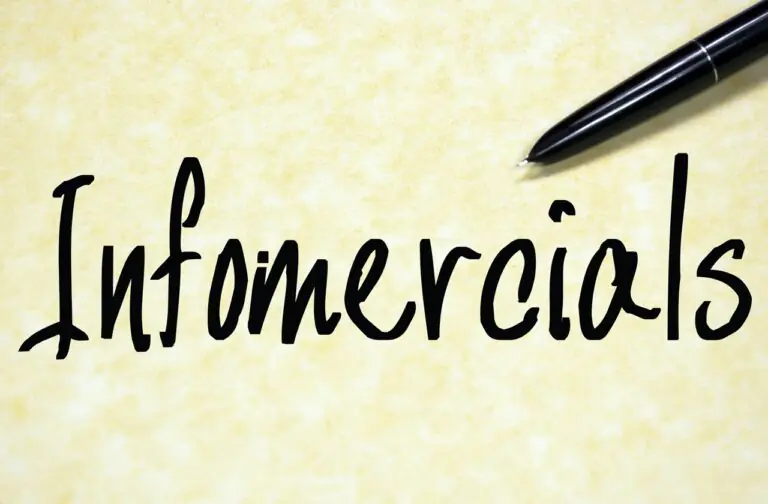
Quick start
- Search for voice actors
- Post a voice over project
- Learn how to use Voice123
More info about
- Voice acting
- Careers at Voice123
Popular VO Categories
- Morgan Freeman style
- Anime voice actors
- PITCH DECK DESIGN
- PITCH REVIEW & COACHING
- PITCH DECK PORTFOLIO
- CLIENT TESTIMONIALS
- STARTUP PITCH DECK
- FUND PITCH DECK
- TV / MOVIE PITCH DECK
- LOGO & BRANDING
- SALES & MARKETING COLLATERAL
- PRESENTATION DESIGN
- STRATEGIC ADVISORY
- LOGO PORTFOLIO
- VIDEO PORTFOLIO
- PRESENTATION PORTFOLIO
- CLIENT PITCH DECK
- STARTUP FUNDING GUIDE
- IS YOUR BUSINESS FUNDABLE?
- TOP FOUNDER MISTAKES
- PITCH DECK QUICK START GUIDE
- PITCH DECK TEMPLATE
- DESIGN RESOURCE TOOLKIT
- WORKSHOPS & COURSES
- VENTURE CAPITALIST NEAR ME
- STARTUP EVENTS NEAR ME
- ACCELERATORS NEAR ME
- THE IGNITE BLOG

- by Stacie Sterren
- Pitch Deck Design
How to Write a Perfect Pitch Script (Comprehensive Guide) – Summary
Why write a pitch script, how do i get started writing, don’t read the script, do tell your story.
- When do I write my Pitch Script?
What do I write in my Pitch Script?
Practicing your pitch as you write.
- Reducing long form text to bullet points
- Reducing Bullet Points to keywords and metrics
Pitching with Your Script
You already have your pitch deck and you know your company. So why do we insist on actually writing out a pitch script? Well, a pitch script helps strengthen your pitch by giving you the ability to streamline, focus, and practice effectively.
Making Adjustments and Improving
Making adjustments when you already have a script is not as challenging as working on the fly with every pitch. In general your pitch deck serves as a basic outline of the script, but actually writing the details out of what you want to cover and what you want to convey will ensure that you don’t forget important details and that you pitch in a way you can improve upon.
Only One Shot – Make it Count
You usually only get one shot at making it right when you are in front of investors and we’ve found those that get their script together first, have a better shot of making the pitch they intended to make in the pressure situation. Proactively writing your pitch script will reduce the potential for forgetting what to say, leaving critical pieces of information out, or generally just not sounding like you know your business as deeply as you should.

Use your completed pitch deck to get started with this process. The pitch deck is the guide to your pitch script as you would generally be pitching while simultaneously presenting the pitch deck.
Keep in mind, as with most types of presentations and pitches, it’s important to treat the script you write as a guide, because we don’t want you to verbatim memorize or recite things. For one you are going to sound robotic if you do this. You are also going to get flustered if you forget your place as opposed to being able to roll with the natural flow of the pitch.
This is very important so it’s worth repeating… we don’t want you to read the script. In fact, reading anything is reading, not pitching. We don’t even want you to practice with an exact script. It’s important the pitch retain a conversational, excited tone. Don’t practice every single exact word. Also, don’t bring your notes or read off of anything when you are actually pitching – remember reading is not pitching.
Instead you want to make sure you’re telling a story (your story) and you’re talking to your audience. Keep the tone conversational even if it’s just you doing all the talking. If you miss one word when you practice something to a “T” or memorize it, you’ll have a really hard time getting back on track. With a focus on story telling and using your Pitch Deck as your guide, if you miss one word you’ll be able to recover easily and move on. This is really important because pitching to a large audience or even just one investor is extremely nerve racking. Mistakes are bound to happen in that type of environment.
When do I write my Pitch Script?
If you’re building your deck at the same time you’re building your script then you’re going to want to build them together. You could also start this process anytime if you already have a completed deck, but the chances for it to change as you develop the flow of the script are higher.

Using the slides as a guide will help you match what you are saying to the presentation deck or pitch deck that’s going to be a visual aid behind you as you present. With your pitch deck in hand you are going to have a general flow, and a story-line. When you use the outline of your pitch deck to write your script, the next steps are already laid out.
When you’re writing a script, first to make an attempt at writing out exactly what you’re going to say. Every word. This is a long form writing exercise. Write it out using complete sentences. And complete the writing for every slide.
Compelling Content
You want to think about what you want to say, what’s going to engage the audience in the beginning of a presentation. We want to tell a story. As such, we want to grab their attention. We want to use tangible examples as much as we can.
Layering Value
As the presentation goes on we could start to layer in more information, more content, more numbers, and things to backup what we’ve said in the beginning of the presentation. But we want to think about that flow of the story and how we’re going to keep someone engaged the entire time through a presentation.
Written text is a little more formal and a less easy to follow when we’re listening to somebody. Because the way we write it’s a different than the way we talk, its important thing to focus on talking in actual sentences. Attempt to practice your pitch in the way you converse versus the way we write.
Practicing your pitch as you write will help you merge what looks good on paper with what sounds good to your audience. Remember to practice like you will play: Conversational tone, standing vs sitting, and even what you are wearing.
Read your long-form script, put it down face down. Record video of yourself speaking through what you just read. Make improvements to your script and practice again. Repeat this general process until you feel like you’ve exhausted the improvement potential.
Step-by-Step Summary of pitch script writing steps:
- Start with the General Outline from your Pitch Deck to get the overall structure
- Write down your long form script.
- Put it face down.
- Record video of yourself presenting
- Practice what you wrote in a conversational versus rehearsed manner.
- Listen to your video and hear yourself go through it.
- Fine tune the script, make changes, figure out where you want to make it better.
- Rinse and repeat until you feel like it’s the best it can be

Reducing Long Form text to bullet points
Next we’ll write it again with slimmed down content. This time the pitch script will have more bullet points and sections. Reducing length of the long form text will allow you to know cues versus having to sift through complete sentences. Cues are easier to keep conversational than long-form text. Long form text allows you to know everything that you would say when you are cued.
Usually, at this point, you’ll start to see the pitch deck working for you to help cue you and guide you through making all the points you attempting to make. The goal is to associate all these bulleted lists to the slides they go with.
If you’re doing your script at the same time as you’re creating your pitch deck slides, you can think about the bullet points and sections of slides. You can also think about the overall flow and amount of information you are conveying so you can make these two things more audience-friendly and engaging.
Never Use Bullet Points on Your Pitch Deck
Side note here so there is no confusion: Never actually have bullet points on your pitch deck slides, just bullet points in your pitch script. Put that one face down and we’re going to present again in front of a video. We’re going to video ourselves presenting and going to record that. We’re going to listen to it. And we’re going to fine tune our speech from there.
Reducing bullet points to keywords and metrics
The last step is to take those same notes that we had before with the bullet points and we’re going to shorten them up even more into just really, really short bullet points. Just the keywords, maybe just the key metrics that we keep forgetting, whatever it is.
That’s the level of cues or script that we’re okay with you reading and preparing with, that’s it. Not the full list of bullet points, and not the long form text, the one where you wrote it out in full sentences. You should never practice with long-form or bulleted lists that are not reduced. You want to be cued not told what to say.
Practicing with keywords and metrics only
I want you to practice with short bullet points, just the main points in the order that you want to hit them in. So you can read and practice that as much as you can. We cannot stress this enough – Practice, practice, practice. When you think you’ve had enough double your effort and you should be on your way to practicing the minimum amount. Practice cannot be ignored and you’ll usually only get one shot. Make it count by practicing and improving as much as you can.
It’s okay to be different
Every time you go through your pitch, it will be a little bit different. Even though it comes out a little bit different each time, with the right cues, you’re going to still say the same thing. And that’s the most important thing – to say what you meant to say every time. If it’s a little different, that’s actually good. You’ll be able to improvise and adjust to circumstances that are beyond your control with this approach.
It’s also going to be conversational, it’s going to flow, and it’s going to feel comfortable. And most importantly your pitch will convey the information you want to convey. It’s going to hit the points you need to hit because that’s what you’re been practicing, the main points that you need to hit. How you get between the points is less important.

That’s how you write and develop your pitch script.
If you’re going to be using a comfort monitor or a cue card, or something where you’re able to see the notes section of your PowerPoint while you are presenting, you can add back in the shortened bullets. Only use these aides If you’re able to see them while you’re actually presenting without turning your back on your audience. Never look at your slides as you go. When utilizing notes or cue cards, make sure you use those key word oriented bullet points; not long form, and definitely not the full sentences.
Copy and paste the key bullet points into the particular slides they go with. This way the comfort monitor can have all the cues you need and maybe the key pieces of information you have trouble remembering. Keeping you facing your audience at all times is the key. Don’t ever look back at your slides or anything like that. The ideal outcome if you are using a comfort monitor or cue cards is that no one really knows you’re using them when you are pitching.
Keep in mind there’s a lot of places that don’t allow a comfort monitor or that have moved to LCD monitors as the way they present instead of a large screen, so you can’t do the split screen as easily in those settings. Make sure you practice it enough that you don’t need the cues, because you may not always have them available even when you think you might.
Hopefully that answers your question on how to write a pitch script. If you have any thoughts or comments on how you write pitch scripts, maybe you agree or disagree what I’ve shared today I would love to hear about it in the comments below. And if you have any ideas for upcoming pitch hacks we have a link below as well. And I would love to see your questions so that I can answer them in an upcoming Pitch Hack video.
Thanks again for joining us. We do a new Pitch Hack video every single week. So give us a little thumbs up or subscribe and you can find out more about us.
Happy pitching!
Suggest an Upcoming Pitch Hack here: https://info.pitchdeckfire.com/pitch-hack-suggestions
For even more pitch hacks visit us here: https://resources.pitchdeckfire.com/tag/pitch-hacks
**Subscribe for more Pitch Hacks in your inbox every week**
Need help with your pitch? Pitch Deck Fire specializes in pitch deck design and presentation preparation. Sign up to speak to a project lead about your pitch deck, sign up here: https://pitchdeckfire.com/pitch-deck-project-initial-steps/
Seeking funding or preparing for a pitch? Find more resources, check out our other helpful articles and posts here: Resources.PitchDeckFire.com
Stacie Sterren
Related posts.

Pitch Deck Examples: How to Create Killer Content

Use A Startup Pitch Deck Template The Right Way

The Free Pitch Deck Template: Have A Wallet Ready

Should I Include Animation in My Pitch Deck?

The Biggest Pitch Deck Don’t [Pitch Deck Design 101]

- PRESENTATION SKILLS
Writing Your Presentation
Search SkillsYouNeed:
Presentation Skills:
- A - Z List of Presentation Skills
- Top Tips for Effective Presentations
- General Presentation Skills
- What is a Presentation?
- Preparing for a Presentation
- Organising the Material
- Deciding the Presentation Method
- Managing your Presentation Notes
- Working with Visual Aids
- Presenting Data
- Managing the Event
- Coping with Presentation Nerves
- Dealing with Questions
- How to Build Presentations Like a Consultant
- 7 Qualities of Good Speakers That Can Help You Be More Successful
- Self-Presentation in Presentations
- Specific Presentation Events
- Remote Meetings and Presentations
- Giving a Speech
- Presentations in Interviews
- Presenting to Large Groups and Conferences
- Giving Lectures and Seminars
- Managing a Press Conference
- Attending Public Consultation Meetings
- Managing a Public Consultation Meeting
- Crisis Communications
- Elsewhere on Skills You Need:
- Communication Skills
- Facilitation Skills
- Teams, Groups and Meetings
- Effective Speaking
- Question Types
Subscribe to our FREE newsletter and start improving your life in just 5 minutes a day.
You'll get our 5 free 'One Minute Life Skills' and our weekly newsletter.
We'll never share your email address and you can unsubscribe at any time.
Few of us feel entirely comfortable writing a presentation. There is something very daunting for many people about the process of moving your thoughts from your head to paper (or a series of slides on the computer).
However, there are things that you can do to help yourself. These include knowing your material well and taking time to consider what you want to say.
This page provides advice on how to write a presentation. It discusses the initial writing, and then also explains how to review and edit your work. This will help to ensure that your presentation is as effective as possible.
Before you start...
Before you start to write your presentation, you need certain information: the objective, the subject, and details of the audience, for example. For more about this, see our page on Preparing Your Presentation .
Based on the information you have gathered, you should also have started to develop your ideas and select the main points to include. For more about this, see our page on Organising Your Material .
Some basic starting points
There are two really important things to remember when starting to write a presentation:
1. Give your presentation an introduction, a main message, and a conclusion.
Some people summarise this as ‘say what you’re going to say, say it, then say what you’ve said’ .
However, that is not the whole story. Your introduction needs to ‘set the scene’ a bit and give a broad outline of what you are going to cover in your presentation. If you are using presentation software such as PowerPoint, this should be a single slide. Your conclusion needs to sum up and present your main message to your audience, probably again in a single slide.
If you are taking questions after your presentation, and you are using PowerPoint, you will probably have a slide up on the screen during questions. You could, of course, have a final slide that says something like “Thank you for listening, any questions?”, or gives your contact details.
However, you could also leave up a final slide that highlights your conclusions.
This will help to ensure that your key messages remain in the minds of your audience.
2. Think about using stories to get your message across
We are hard-wired by thousands of years of evolution to listen to stories. Stories helped us survive by reminding us about important behaviours. We therefore tend to remember them much better than dry lists of facts or bullet points.
It is much easier to work with this than ignore it.
There are two aspects of this.
First, you should try to think about your presentation as telling a story to your audience. What is the point that you are trying to make, and how can you best get it across?
Second, it is helpful to use stories as part of your presentation . For example, if you start by telling a story or anecdote, it will act as a ‘hook’ to draw in your audience. You can also use stories to illustrate each point you want to make. Of course, your story has to link to your main message, because you can pretty much guarantee that your audience will remember the story much longer than the conclusion!
Structuring Your Presentation
The structure and content of your presentation will of course be unique to you.
Only you can decide on the best way to present your messages. However, you might like to consider some standard presentation structures for inspiration:
1. Harnessing the Power of Three
In public speaking and rhetorical debate, as well as in much communication, three is a magic number. The brain finds it relatively easy to grasp three points at a time.
People find three points, ideas or numbers, easier to understand and remember than four or more.
You could therefore structure your presentation using the magic number of three.
For example, your presentation should have three main elements: the introduction, middle and conclusions. Within the main body of your presentation, divide your key message into three elements and then expand each of these points into three sub-points. If you are using a visual aid such as PowerPoint, limit the number of bullet points to three on each slide and expand on each of these as you go along.
What should you do if you have more than three points to make?
Reduce them until you don’t have more than three points!
Your audience will probably only remember three of your five or six points anyway—but which three? Do the work for them, and identify the three most important points, and leave the others out.
2. What, Why, How?
An alternative structure uses the questions “What?”, “Why?” and “How?” to communicate your message to the audience. In a way, this also harnesses the power of three, but is a special case for driving action.
“What?” identifies the key message you wish to communicate. Think about the benefit of your message for your audience. What will they gain, what can they do with the information, and what will the benefit be?
“Why?” addresses the next obvious question that arises for the audience . Having been told “what”, the audience will naturally then start to think “why should I do that?”, “why should I think that?” or “why should that be the case?”. Directly addressing the “why?” question in the next stage of your presentation means that you are answering these questions and your talk is following a natural route through the material. This will ensure that you have the audience on your side immediately.
“How?” is the final question that naturally arises in the audience’s mind . They want to know how they are going to achieve what you have just suggested. Try not to be too prescriptive here. Instead of telling people exactly how they should act on your message, offer suggestions as to how they can act, perhaps using examples.
You should try to back up what you say with evidence. You can use case studies, personal examples or statistics here, but try to ensure that you use them in the form of stories.
There is more about this on our page Presenting Data .
Editing Your Content
Once you have a first draft of your presentation, it is important to review and edit this.
This will help to ensure that it really does get your message across in the most effective way.
When editing presentation content, you should consider:
The language . Make sure that what you are saying will be clear to your audience. Remove any jargon and try to use plain English instead. If necessary, explain terms when you first use them.
Sentence structure . Use short sentences and keep the structure simple. Remember that you will be talking through your ideas and that the audience will be listening rather than reading.
The flow . Make sure that your presentation structure leads your audience through your ideas and helps them to draw your conclusion for themselves.
Use metaphors and stories to aid understanding and retention.
‘Hooks’ to get and hold the audience’s attention . Ensure that you have included several ‘hooks’ at various points in the presentation. This will help you to get and then keep the audience’s attention. These might be stories, or audience participation, or some alternative visual aids , such as a short video.
Check, and double check, for spelling and grammar . Make sure that any presentation slides or illustrations, titles, captions, handouts or similar are free from spelling mistakes.
Ideally, you should take a break from the presentation before editing so that you can look at your writing with a fresh pair of eyes.
You might also want to ask a friend or colleague to have a look, particularly at the flow and the language. If possible, ask someone who is not familiar with the material .
A final thought
The actual writing of your presentation is really the final stage of your preparation.
If you have done your homework, you will already be clear about the reason why you are presenting, the subject matter, and the main points you want to make. Actually putting it down on paper should therefore be relatively straightforward.
Continue to: Deciding the Presentation Method Preparing for a Presentation
See also: Organising the Presentation Material Working with Visual Aids Coping with Presentation Nerves Dealing with Questions
AUTOMATE AND GROW YOUR BUSINESS

From Start To Finish: How To Write A Presentation Script
- Posted On - October 24, 2023
- By - contributor
Presentation scripts have the potential to capture the attention of listeners and viewers. It can establish yourself as a credible speaker in the industry. No matter your aim to do marketing, branding, or just captivating the audience, a presentation can help you achieve all your goals. But writing presentations is an art; everyone can’t do it professionally. Let us tell you a step-by-step guide on how to write a presentation script. So read on to be a good writer.
Importance Of A Presentation Script

In any presentation, a well-written script plays a crucial role. It helps capture the audience’s attention and deliver a memorable message. A strong script enables you to articulate your ideas clearly, structure your content effectively, and engage your audience from start to finish. A presentation script also boosts your confidence as a speaker. It allows you to deliver your message with conviction and impact.
Benefits Of A Compelling Script
A script for a presentation offers benefits that can enhance your delivery and impact. Let’s explore some of the key advantages of having a well-crafted and engaging script:
Captures audience attention
One of the primary benefits of a script is its ability to maintain your audience’s attention. A well-written script helps you structure your content in a way that hooks your listeners from the beginning and keeps them engaged throughout the presentation.
Incorporate engaging storytelling or thought-provoking questions. You can also use powerful statements to captivate your audience and keep them focused on your message.
Enhances Message Clarity
A script allows you to present your ideas and information in a clear and organized manner. By carefully structuring your content, you can convey your message effectively. Your audience will easily understand it. A presentation script enables you to articulate your thoughts and concepts with clarity. It helps you avoid confusion or ambiguity.
Provides A Logical Flow Of Information
A well-structured script helps you organize your presentation in a logical sequence. By outlining key points, supporting details, and transitions between topics, you create a smooth flow of information that guides your audience through the content. This logical flow makes it easier for listeners to follow your thoughts. This way, they comprehend the overall message you are conveying.
Supports Effective Time Management
Having a script allows you to manage your time during the presentation effectively. By pre-determining the length of each section and allocating time accordingly, you can ensure that you cover all the essential points within the given time frame. This helps you maintain a good pace, avoid rushing, and prevent exceeding the allotted time.
Boosts Speaker Confidence
When you have a well-prepared script, you gain confidence as a speaker. Knowing that you have a solid structure and carefully chosen words to guide you through the presentation gives you a sense of preparedness and control. This confidence translates into a more engaging and impactful delivery. You can focus on connecting with your audience rather than worrying about what to say next.
Enables Customization For Different Audiences
You can customize any script to suit different audience demographics, needs, and preferences. By understanding your target audience, you can adapt your script to resonate with their interests, knowledge level, and expectations. This customization helps you establish a stronger connection with your listeners. It also makes your presentation more relevant and relatable.
Increases Audience Retention And Comprehension
A script that is well-crafted with compelling content increases audience retention and comprehension. By using techniques such as storytelling, visual aids, and repetition of key messages, you reinforce important concepts and make them more memorable. This results in a higher likelihood of your audience retaining the information. It helps them understand the core message of your presentation.
Step 1: Understanding The Purpose And Audience

Knowing the objective and audience of your presentation is crucial. It helps you write an effective script. Let’s delve into the importance of understanding these aspects and how they influence your scriptwriting process:
Clarify The Purpose
Before you begin writing your script, understand the purpose behind your presentation. Ask yourself what you aim to achieve through your talk. Are you seeking to inform, persuade, entertain, or inspire your audience? You can tailor your script to align with your goals by identifying the primary purpose.
Consider the desired outcome you want from your presentation. Do you want your audience to take specific actions, change their perspective, or gain knowledge?
Identify The Target Audience
The next crucial step is identifying and understanding your target audience . Who will be attending your presentation? What are their characteristics, interests, and knowledge levels? Analyzing your audience helps you tailor your script to resonate with their needs.
Consider demographic factors such as age, gender, profession, educational background, and cultural diversity. These insights will guide your tone, language choice, and content selection.
For example, if you’re presenting to a group of industry professionals, use technical terminology and delve deeper into specific details. On the other hand, if your audience consists of a general public with limited knowledge of the topic, you would need to explain concepts in a more accessible manner.
Adapting The Language And Tone
Once you understand your purpose and audience, adapt the language of your script. Use a style that resonates with your audience, whether formal, informal, or a blend of both. Consider the tone you want to convey—authoritative, enthusiastic, empathetic, or conversational. Incorporate it consistently throughout your script.
You create a sense of connection and engagement by aligning your language and tone with your audience’s expectations. Avoid jargon or complex terms if your audience is unfamiliar with them. Instead, focus on clarity and simplicity to ensure your message is easily understood.
Incorporating Relevant Content

Understanding your audience enables you to include content that is meaningful to them. Research and gather information addressing their needs, challenges, or interests. Incorporate examples, anecdotes, or case studies that resonate with your audience. It can make your presentation more relatable and impactful.
Consider the knowledge level of your audience. Strike the right balance between providing enough background information and advanced concepts. Use visuals, statistics, or examples to support your points and enhance audience understanding.
Aligning With The Expectations
Every audience has certain expectations when attending a presentation. Understanding these expectations allows you to meet them and exceed them where possible. For instance, if your audience expects a lively and interactive session, consider incorporating interactive elements such as audience participation, Q&A sessions, or group exercises into your script.
Step 2: Preparing For Script Writing

Scriptwriting is a crucial step. It sets the foundation for creating a compelling and well-structured presentation. Let’s explore the key aspects to consider during the preparation phase:
Researching The Topic
Before you start writing your script, conduct thorough research on your topic. Gather reliable information from sources like books, articles, research, or credible websites. Take notes and organize your research materials. Ensure that you have a solid understanding of the subject matter.
Defining The Key Message
Your presentation should have a clear and concise central message. Spend time defining and refining your key message, as it will serve as the backbone of your script. The key message should align with the purpose of your presentation. It must encapsulate the main idea or argument you want to convey to your audience.
Outlining The Structure
An effective presentation script follows a well-defined structure. Create an outline that outlines the main points, subtopics, and supporting details you want to cover. Consider the logical flow of information and how each section connects to the next. The structure will help you maintain focus, stay organized, and ensure a smooth delivery.
Step 3: Crafting Engaging Content
Content creation is an essential step. It captivates your audience and keeps them interested throughout your presentation. Here are some effective strategies to create compelling and impactful content:
Start With A Hook
Begin your presentation with a strong opening that grabs the audience’s attention. This can be a thought-provoking question , an interesting fact, a story, or a powerful quote. The hook sets the tone for the rest of your script and establishes a connection with your listeners.
Clearly Outline Your Main Points
Organize your content in a logical and structured manner. Outline the main points you want to convey and arrange them coherently. Each point should be clear and concise, focusing on the most critical information. Consider using headings and subheadings to guide your audience and facilitate understanding.
Tell Stories And Use Examples
Storytelling is a powerful tool to engage your audience. Incorporate relevant narratives, anecdotes, or case studies that illustrate your main ideas. Stories create an emotional connection. It makes the information more relatable and helps your audience retain the information. Additionally, examples and real-life scenarios can enhance comprehension. It can make your content more tangible.
Use Visual Aids
Visual aids such as slides, charts, images, and videos enhance presentation engagement. They provide visual support, help illustrate complex concepts, and add variety to your content. Ensure that your visual aids are clear. They must be appealing and aligned with your message. Use them sparingly and strategically to avoid overwhelming your audience.
Use video script template s to save time. Incorporate all these elements in a script and see how it captivates your audience with an organized structure.
Incorporate Interactive Elements
Engage your audience by incorporating interactive elements in your script. This can include asking questions or encouraging participation. You can also conduct polls or surveys or incorporate hands-on activities. Interactive elements make your presentation more dynamic and involve your audience actively.
Inject Humor

Humor is a powerful tool to grab attention and create an enjoyable atmosphere. Incorporate appropriate humor throughout your script to lighten the mood. It will make your presentation memorable and build rapport with your audience. However, be mindful of cultural sensitivities. Ensure that your humor aligns with the context and tone of your presentation.
Use Emotionally Compelling Language
Use language that appeals to their emotions to evoke a strong response from your audience. Use vivid and descriptive words that paint a picture in their minds. Emphasize the benefits, the impact, and the relevance of your message. Connect with your audience on an emotional level. Express empathy and understand their needs and concerns.
Step 4: Writing For Oral Delivery
Writing for verbal communication requires a specific approach to ensure your presentation script is effective when spoken aloud. Here are some key considerations to keep in mind when writing for oral delivery:
Using Conversational Language
When writing a presentation script, aim for a conversational tone. Use simple, clear, concise language your audience can easily understand. Avoid jargon or technical terms unless necessary. Create a friendly and relatable atmosphere through your writing.
Incorporating Rhetorical Devices
Rhetorical devices such as repetition, rhetorical questions , metaphors, and parallelism can add flair to your presentation script. Strategic use of these devices can create rhythm. It can help you emphasize key points, evoke emotions, and make your script more engaging.
Balancing Script And Improvisation
While it’s important to have a well-written script, it’s also crucial to allow room for improvisation and flexibility during the presentation. Be prepared to adapt to the audience’s reactions. Address questions and engage in spontaneous interactions. Strive for a balance between following the script and connecting with the audience.
Step 5: Refining And Practicing The Script

Once you have written your presentation script, refining and practicing it is essential to ensure a smooth and engaging delivery. Here are some steps to refine and practice your script:
Review And Edit
Read through your script multiple times to identify any areas that can be improved. Look for opportunities to make your message clearer. Eliminate unnecessary details and enhance the flow of your script. Pay attention to the overall structure. Ensure that your main points are well-organized and easy to follow.
Seek Feedback
Share your script with colleagues, friends, or mentors and ask for their feedback. Their fresh perspective can help you identify any areas that may need improvement. Consider their suggestions. Make revisions accordingly to enhance the overall quality of your script.
Practice Out Loud
Once you are satisfied with the refined version of your script, it’s time to practice delivering it out loud . Stand in front of a mirror. Record yourself to observe your body language, facial expressions, and tone of voice. Pay attention to your pacing, pauses, and emphasis on key points. Practice until you feel confident and comfortable with the delivery.
Time Yourself
Timing is crucial when delivering a presentation. Ensure your script fits within the allotted time frame by synchronizing yourself during practice sessions. If necessary, make adjustments to the script by shortening or expanding certain parts. It will help you maintain a balanced and well-paced presentation.
Rehearse With Visual Aids
If you plan to use visual aids such as slides or props during your presentation, incorporate them into your rehearsal. Practice syncing your delivery with the visual elements to ensure a seamless presentation. Familiarize yourself with the order and content of the visual aids to enhance the overall impact of your message.
Seek Opportunities For Practice
Take advantage of opportunities to practice your script in front of a live audience. Consider participating in mock presentations, workshops, or public speaking events where you can receive feedback and gain experience in delivering your script to a real audience. This will help build your confidence and fine-tune your delivery.
Power Of A Well-Crafted Script

Following these 5 steps of how to write a presentation script, you can create a perfect speech to engage your audience throughout your speech. Remember, writing a script is an art you can master only with time and constant practice. Use our guide as a starting point and begin writing a compelling script.
Leave a comment Cancel reply
- How I Ask AI To Generate Different Types Of Content?
- 5 Best AI Font Generators You Should Start Using
- 4 Ways You Can Use AI To Improve Writing
- 10 Helpful Prompts You Can Give ChatGPT For Writing Content
- How Finish My Sentence AI Feature Helps You?
- Privacy Policy
- Affiliate Dashboard
- Internet Marketing Service Blog
- Social Media
- Advertising Script Example: Tips To Create A Compelling Commercial
- How To Get Your TikTok Video Viral Quickly
- The Top 7 Secrets On How To Make Your TikTok Go Viral
- Mastering The Cut To: A Guide On How To Use Cut To In A Script
Copyrights © 2023 AUTOMATEBIZ.AI. All Rights Reserved.
Click on Sign Up button to create a new account.
Login to your account
Click on Sign in button to login to the site.
Create Account
If you have a personal account, please sign in
Forgot Password
Lost your password? Please enter your username or email address. You will receive a link to create a new password via email.
- SUGGESTED TOPICS
- The Magazine
- Newsletters
- Managing Yourself
- Managing Teams
- Work-life Balance
- The Big Idea
- Data & Visuals
- Reading Lists
- Case Selections
- HBR Learning
- Topic Feeds
- Account Settings
- Email Preferences
Don’t Just Memorize Your Next Presentation — Know It Cold
- Sabina Nawaz

Learn it upside-down and backwards.
Knowing a script or presentation cold means taking the time to craft the words and sequence of what you plan to say, and then rehearsing them until you could recite them backwards if asked. It’s a more effective approach to public speaking than simple memorization or “winging it” because you plan not just the words but the actions and transitions between points, so it becomes one fluid motion for you, all the while allowing time for adjusting or improvising during the speech itself.
To learn your script cold, first, decide how you will craft your script, whether it’s noting key talking points or writing down every line and detail. Next, create natural sections and learn them individually, including transitions. Then, learn your script over time and rehearse. Finally, have a plan for forgetfulness, which can include acknowledging that you need to reference your notes.
The three judges beamed at me. Buoyed by their support, I anticipated winning this college elocution competition. I nailed the first verse of my chosen poem, but might as well have been under general anesthesia when trying to remember a single word of the second verse. Now the judges’ encouraging smiles only roiled my rising panic. Finally, the timer buzzed, ending my turn on stage and initiating a two-decade fear of memorization.
- Sabina Nawaz is a global CEO coach , leadership keynote speaker, and writer working in over 26 countries. She advises C-level executives in Fortune 500 corporations, government agencies, non-profits, and academic organizations. Sabina has spoken at hundreds of seminars, events, and conferences including TEDx and has written for FastCompany.com , Inc.com , and Forbes.com , in addition to HBR.org. Follow her on Twitter .
Partner Center
Sample Presentation Script
This section provides a sample script for delivering a half-day to full-day presentation covering all of the topics listed in the outline. Tailor the script to your chosen program length, content and audience.
Presentation Outline
Introduction
- Success stories
- Legal issues
- Definitions and statistics
General Library Access
- Building and physical environment
Adaptive Technology
- Hearing and speech impairments
- Specific learning disabilities
- Mobility impairments
- Health impairments
- Beginning the process of planning for adaptive technology
- Getting started: a list of adaptive technology devices
Electronic Resources
- Universal design principles
- General page design
- Graphical features
- Special features
- Web pages test
Distribute handouts .
- Making Library Resources Accessible to People with Disabilities
- Working Together: People with Disabilities and Computer Technology
- Meet the Speakers in the Videotape: Working Together: People with Disabilities and Computer Technology
- World Wide Access: Accessible Web Design
- Meet the Speakers in the Videotape: World Wide Access
Put up overhead transparency.
Universal Access: Electronic Information in Libraries
I'm here today to share with you information and issues related to people with disabilities, electronic resources, and libraries.
Put up overhead transparency .
Recent advances in adaptive computer technology, greater reliance on computers, and increased availability and networking of electronic information resources have resulted in life-changing opportunities for many people with disabilities. In combination, these technologies provide many people with disabilities better access to education, careers, and other life experiences.
Libraries play an important role in ensuring equitable access to information for all members of our society. In addition, federal legislation mandates that public institutions, including libraries, provide accommodations for people with disabilities so that they can utilize the same services and resources as other people.
What are some of the electronic resources currently in your library?
Presenter Note: Solicit audience input to list items such as CD-ROM encyclopedias and indexes, online catalogs, WWW pages, and full-text databases.
The information covered in this presentation will provide you with tools and insights that will help ensure that these electronic resources are accessible to the broadest audience. As an extra benefit, you will find that being sensitive to the needs of people with disabilities can often make access easier for everyone.
Program Outline
- Legal issues statistics
- General library access
- Adaptive technology
- Electronic resources
Our program today will cover these five topics. To begin I will share some success stories or examples of the impact that adaptive technology for computers and electronic resources has had for people with disabilities. Then we will consider the most important legislative directives on the issue and look at some statistics about people with disabilities. We will then consider the bigger picture of access to libraries and library services for people with disabilities. With that background, a videotape presentation and discussion of adaptive technology for computers will bring our focus to electronic resources in libraries. The last segment of the program will include the second videotape presentation and a discussion of universal design of electronic resources applied to the development of World Wide Web pages.
Today's presentation will help you understand the impact of these technologies for people with disabilities while giving you the tools to begin implementing them in your library. Your packet of handouts is one of the tools that will help you apply the ideas presented. Let's walk through it.
The following handouts are in your packet.
Much of the information presented today is provided in these handouts. I will let you know which handout covers the information we are focusing on as we go through the presentation. Keep the handouts handy to save from taking duplicative notes.
Success Stories
I'm going to start out today by sharing with you a few stories of people with disabilities who are able to access information resources thanks to the availability of adaptive technology and accessible electronic resources. You'll meet them in the videotape we'll view shortly.
- Ben cannot use his hands, but muscular dystrophy doesn't interfere with his use of the Internet; he uses a voice input program that allows him to talk his way through the Net - six hours a day!
- Sarah uses her library's online catalog and the Internet to research and write papers for school. Her learning disability makes it difficult for her to read so she uses a speech output system to read the screen.
- Anna is blind. She uses a screen reader and speech output system to access her library's full-text databases and CD-ROMs. Her system works well until she runs into programs not designed according to universal design principles.
- Shane surfs the Net with a small tube in his mouth. The computer obeys his every command as he inputs Morse code - sip for a dot, puff for a dash. His cerebral palsy is only a minor inconvenience as he researches information on his special interest, naval communication.
- Sherri is legally blind, but has enough sight to use enlarged screen images as she uses governmental resources on the World Wide Web in pursuing her master's degree in public administration.
- Katie is hearing impaired. She often uses a sign language interpreter. On the Internet, however, Katie communicates with the reference librarian quickly and easily through electronic mail.
These stories provide examples of people with disabilities who are successfully pursuing avocations, education, and careers thanks to adaptive technology and electronic resources. During our presentation today, we will be learning how to ensure that there will be many more success stories like these for people with disabilities.
Legal Issues
According to Section 504 of the Rehabilitation Act of 1973 (504) and the Americans with Disabilities Act of 1990 (ADA), "no otherwise qualified individual with a disability shall, solely by reason of his/her disability, be excluded from the participation in, be denied the benefits of, or be subjected to discrimination under any program or activity of a public entity." Footnote 1
The ADA and the regulations promulgated to implement it have stressed that people with disabilities should be provided the same services as others, unless this would be less effective. The Department of Justice has stated that "Integration is fundamental to the purpose of the American with Disabilities Act." If accommodation, or an adjustment is needed to make a resource, program or facility accessible to a person with a disability, the individual's preference of accommodation must be given primary consideration. Footnote 2
In short, libraries must assure that people with disabilities can participate in library programs and utilize library resources as independently as possible. And this includes electronic information resources. As legal questions about the implications of the ADA for access to electronic information resources are tested, libraries are being required to provide access to these services.
According to decisions in recent cases on access to electronic resources, libraries in academic institutions must proactively and deliberately plan for accessibility. A recent letter from the U.S. Department of Education Office for Civil Rights noted:
Title II of the Americans with Disabilities Act requires a public college to take appropriate steps to ensure that communications with persons with disabilities "are as effective as communications with others" [28 C.F.R. ss 35.160(a)]. OCR has repeatedly held that the term "communication" in this context means the transfer of information, including (but not limited to) the verbal presentation of a lecture, the printed text of a book, and the resources of the Internet.
The letter continues:
"Title II further states that, in determining what type of auxiliary aid and service is necessary, a public college shall give primary consideration to requests of the individual with a disability" [28 C.F.R. ss 35.106(b)(2)]. Footnote 3
In providing guidance on expectations for libraries in providing access to electronic resources, the letter states:
Modern adaptive technology has radically affected the degree to which it is economically feasible to make printed materials and computer based information systems accessible to blind patrons. The larger and more financially endowed the library, the higher the expectation that a greater volume of information will be made available within a shorter amount of time, particularly when reasonably priced adaptive technology is available to replace tasks that previously required personnel. An important indicator regarding the extent to which a public library is obligated to utilize adaptive technology is the degree to which it is relying on technology to serve its non-disabled patrons. The more technology that has been purchased by a public library to serve non-disabled patrons, the more reasonable the expectation that it will employ technology such as scanners to serve its patrons with disabilities. Footnote 4
As libraries increasingly provide electronic resources, they are legally obligated to ensure accessibility for people with disabilities.
Definitions and Statistics
So, what exactly does "person with a disability" mean?
"Person with a disability" means "any person who has a physical or mental impairment which substantially limits one or more major life activities including walking, seeing, hearing, speaking, breathing, learning, and working; has a record of such an impairment; or is regarded as having such an impairment."
Examples of qualifying disabilities covered by legislation may include, but are not limited to, spinal cord injuries, loss of limbs, multiple sclerosis, muscular dystrophy, cerebral palsy, hearing impairments, visual impairments, speech impairments, specific learning disabilities, head injuries, psychiatric disorders, diabetes, cancer, and AIDS.
The examples listed here are conditions which limit people's abilities to perform specific tasks. Some of these conditions are readily apparent; some are invisible. Some require that we provide special accommodations in the library; some do not. Additionally, some people who have conditions with the same label may have very different abilities when it comes to performing specific tasks. For example, one student who has cerebral palsy may have difficulty walking. For another student, cerebral palsy may result in no functional use of her/his hands or voice.
Now that we discussed the definition of disability according to the ADA, let's consider some statistics to gain a better understanding of this service population.
According to surveys conducted in 1991-1992, 9.6% or 1 in 10 Americans has a severe disability that substantially limits at least one major life activity. 19.4 % or 1 in 5 Americans has a disability. Footnote 5
In addition, we can expect the number of library patrons with disabilities to increase. Some reasons for this increase include:
Advances in medical technology and techniques result in greater numbers of people who survive traumatic accidents and problematic births.
Improvements in technology make it possible for more people with disabilities to live independently and have productive lives for which they will want and need library resources.
Increased awareness of people with disabilities' rights to accommodations and equal opportunities in education and employment, guaranteed by 504 and the ADA, has, and will continue to encourage more people to pursue these activities and request accommodations.
The creation of federal and state mandated K-12 and higher education academic support programs helps more students with disabilities complete high school and enter college and careers. The number of students with disabilities enrolled in universities and colleges has already increased. In 1994, 9.2% of all full-time, first-time entering freshman reported a disability, up from 2.6% in 1978.6 This trend will create a greater demand for accessible information resources in academic libraries.
The aging of the baby boomer generation will cause a significant demographic shift in our society, increasing the number of people with low vision, hearing impairments, and other disabilities related to the aging process.
Among people aged 18-44, 5% have a severe disability; among people aged 65-74, 25% have a severe disability; and among people aged 75-84, 42% have a severe disability. Footnote 7
All of these factors are leading to increased numbers of people with disabilities who are and will be requesting services at libraries.
The purpose of this introduction is to help you understand why libraries need to be prepared to serve people with disabilities. The legal imperatives of the ADA and other laws and the expected increase of people with disabilities in our constituencies and argue strongly for immediate action. Libraries will be best prepared to serve patrons with disabilities if they strive to include them in regularly provided services. This is best achieved by using universal design principles when designing facilities, equipment, services and resources; by providing a base level of adaptive technology; and by developing a policy and procedures for handling requests for accommodation. By taking these steps the library will be better able to respond quickly to more specialized requests for accommodation.
The rest of today's presentation will help you develop an understanding of adaptive technology and of universal design principles so that you can help develop accessible services and resources for your library.
- Enter Our Giveaway
- Meta Quest 4
- Google Pixel 9
- Google Pixel 8a
- Apple Vision Pro 2
- Nintendo Switch 2
- Samsung Galaxy Ring
- Yellowstone Season 6
- Recall an Email in Outlook
- Stranger Things Season 5
How to create a Powerpoint Presentation
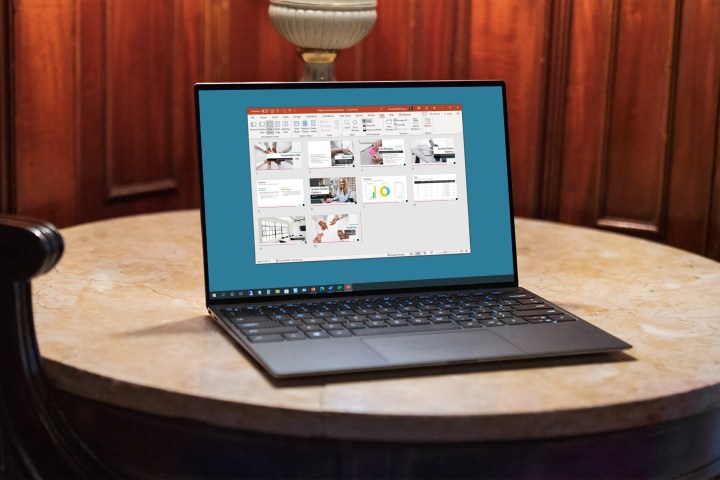
Powerpoint presentations are a great way to share information with a team, but making them is a skillset in its own right. We've got guides on general Powerpoint use , but if you're keen to just get started making a slideshow right now, this is the way.
How to create a Powerpoint presentation
How to build your first slide, how to add more slides to a powerpoint presentation, how to make an awesome slideshow presentation.
Here's how to make a Powerpoint presentation.
What You Need
Powerpoint or Microsoft 365 subscription
The first step in building your fancy slideshow is to create the presentation itself. Here's how to do it.
Step 1: Install Powerpoint (as part of Microsoft 365 ) if you haven't already, then open the app up.
Step 2: The home screen will give you a range of options for selecting templates and premade presentations to give you a great starting-off point. Select one of them if they're applicable. For even more options, select the New tab from the left-hand menu.
Alternatively, if you want to start from a blank canvas, select Blank presentation.
Step 3: From there, it's a good idea to name and save the presentation so you can come back to it later. Select File > Save or* Save As*, then name the file on the right, choose a location for it, and select Save .
Step 1: Your first slide will automatically have text fields for a title and subtitle. If you want to have that on your first slide, select them, then type in what you want them to read. You can also click and drag them around, or resize them using your mouse.
Hover your mouse over the white circles, then click and drag them to resize the box. Alternatively, select the rotational arrows near the corners of the box, to rotate it.
If you don't want those text fields, select their boundary individually and press the Delete key to remove them.
Step 2: If you want to add more text to this slide (or any others in the future), select the Insert tab, then select Text box. Click on the slide where you want the box to appear, then use your mouse to drag the box to the desired shape.
Then click the box and type in what you want that text box to say. The contextual home menu will automatically adjust to give you quick access to font choices and other text style options.
You can access more detailed text formatting options by selecting the Format tab. There you'll find options for changing text coloring, its outline, and any text effects you want to use.
Step 3: To add pictures to your slideshow, select the Insert tab, then select Pictures in the top-left. You'll then have the option to insert an image from your local PC, a selection of stock images, or a range of online images.
Step 4: You can also freehand draw or annotate your slides, using the Draw tab, or alter the entire theme of the slideshow by selecting Design.
To add a new slide to your presentation, select the Insert tab at the top of the screen, then select New slide on the left. Then choose the type of slide you want. You can have a blank slide to do it all yourself, or you can get a headstart on its design by copying a previous slide, using the same theme as another part of your presentation, or having a predefined layout.
Want even more tips on making a great slideshow? We've got you covered. Check out our guide on how to use Microsoft Powerpoint , for all the most important tips.
We've also got a guide for more tips and tricks for making engaging and attractive slides .
Editors’ Recommendations
- The best PowerPoint templates
- How to change the background in Powerpoint
- 5 ways to add music to PowerPoint
- How to print a PowerPoint presentation with notes
- How to convert PDF to PowerPoint
- How-To Guides

While PowerPoint is widely used to develop presentations, using Google Slides has become a popular alternative. Part of what makes it so popular is that it's free to use, as is other Google software such as Google Docs and Google Sheets – which is a stark contrast to the premium price you'll pay for Microsoft Office and PowerPoint.
Even if you know how to use Microsoft PowerPoint, you might want to jump ship to Slides, and Google makes it easy to do so. In fact, it takes little more than a few clicks to convert a PowerPoint to Google Slides. Whether you need to change the format for a coworker or want to permanently switch to the free platform, here's a look at how to convert your PowerPoint into a Google Slides presentation.
We all know that Microsoft’s PowerPoint software has been a presentations staple for a few decades now. And whether you only used it in school once or twice, or you use it for work on a daily basis, there’s always something new to learn about the classic Microsoft platform.
Even if you know how to use PowerPoint, did you know that you can embed videos in your presentations?
Creating a successful slideshow is no small task. So, if you’re new to Microsoft PowerPoint, you’ll need to familiarize yourself with the features and tools you need to build a presentation.
We’ll guide you through the process of creating a PowerPoint slideshow by adding slides and elements as well as how to present the show when you finish. These basics are just what you need as a beginner and should get you off to a terrific start with PowerPoint.
How to Write a Presentation, Speech, or Script
It may seem difficult at first—perhaps you're getting caught up in what vocabulary to use, or maybe you're having trouble organizing your thoughts.

Writing a presentation, speech or script can be a daunting task, but it doesn't have to be. The key to successful writing is to start with a clear plan.
Begin by outlining your main points and the order in which you would like to present them. Once you have a plan, you can start to fill in the details. Research your topic and make sure you have a good understanding of the material you are presenting.
When writing the speech or script, use simple language and avoid jargon. Make sure to include relevant facts and statistics to support your points. Finally, practice your presentation or speech several times to ensure that you are comfortable with the material and can deliver it in a confident and engaging manner. With a bit of preparation and practice, you can write an effective presentation, speech or script.
In this article, we will provide tips on how to write a presentation, speech, or script that will help you present, persuade and succeed using the best writing assistant software , ParagraphAI.
What is a Presentation?
A presentation is a form of communication in which a speaker presents information to an audience. They help share ideas, explain concepts, or to persuade the audience to take action. Presentations take place in person, through video conferencing, or through other digital media. Oftentimes, presentations are used in business settings, such as meetings or conferences, but are also present in educational settings, such as lectures or seminars.
Presentations inform, educate, or entertain an audience, depending on the purpose of the presentation. Formats include slideshows, videos, and even interactive experiences. Regardless of the format, a successful presentation requires careful planning and preparation, as well as strong communication skills.
What Should a Presentation Speech Include?
Every presentation can be divided into three segments: the opening, the main content, and the closing. Approximately 10-15% of your speaking time is typically spent on the introduction, around 75% on the body, and the remaining 10% on the conclusion.
The body of the presentation should contain facts and evidence to support the main points, and should be presented in a logical and easy-to-follow manner. The presentation should also include visuals, such as images, graphs, and charts, to help illustrate the points being made.
Finally, the presentation should end with a strong conclusion that summarizes the main points and leaves the audience with a lasting impression. With these elements in place, a winning presentation will be sure to capture the attention of the audience and leave them with a positive impression.
How to Write a Presentation
- Keep slide text concise.
- Focus on a single idea per slide.
- Use straightforward language.
- Incorporate impactful visuals.
- Tailor your writing to your audience.
- Avoid using slides as your personal notes.
Writing a presentation script can be a daunting task, but it doesn't have to be. Start by gathering the information you want to present. This could include facts, figures, quotes, and stories. Once you have your information, create an outline of your presentation. This should include the main points you want to make and the order in which you want to make them. Then, write the actual script. Make sure to include an introduction, body, and conclusion.
Your introduction should capture the audience's attention and set the tone for the presentation. The body should include the main points you outlined, and the conclusion should summarize the main points and provide a call to action. Finally, practice your presentation until you are comfortable with the material. Following these steps will help you create a successful presentation script.
How to Write a Presentation, Speech, or Script with ParagraphAI in One Easy Step
ParagraphAI is a free AI writing tool that crafts perfectly curated content for all your writing needs, from social media posts and blog articles to presentations and professional works. In one easy step, enter your topic and watch as ParagraphAI takes care of the rest. It will generate high-quality, well-researched, and plagiarism-free content tailored to your specific audience. ParagraphAI is available as an app and a browser extension.
Example 1: Write a speech about AI writers impact on sales presentations

If someone is writing a speech about AI writers impact on sales presentations they should start with an Outline. From there generate content for each individual point.
ParagraphAI can generate a presentation outline and script about any topic that the writer can use as a starting point for their blog post.
Using the app, you could even just put in some ideas to save the text for later if you don't have the time to write a whole product description yet.
Example 1 Continued: Write a speech about AI writers impact on sales presentations
If you are writing a speech and are unsure where to start, you can instantly generate it with our AI writer.
In this example we did not create an outline, ParagraphAI has written the following speech with the prompt "Write a speech about AI writers impact on sales presentations"...
"Good morning everyone. I am here today to talk to you about the impact of AI writers on sales presentations. AI writers are a powerful tool that can help sales teams create more effective and persuasive presentations. AI writers are able to analyze data, identify trends, and generate persuasive arguments. This means that sales teams can create presentations that are tailored to their audience and that are more likely to be successful. AI writers can also help to save time, as they can quickly generate content that is tailored to a specific audience. They are becoming increasingly popular, and their impact on sales presentations is undeniable. AI writers can help sales teams create more effective presentations that are tailored to their audience and that are more likely to be successful. Thank you."
Example 2: Write a treatment for the next Terminator movie

Imagine you want to write a movie treatment, simply describe your plot, characters and details or use similar movies to instantly generate new inspiration and let ParagraphAI's free AI writing assistant write it for you.
Here is the result for the prompt: "write a treatment for the next terminator movie":
"The Terminator franchise is one of the most iconic and beloved science fiction franchises of all time. After the success of the first two films, fans have been eagerly awaiting the next installment. With the release of Terminator: Dark Fate, the story of Sarah Connor, John Connor, and the Terminators has been given a new lease of life.
The next installment in the Terminator franchise should focus on the next generation of Terminators. The story should follow a group of young Terminators who have been sent back in time to protect the future from a new, more powerful enemy. These Terminators should be equipped with advanced technology and weaponry, and their mission should be to find and eliminate the enemy. Along the way, they should be forced to confront their own morality and the consequences of their actions.
The movie should also feature a new cast of characters, including a young Sarah Connor and John Connor. These characters should be more complex and nuanced than their predecessors, and their interactions with the Terminators should be a source of tension and drama. The story should also explore the implications of the technology used by the Terminators, and the ethical dilemmas posed by their mission. Ultimately, the movie should be an exciting and thought-provoking exploration of the Terminator universe."
Example 4: Write the script for the first scene of the above movie

Say you want to write a script and dont know where to start, here is the result for the prompt "Write the script for the first scene of the following movie: [enter movie treatment from above]":
"Script for the First Scene:
The scene opens on a dark, post-apocalyptic landscape. We see a group of Terminators, their faces illuminated by the light of the moon. They are walking in a single line, their weapons drawn and ready for battle. Suddenly, they stop and turn to face the camera.
The leader of the Terminators steps forward and speaks in a robotic voice. "We have been sent back in time to protect the future from a powerful enemy. Our mission is to find and eliminate this enemy, no matter the cost."
The Terminators turn and continue their march, their determination evident in their faces."
And you can adjust the tone sliders and improve your final work to meet your needs - who knows, AI may be used to write the script for the next AI based Terminator movie!
As you can see, ParagraphAI is a versatile assistant when it comes to generating text, regardless of if you are writing for a professional or casual setting.
Best of all, ParagraphAI is a free AI writer tool . Give it a try the next time you're figuring out how to write a presentation, speech, or script. It's amazing how easy and fun it is!
Our AI writing assistant software, AI writing app, and AI keyboard are built with love.
- Product overview
- On your phone
- AI keyboard
- In your browser
- Case studies
- ESL AI writer
- AI translations
- AI writing tool for dyslexia
- Corporation
- Become an affiliate
Popular guides
- Write an article
- Write a presentation
- Write an email
- Write a message
- Write paragraphs
- Write website content
- Terms of service
- Chrome privacy
- [email protected]

- School Life
Best Anchoring Script for Teacher’s Day 2024 for School Performance
Anchoring script for teachers’ day in school: get here the best, funny, and engaging anchoring script ideas for teachers’ day assemblies in school. know what questions can be asked from teachers and students during the activities to make it more touching. you can download the script in pdf format for easy understanding. read the complete script suggestions and give the special school assembly a smoother presentation..

Best Anchoring Script for Teachers’ Day: India celebrates September 5 as Teacher’s Day to mark the birthday of Dr. Sarvepalli Radhakrishnan, a prominent Indian philosopher, statesman, and the 2nd President of India. This day is special for the student-teacher bond. On this day, students recognise the efforts of their teachers and organise activities to make them feel happy and special. The day starts with a special assembly for Teachers’ Day that includes speeches, poems, and activities for teachers to participate in. Check out the anchoring script ideas for Teachers’ Day celebrations here. Make your script more interactive by adding engaging questions for teachers and students during the Teachers’ Day activities.
- Teachers' Day Song Suggestions
- Teacher's Day 2024 Quiz in Hindi
Why Teachers' Day is Celebrated on Dr Sarvepalli Radhakrishnan Birthday?
How to make the best anchoring script.
Anchoring Script For Teacher’s Day 2024 in School
| Good morning, respected teachers, dear students, and esteemed guests! A very warm welcome to our Teachers’ Day celebration. Today is a special day where we gather to express our heartfelt gratitude to our teachers, who guide us, inspire us, and shape our future. That’s right! Teachers are like candles—they light our path and help us grow in knowledge and wisdom. We have a lot of exciting performances and activities planned today, all dedicated to our beloved teachers. So, let’s begin this celebration with a positive start. To start our day, let’s seek blessings from the Almighty. I request everyone to join their hands and close their eyes for a prayer. [Lead the prayer or invite someone to recite it.] Thank you for the beautiful prayer. Now, let’s welcome our principal [Principal’s Name] to say a few words on this special occasion. [Principal gives the welcome speech.] Thank you, [Principal’s Name], for those inspiring words. Your guidance is always a beacon of light for all of us. And now, let’s get ready for some fun! We have prepared some wonderful performances to show how much we appreciate our teachers. First up, we have a group of students who have prepared a dance performance. Please welcome them with a big round of applause! [Introducing the dance performance.] That was an amazing performance! I’m sure our teachers enjoyed it. Next, we have a melodious song dedicated to our teachers, sung by [Student’s Name]. Let’s listen and feel the love and respect we have for our teachers. [Introduce the song.] Wow! That was such a touching song. Music truly has the power to express our deepest feelings. Now, we have some students who want to share their thoughts about their favourite teachers. Let’s welcome [Student’s Name] to share their experience. [Introduce the student for the speech.] Thank you, [Student’s Name], for those lovely words. I’m sure your teacher must be so proud of you. Let’s hear from another student, [Student’s Name], who also wants to share their story. [Introduce the next student.] To add more fun to our celebration, we’ve planned a few games for our teachers. We invite [Teacher’s Name] and [Teacher’s Name] to join us on stage for a quick game of [Game Name]. Let’s see how well our teachers can do! [Describe the game and lead the activity.] That was so much fun! It’s great to see our teachers enjoying themselves and showing us their playful side. Now, it’s time to honour our teachers. We have a small token of appreciation for all your hard work and dedication. We would like to invite [Teacher’s Name] on stage to receive a special gift from our students. [Invite teachers one by one and present them with gifts.] As we come to the end of our celebration, we would like to thank everyone who made this event possible. A big thank you to our teachers for everything you do, to our students for your wonderful performances, and to everyone who helped organize this event. Yes, thank you all! Let’s remember that Teachers’ Day is not just about celebrating today but about respecting and appreciating our teachers every day. We hope you enjoyed the program. Have a wonderful day ahead! |
| Good morning, everyone! A very happy Teachers’ Day to all our amazing teachers! Welcome to XYZ School’s special celebration. Today is the day we celebrate the superheroes of our school—our teachers! Yes, you heard that right—superheroes! They may not wear capes, but they definitely have superpowers. Who else can explain algebra and keep a straight face while we all look confused? That’s true! And who else can survive a whole day of teaching us with a smile on their face? They deserve more than just one day of appreciation! But before we get carried away with our jokes, let’s start this celebration with a prayer. It’s always good to have a little divine help when you’re trying to make your teachers laugh. [Lead the prayer or invite someone to recite it.] Now that we’re all feeling blessed and ready, let’s welcome our principal, [Principal’s Name], to say a few words. Just a heads-up, Principal Sir/Ma'am, we’re all ears, but if you start talking about homework, we might just pretend we didn’t hear you! [Principal gives the welcome speech.] Thank you, [Principal’s Name]! We promise to do our homework… at least some of the time. Alright, let’s get the fun started! First up, we have a group of students who have prepared a dance performance that’s guaranteed to make you smile. We’ve been practicing so hard that even the floor is tired of our dance moves. Please give them a big round of applause! [Introduce the dance performance.] That was fantastic! If dancing was a subject, I think we all just got an A+… except maybe [Student’s Name], who still needs to work on their rhythm. Just kidding, you were great! Next, we have a comedy skit that shows what happens when students think they know more than their teachers. Spoiler alert: It doesn’t end well for the students! Get ready to laugh out loud. [Introduce the skit.] That skit was hilarious! It’s a good reminder that our teachers always know best, especially when it comes to catching us with last-minute excuses. Now, let’s hear from some of our fellow students who want to share their funniest experiences with their teachers. First up, we have [Student’s Name]. [Introduce the student for the speech.] Thank you, [Student’s Name], for that funny story. I think we can all relate to forgetting our homework… and then trying to come up with a creative excuse! Let’s hear from another student, [Student’s Name], who has a funny memory to share. [Introduce the next student.] To keep the fun going, we’ve planned a game that’s sure to bring out the competitive side of our teachers. We invite [Teacher’s Name] and [Teacher’s Name] to join us on stage for a quick game of “Guess the Student’s Excuse!” Let’s see if our teachers can guess the excuses we come up with for not doing our homework. [Describe the game and lead the activity.] That was so much fun! I think we just found out that our teachers have heard every excuse in the book! Now, it’s time to honour our teachers. We may joke around a lot, but we truly appreciate everything you do for us. We have a small token of appreciation for each of you. Please come on stage to receive your gifts. [Invite teachers one by one and present them with gifts.] As we come to the end of our celebration, we want to thank everyone who made this day possible. A big thank you to our teachers for putting up with our jokes and for being the best role models we could ask for. Yes, thank you to all the students, teachers, and organisers who helped make today so much fun. And remember, teachers, if you ever need a good laugh, just think about some of the excuses we’ve given you! Have a wonderful Teachers’ Day, everyone! And remember, the homework excuse generator is officially retired—until tomorrow! |
| Good morning respected principal, dear teachers, honoured guests, and my fellow classmates! We are gathered here today to celebrate a special occasion that means a lot to all of us – Teacher’s Day. This day is all about showing our respect and gratitude to our teachers, who guide and support us every day. Teacher’s Day is celebrated on the birthday of Dr. Sarvepalli Radhakrishnan, a great scholar and the former President of India. This day reminds us of the value of education and the vital role teachers play in shaping our society. It’s a chance for us to say a big thank you to our teachers for their hard work and dedication in helping us learn and grow. To make our celebration even more fun, we have prepared some exciting performances that showcase the talents and creativity of our students. Get ready to enjoy dances, songs, skits, and other amazing acts that will make this day special for everyone. We also have a special session planned where a few students will share their favourite memories and stories about their teachers. It’s always heartwarming to hear how teachers have made a difference in our lives, both in and out of the classroom. Our teachers do much more than teach us subjects; they teach us important life lessons. They help us understand values, ethics, and morals that guide us as we grow up. On this day, let’s take a moment to think about the valuable lessons we’ve learned from our teachers and how they’ve helped shape the people we are today. To show our appreciation, we have prepared small gifts for our teachers. These gifts are not just things; they represent our respect and admiration for everything our teachers do. As we end this celebration, let’s remember that every day is a chance to learn, and our teachers are always there to guide us. Let’s carry the wisdom and knowledge they give us not just in school, but throughout our lives. |
|
|
Questions You Can Add To Anchoring Script on Teachers’ Day
1. for teachers:.
- "Can you share one memorable experience from your teaching journey that has stayed with you over the years?"
- "What inspired you to become a teacher, and what keeps you motivated every day?"
- "If you could give one piece of advice to your students, what would it be?"
2. For Students:
- "Can you describe a moment when a teacher helped you overcome a challenge?"
- "Which teacher has had the biggest impact on your life, and why?"
- "What is one lesson from a teacher that you will never forget?"
3. General Questions:
- "What do you think makes a teacher great?"
- "If you were a teacher for a day, how would you teach your favourite subject?"
- "What is the most fun activity you have done in class with your teacher?"
4. For a Fun Segment:
- "If you had to give your teacher a fun award, what would it be?" (e.g., “Best Storyteller” or “Most Likely to Crack Jokes”)
- "What is one funny or unexpected thing a teacher has said or done in class?"
- "If your teacher were a superhero, what would their superpower be?"
These questions can add a personal and interactive touch to the event, encouraging both teachers and students to share their experiences and thoughts.
- Teachers’ Day Celebration School Assembly Ideas
- Teacher’s Day Quiz
- Top 5 Classroom Decoration Ideas with Images
- Teachers Day Drawing Ideas for School Students
- Teacher’s Day Speech in English
- 10 Lines on Dr Sarvepalli Radhakrishnan
- Teacher's Day Song Suggestions for School Performance (2024)
- 10 Best Teacher’s Day 2024 Poems in English
- शिक्षक दिवस पर पढ़ें कविताएँ और दोहे
- Teacher’s Day Essay 2024
- 45+ Teacher's Day Thoughts And Best Quotes By Students To Their Favourite Educator!
- Teacher's Day Card Ideas 2024: Easy and Creative Handmade Greeting Card Designs For Kids and Students!
Get here latest School , CBSE and Govt Jobs notification and articles in English and Hindi for Sarkari Naukari , Sarkari Result and Exam Preparation . Download the Jagran Josh Sarkari Naukri App .
- What should be included in an anchoring script for Teachers’ Day? + A typical anchoring script for Teachers’ Day includes a welcome address, introductions of guests and performers, announcements, and a closing speech.
- Who is Teachers' Day celebrated in honour of? + Teachers' Day is celebrated in honour of Dr. Sarvepalli Radhakrishnan, a prominent Indian philosopher, statesman, and former President of India.
- How can I celebrate Teachers' Day? + You can express your gratitude to your teachers through cards, gifts, or heartfelt messages. Schools often organise special events and programs to honour their teachers.
- What are some ways to make Teachers' Day memorable? + You can organise a surprise party for your teacher, write a poem or song, or simply spend quality time with them.
- UGC NET Answer Key 2024
- TNPSC Group 2 Hall Ticket 2024
- RBI Grade B Admit Card 2024
- SSC GD Recruitment 2025
- SSC CGL Admit Card 2024
- UP Police Constable Question Paper 2024 PDF
- CDS Question Paper 2024
- RRB NTPC Recruitment 2024
- Teachers Day Speech
- Teachers Day 2024
- Education News
Latest Education News
Haryana Congress Candidates List: कांग्रेस उम्मीदवारों की पहली और दूसरी लिस्ट जारी, यहां देखें सभी के नाम
Jasdeep Singh Gill Story: कौन हैं जसदीप सिंह गिल? केमिकल इंजीनियर से धार्मिक गुरु बनने तक की कहानी
Haryana BJP Candidate List 2024: 67 उम्मीदवारों की पहली लिस्ट जारी, यहां देखें सभी के नाम
India vs Bangladesh: ऋषभ पंत और राहुल के साथ टीम में किसे मिला मौका, कौन हुआ बाहर, देखें यहां
People with an IQ above 130 only can find the odd camel in the picture in 5 seconds!
Top 10 Cities in the World for Studying Abroad
Brain Teaser: Think You're a High IQ Individual? Solve This Math Puzzle to Prove It!
Unified Pension Scheme: लाभ, पात्रता, न्यूनतम पेंशन राशि, पेंशन कैलकुलेटर सहित सभी डिटेल्स यहां देखें
Ayushman Card: सिर्फ़ मिनटों में स्मार्टफ़ोन से घर बैठे बनाएं आयुष्मान कार्ड, जानें पूरी प्रक्रिया
Weekly Current Affairs Quiz (02-08 Sept 2024): Boost Your Exam Score With Top Insights!
UPSC Current Affairs Quiz 06 September 2024- Paris Paralympics 2024
Weekly Current Affairs Quiz Hindi: 02 सितंबर 08 सितंबर 2024
Top 10 Weekly Current Affairs in Hindi: 02 सितंबर से 08 सितंबर 2024
Picture Puzzle IQ Test: Find the word “rug” in the living room in 5 seconds!
Optical Illusion: What you see first reveals whether you are carefree or thoughtful
Who is Nandan Nilekani? Chairman and Co-Founder of Infosys ranked in the ‘TIME100 Al’ List
What is the Difference between an Isthmus and a Strait?
Today’s School Assembly News Headlines (9th September): Heavy Rain: Orange Warning to Several Districts of Andhra, Telangana, India US Exchange Quad Chairmanship and More
International Literacy Day Drawings Ideas for Poster, Painting and Banner
GSSSB CCE Clerk Syllabus 2024 PDF Download Link, Check Exam Pattern

IMAGES
VIDEO
COMMENTS
This is where presenter notes come in handy, and in this section, we'll learn how to turn the presentation script into presenter notes. The first step in this process is to go through the detailed script a couple of times, highlighting the main ideas, data, and messages to convey to the audience. You can follow the process as with meeting ...
Learn how to write a presentation script that is not a word-for-word document and how to practice your presentation in different ways. This article is for academics, scientists, and educators who want to create engaging presentations.
Learn how to write a presentation with clear and engaging introduction, well-structured content, compelling visuals, and engaging delivery. Follow the step-by-step guide with examples and tips for different presentation formats and purposes.
Learn four tips to craft a compelling script for your presentation, such as planning ahead, syncing with slides, adding pauses, and practicing diligently. Find out how to use storyboarding, delivery, and design elements to create a smooth and engaging presentation.
Learn the top 10 tips on how to write a script for a presentation, from storyboarding and KISS rule to pauses and calls to action. See examples of detailed and key point scripts and get professional help from SlidePeak.
Learn expert tips and techniques to craft a compelling script that resonates with your audience and enhances your message. Explore the key elements of a presentation script, such as clear objective, audience-centric approach, strong narrative, emotional engagement, and simplicity.
FREE TRAINING: https://bit.ly/mtp-script-and-practice-freetraining"Should I write a script for my presentation?" is one of the most common questions I see on...
Learn how to plan, write and deliver a presentation that engages your audience, even via Zoom. This comprehensive guide covers the basics of audience, objective, structure, content and design.
Learn how to write a script for a presentation that matches the content, flows naturally and connects with the audience. Follow the tips on storyboarding, slide content, pause breaks, practice and delivery.
Learn how to write a presentation script with AhaSlides, a tool that helps you create interactive and dynamic presentations. Find tips, examples, and a template for a presentation script on unlocking the secret formula of giving great feedback.
Learn the benefits and methods of using a presentation script to deliver a captivating story. Find out how to write, edit and use a script for different types of presentations and audiences.
A presentation script include details about your key talking points, cues for visual aids such as slides or props, and a structured outline to guide your session. In this section, we'll explore how you can script and practice your presentation to help you organize your ideas, create a logical flow in your argument, and avoid unnecessary details.
In a previous video, I talked about how to create epic content for your presentations. In this video, I'm going to follow that up and teach you three script ...
Learn how to use a presentation script to prepare and practice your content, performance, slide design and practice for a high-value spotlight moment. Follow the steps to reduce your script to bullet phrases, use index cards, record and review your pitch, and structure your content with a mountain.
4. Use stories & anecdotes for engagement. While you write your presentation script, don't forget to spice up your script with a few anecdotes, attention-grabbing facts, and good old-fashioned business storytelling! These elements can help engage your audience and keep them hooked throughout your presentation.
Learn how to write a presentation script with these free resources and examples. Find out how to structure your script, use visual aids, and engage your audience with voice over services.
How to Write a Perfect Pitch Script (Comprehensive Guide)
Writing a presentation script can be a daunting task, but it doesn't have to be. Start by gathering the information you want to present. This could include facts, figures, quotes, and stories. Once you have your information, create an outline of your presentation. This should include the main points you want to make and the order in which you ...
Learn how to write a presentation with clear structure, language and flow. Find tips on using stories, slides, hooks and editing to make your presentation effective and memorable.
In any presentation, a well-written script plays a crucial role. It helps capture the audience's attention and deliver a memorable message. A strong script enables you to articulate your ideas clearly, structure your content effectively, and engage your audience from start to finish. A presentation script also boosts your confidence as a speaker.
Summary. Knowing a script or presentation cold means taking the time to craft the words and sequence of what you plan to say, and then rehearsing them until you could recite them backwards if ...
This web page provides a script for a half-day to full-day presentation on how to make library resources accessible to people with disabilities. It covers topics such as success stories, legal issues, statistics, general library access, adaptive technology, and electronic resources.
To add a new slide to your presentation, select the Insert tab at the top of the screen, then select New slide on the left. Then choose the type of slide you want. Then choose the type of slide ...
4. Script: Not all skits need a fully fleshed-out script. (And they can be a great place to test out your improv skills.) However, depending on the complexity of your idea, it might be good to put ...
Writing a script for a voice-over is different from writing text that's meant to be read on-screen or paper. When you're writing for the ear, you need to consider how the words will sound when spoken aloud. One key aspect is natural language flow. Spoken language is often more relaxed and conversational than written language, with shorter ...
Start by gathering the information you want to present. This could include facts, figures, quotes, and stories. Once you have your information, create an outline of your presentation. This should include the main points you want to make and the order in which you want to make them. Then, write the actual script.
Questions You Can Add To Anchoring Script on Teachers' Day Here are some questions you can add to an anchoring script for Teachers' Day to engage the audience and make the event more interactive: 1.